From Wikipedia:
Lockheed A-12 [Article 12, Archangel 12]
From Wikipedia, the free encyclopedia
(Not to be confused with McDonnell Douglas A-12 Avenger II.)
A-12

An A-12 aircraft (Serial Number 06932)
Role: High-altitude reconnaissance aircraft
Manufacturer: Lockheed Corporation
First flight: 25 April 1962
Introduced: 1967
Retired: 1968
Status: Retired
Primary user: Central Intelligence Agency
Number built: A-12: 13; M-21: 2
Variants: Lockheed YF-12
Developed into: Lockheed SR-71 Blackbird
The Lockheed A-12 was a reconnaissance aircraft built for the Central Intelligence Agency by Lockheed's famed Skunk Works, based on the designs of Clarence "Kelly" Johnson. The A-12 was produced from 1962 through 1964, and was in operation from 1963 until 1968. The single-seat design, which first flew in April 1962, was the precursor to both the twin-seat U.S. Air Force YF-12 interceptor and the famous SR-71 Blackbird reconnaissance aircraft. The final A-12 mission was flown in May 1968, and the program and aircraft retired in June of that year.
Design and development
With the failure of the CIA's Project Rainbow to reduce the radar cross section of the U-2, preliminary work began inside Lockheed in late 1957 to develop a follow-on aircraft to overfly the Soviet Union. The designs were nicknamed "Archangel", after the U-2 program, which had been known as "Angel". As the aircraft designs evolved and configuration changes occurred, the internal Lockheed designation changed from Archangel-1 to Archangel-2, and so on. These nicknames for the evolving designs soon simply became known as "A-1", "A-2", etc.[1]
These designs had reached the A-11 stage when the program was reviewed. The A-11 was competing against a Convair proposal called Kingfish, of roughly similar performance. However, the Kingfish included a number of features that greatly reduced its radar cross section, which was seen as favorable to the board. Lockheed responded with a simple update of the A-11, adding twin canted fins instead of a single right-angle one, and adding a number of areas of non-metallic materials. This became the A-12 design. On 26 January 1960, the CIA ordered 12 A-12 aircraft. After selection by the CIA, further design and production of the A-12 took place under the code-name Oxcart.

A-12 during radar testing – mounted inverted.
After development and production at the Skunk Works, in Burbank, California, the first A-12 was transferred to Groom Lake test facility, where on 26 April 1962, Lockheed test pilot Lou Schalk took the A-12 on its shakedown flight. Many internal documents and references to individual aircraft used Johnson's preferred designation, using the prefix, "the Article" for the specific examples. Thus on the A-12's first flight, the subject aircraft was identified as "Article 121". The first official flight occurred on 30 April.[2] On its first supersonic flight, in early May 1962, the A-12 reached speeds of Mach 1.1.
The first five A-12s, in 1962, were initially flown with Pratt & Whitney J75 engines capable of 17,000 lbf (76 kN) thrust each, enabling the J75-equipped A-12s to obtain speeds of approximately Mach 2.0. On 5 October 1962, with the newly developed J58 engines, the A-12 flew with one J75 engine, and one J58 engine. By early 1963, the A-12 was flying with J58 engines, and during 1963 these J58-equipped A-12s obtained speeds of Mach 3.2. Also, in 1963, the program experienced its first loss when, on 24 May, "Article 123"[3] piloted by Kenneth S. Collins crashed near Wendover, Utah.
The reaction to the crash illustrated the secrecy over, and importance of, the project. The CIA called the aircraft an F-105 as a cover story;[4] local law enforcement and a passing family were warned with "dire consequences" to keep quiet about the crash.[3] Each was also paid $25,000 in cash ($179,335 today[5]) to do so; the project often used such cash payments to avoid outside enquiries into its operations.[3] The project received ample funding; contracted security guards were paid $1,000 monthly ($7,173 today[5]) with free housing on base, and chefs from Las Vegas were available 24 hours a day for steak, Maine lobster, or other requests.[3]
In June 1964, the last A-12 was delivered to Groom Lake,[6] from where the fleet made a total of 2,850 test flights.[4] A total of 18 aircraft were built through the program's production run. Of these, 13 were A-12s, three were prototype YF-12A interceptors for the Air Force (not funded under the OXCART program), and two were M-21 reconnaissance drone carriers. One of the 13 A-12s was a dedicated trainer aircraft with a second seat, located behind the pilot and raised to permit the Instructor Pilot to see forward. The A-12 trainer "Titanium Goose", retained the J75 powerplants for its entire service life.[7]
Operational history
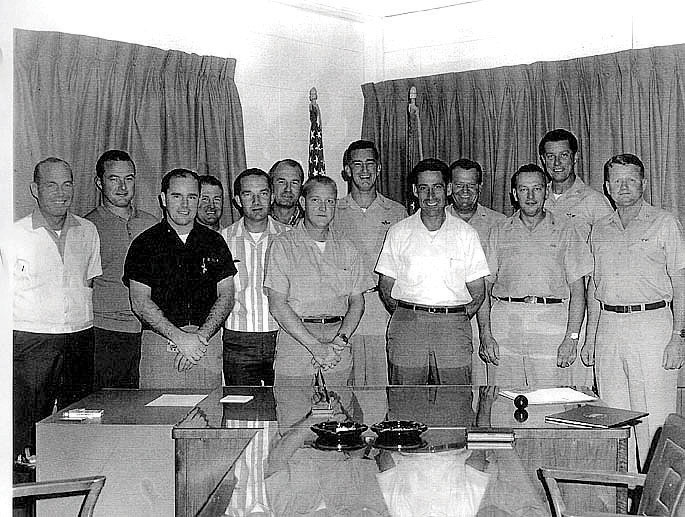
A-12 pilots and managers: (l. to r.) Ronald J. “Jack” Layton, Dennis B. Sullivan, Mele Vojvodich Jr, Barrett, Jack W. Weeks, Kenneth B. Collins, Ray, Brig Gen Ledford, Skliar, Perkins, Holbury, Kelly, and squadron commander Col Slater
Although originally designed to succeed the U-2 in overflights over the Soviet Union and Cuba, the A-12 was never used for either role. After a U-2 was shot down in May 1960, the Soviet Union was considered too dangerous except in an emergency (and overflights were no longer necessary[8] due to satellites) and, although crews trained for the role, U-2s remained adequate for Cuba.[9]
After lengthy debate, the CIA decided to deploy the A-12s to Asia. The first A-12 arrived at Kadena Air Base, Okinawa, Japan, on 22 May 1967. With the arrival of two more aircraft (24 May, and 27 May) the unit was declared operational on 30 May, and began Operation Black Shield on 31 May.[10] Mel Vojvodich flew the first Black Shield operation, over North Vietnam, photographing Surface-to-air missile (SAM) sites, flying at 80,000 ft (24,000 m), and at Mach 3.1. From Kadena, during 1967, the A-12s conducted 22 operations in support of the Vietnam War. During 1968, Black Shield conducted operations in Vietnam and also supported the Pueblo Crisis with North Korea. The operational use of the A-12 was nearly a decade after the original conception of the Oxcart program.
During its deployment on Okinawa, the A-12s (and later the SR-71) and by extension their pilots, were nicknamed Habu after a cobra-like Okinawan pit viper which the locals thought the plane resembled.
Retirement

A-12s in storage

Head-on view of an A-12 on the deck of the Intrepid Sea-Air-Space Museum, illustrating the chines
The A-12 program was officially canceled on 28 December 1966[11]—even before Black Shield began in 1967—due to budget concerns[12] and because of the forthcoming SR-71, which arrived in Kadena in March 1968.
Ronald L. Layton flew the 29th and final A-12 mission on 8 May 1968, over North Korea. On 4 June 1968, just 2½ weeks before the retirement of the entire A-12 fleet, an A-12 out of Kadena, piloted by Jack Weeks, was lost over the Pacific Ocean near the Philippines while conducting a functional check flight after the replacement of one of its engines.[12][13] Francis J. Murray took the final A-12 flight on 21 June 1968, to Palmdale, California.
On 26 June 1968, Vice Admiral Rufus L. Taylor, the Deputy Director of Central Intelligence, presented the CIA Intelligence Star for valor to Weeks' widow and pilots Collins, Layton, Murray, Vojvodich, and Dennis B. Sullivan for participation in Black Shield.[12][14][15]
The deployed A-12s and the eight non-deployed aircraft were placed in storage at Palmdale. All surviving aircraft remained there for nearly 20 years before being sent to museums around the United States. On 20 January 2007, despite protests by Minnesota's legislature and volunteers who had maintained it in display condition, the A-12 preserved in Minneapolis, Minnesota, was dismantled to ship to CIA Headquarters to be displayed there.[16]
Timeline
The following timeline describes the overlap of the development and operation of the A-12, and the evolution of its successor, the SR-71.
16 August 1956: Following Soviet protest of U-2 overflights, Richard M. Bissell, Jr. conducts the first meeting on reducing the radar cross section of the U-2. This evolves into Project Rainbow.
December 1957: Lockheed begins designing subsonic stealthy aircraft under what will become Project Gusto.
24 December 1957: First J-58 engine run.
21 April 1958: Kelly Johnson makes first notes on a Mach 3 aircraft, initially called the U-3, but eventually evolving into Archangel I.
November 1958: The Land panel provisionally selects Convair Fish (B-58-launched parasite) over Lockheed's A-3.
June 1959: The Land panel provisionally selects Lockheed A-11 over Convair Fish. Both companies instructed to re-design their aircraft.
14 September 1959: CIA awards antiradar study, aerodynamic structural tests, and engineering designs, selecting Lockheed's A-12 over rival Convair's Kingfish. Project Oxcart established.
26 January 1960: CIA orders 12 A-12 aircraft.
1 May 1960: Francis Gary Powers is shot down in a U-2 over the Soviet Union.
26 April 1962: First flight of A-12 with Lockheed test pilot Louis Schalk at Groom Lake.
13 June 1962: SR-71 mock-up reviewed by USAF.
30 July 1962: J58 engine completes pre-flight testing.
October 1962: A-12s first flown with J58 engines
28 December 1962: Lockheed signs contract to build six SR-71 aircraft.
January 1963: A-12 fleet operating with J58 engines
24 May 1963: Loss of first A-12 (#60–6926)
7 August 1963: First flight of the YF-12A with Lockheed test pilot James Eastham at Groom Lake.
June 1964: Last production A-12 delivered to Groom Lake.
25 July 1964: President Johnson makes public announcement of SR-71.
29 October 1964: SR-71 prototype (#61-7950) delivered to Palmdale.
22 December 1964: First flight of the SR-71 with Lockheed test pilot Bob Gilliland at AF Plant #42. First mated flight of the MD-21 with Lockheed test pilot Bill Park at Groom Lake.
28 December 1966: Decision to terminate A-12 program by June 1968.
31 May 1967: A-12s conduct Black Shield operations out of Kadena
3 November 1967: A-12 and SR-71 conduct a reconnaissance fly-off. Results were questionable.
23 January 1968: Seizure of USS Pueblo
5 February 1968: Lockheed ordered to destroy A-12, YF-12 and SR-71 tooling.
8 March 1968: First SR-71A (#61-7978) arrives at Kadena AB (OL 8) to replace A-12s.
21 March 1968: First SR-71 (#61-7976) operational mission flown from Kadena AB over Vietnam.
8 May 1968: Jack Layton flies last operational A-12 sortie, over North Korea.
5 June 1968: Loss of last A-12 (#60–6932)
21 June 1968: Final A-12 flight to Palmdale, California.
For the continuation of the Oxcart timeline, covering the duration of operational life for the SR-71, see SR-71 timeline.
Variants
Training variant

The only two-seat trainer A-12 built was nicknamed "Titanium Goose". It is on display at the California Science Center.
The A-12 training variant (60-692 "Titanium Goose") was a two-seat model with two cockpits set horizontally with the rear cockpit raised and slightly offset. In case of emergency, the trainer was designed to allow the flight instructor to take control. Other than the modifications required to accommodate the dual controls and new cockpit configuration, the trainer was very similar to A-12 in terms of appearance and performance.
YF-12A
Main article: Lockheed YF-12
The YF-12 program was a limited production variant of the A-12. Lockheed convinced the U.S. Air Force that an aircraft based on the A-12 would provide a less costly alternative to the recently canceled North American Aviation XF-108, since much of the design and development work on the YF-12 had already been done and paid for. Thus, in 1960 the Air Force agreed to take the seventh through ninth slots on the A-12 production line and have them completed in the YF-12A interceptor configuration.[17]
The main changes involved modifying the aircraft's nose to accommodate the Hughes AN/ASG-18 fire-control radar originally developed for the XF-108, and the addition of a second cockpit for a crew member to operate the fire control radar. The nose modifications changed the aircraft's aerodynamics enough to require ventral fins to be mounted under the fuselage and engine nacelles to maintain stability. Finally, bays previously used to house the A-12's reconnaissance equipment were converted to carry missiles.
M-21
See also: Lockheed D-21

A D-21B drone mounted on an M-21
One notable variant of the basic A-12 design was the M-21, used to carry and launch the Lockheed D-21 drone, an unmanned, faster and higher-flying reconnaissance craft. The M-21 was an A-12 platform modified by replacing the single-seat aircraft's Q bay (which carried its main camera) with a second cockpit for a Launch Control Operator/Officer (LCO). When mated to the drone for operations, this variant was known as the M/D-21. The D-21 drone was completely autonomous; having been launched it would overfly the target, travel to a predetermined rendezvous point and eject its data package. The package would be recovered in midair by a C-130 Hercules and the drone would self-destruct.
The program to develop this system was canceled in 1966 after a drone collided with the mother ship at launch, destroying the M-21. The crew survived the midair collision but the LCO drowned when he landed in the ocean and his flight suit filled with water.[18] The D-21 drone performed operational missions over China in 1970 and 1971. The modified D-21B drone was carried on wings of the B-52 bomber.
A-12 aircraft production and disposition
List of A-12s
Serial number
Model
Location or fate
60-6924
A-12
Air Force Flight Test Center Museum Annex, Blackbird Airpark, at Plant 42, Palmdale, California. 606924 was the first A-12 to fly.
60-6925
A-12
Intrepid Sea-Air-Space Museum, parked on the deck of the aircraft carrier USS Intrepid, New York City
60-6926
A-12
Lost, 24 May 1963
60-6927
A-12
California Science Center in Los Angeles, CA (Two-canopied trainer model, "Titanium Goose")
60-6928
A-12
Lost, 5 January 1967
60-6929
A-12
Lost, 28 December 1967
60-6930
A-12
U.S. Space and Rocket Center, Huntsville, Alabama
60-6931
A-12
CIA Headquarters, Langley, Virginia[N 1]
60-6932
A-12
Lost, 4 June 1968
60-6933
A-12
San Diego Aerospace Museum, Balboa Park, San Diego, California
60-6937
A-12
Southern Museum of Flight, Birmingham, Alabama
60-6938
A-12
Battleship Memorial Park (USS Alabama), Mobile, Alabama
60-6939
A-12
Lost, 9 July 1964
60-6940
M-21
Museum of Flight, Seattle, Washington
60-6941
M-21
Lost, 30 July 1966
See Lockheed YF-12 and Lockheed SR-71 Blackbird for other Blackbirds on display.
Specifications (A-12)
Data from A-12 Utility Flight Manual,[19] Pace[20]
General characteristics
Crew: 1 (2 for trainer variant)
Length: 101.6 ft (30.97 m)
Wingspan: 55.62 ft (16.95 m)
Height: 18.45 ft (5.62 m)
Wing area: 1,795 ft² (170 m²)
Empty weight: 54,600 lb (24,800 kg)
Loaded weight: 124,600 lb (56,500 kg)
Powerplant: 2 × Pratt & Whitney J58-1 continuous bleed-afterburning turbojets, 32,500 lbf (144 kN) each
Payload: 2,500 lb (1,100 kg) of reconnaissance sensors
Performance
Maximum speed: Mach 3.35 (2,210 mph, 3,560 km/h) at 75,000 ft (23,000 m)
Range: 2,200 nmi (2,500 mi, 4,000 km)
Service ceiling: 95,000 ft (29,000 m)
Rate of climb: 11,800 ft/min (60 m/s)
Wing loading: 65 lb/ft² (320 kg/m²)
Thrust/weight: 0.56
See also
Lockheed D-21
Related development
Lockheed YF-12
SR-71 Blackbird
Comparable aircraft
Convair Kingfish
References
Notes
1.^ "Article 128", unveiled on Wednesday, 19 September 2007, at CIA Headquarters in Langley, VA. On hand was Ken Collins, a retired Air Force Colonel, one of only six pilots to fly the A-12s.
Citations
1.^ "The U-2's Intended Successor: Project Oxcart 1956–1968". Central Intelligence Agency, approved for release by the CIA in October 1994. Retrieved: 26 January 2007.
2.^ "A-12 First Flight." Lockheed Martin. Retrieved: 13 October 2010.
3.^ a b c d Lacitis, Erik. "Area 51 vets break silence: Sorry, but no space aliens or UFOs." The Seattle Times, 27 March 2010.
4.^ a b Jacobsen, Annie. "The Road to Area 51." Los Angeles Times, 5 April 2009.
5.^ a b Consumer Price Index (estimate) 1800–2008. Federal Reserve Bank of Minneapolis. Retrieved December 7, 2010.
6.^ "SR-71 Blackbird." Lockheed Martin. Retrieved: 13 October 2010.
7.^ Landis and Jenkins 2005, p. 16.
8.^ McIninch 1996, p. 19.
9.^ McIninch 1996, p. 20.
10.^ McIninch 1996, pp. 25–27.
11.^ McIninch 1996, p. 31.
12.^ a b c Robarge, David. "A Futile Fight for Survival. Archangel: CIA's Supersonic A-12 Reconnaissance Aircraft." CSI Publications, 27 June 2007. Retrieved: 13 April 2009.
13.^ McIninch 1996, p. 33.
14.^ McIninch 1996, p. 34.
15.^ Hayden, General Michael V. "General Hayden's Remarks at A-12 Presentation Ceremony." Central Intelligence Agency, Remarks of Director of the Central Intelligence Agency at the A-12 Presentation Ceremony, 19 September 2007. Retrieved: 10 April 2009.
16.^ Karp, Jonathan. "Stealthy Maneuver: The CIA Captures An A-12 Blackbird". The Wall Street Journal, A1, 26 January 2007. Retrieved: 10 April 2009.
17.^ Landis and Jenkins 2005, pp. 40–41.
18.^ "MD-21 crash footage." YouTube. Retrieved: 13 October 2010.
19.^ "A-12 Utility Flight Manual (Copy 15, Version 15 September 1968)." CIA, 15 June 1968. Retrieved: 5 April 2010.
20.^ Pace 2004, pp. 105, 110.
Bibliography
Donald, David, ed. "Lockheed's Blackbirds: A-12, YF-12 and SR-71". Black Jets. Norwalk, CT: AIRtime, 2003. ISBN 1-880588-67-6.
Graham, Richard H. SR-71 Revealed: The Inside Story. St. Paul, Minnesota: MBI Publishing Company, 1996. ISBN 978-0-7603-0122-7.
Jenkins, Dennis R. Lockheed Secret Projects: Inside the Skunk Works. St. Paul, Minnesota: MBI Publishing Company, 2001. ISBN 978-0-7603-0914-8.
Johnson, C.L. Kelly: More Than My Share of it All. Washington, DC: Smithsonian Books, 1985. ISBN 0-87474-491-1.
Landis, Tony R. and Dennis R. Jenkins. Lockheed Blackbirds. Minneapolis, Minnesota: Specialty Press, revised edition, 2005. ISBN 1-58007-086-8.
Lovick, Edward, Jr. Radar Man: A Personal History of Stealth. Bloomington, IN: iUniverse, 2010. ISBN 978-1-45024-802-0.
McIninch, Thomas. "THE OXCART STORY" Center for the Study of Intelligence, Central Intelligence Agency, 2 July 1996. Retrieved 10 April 2009.
Merlin, Peter W. From Archangel to Senior Crown: Design and Development of the Blackbird (Library of Flight Series). Reston, Virginia: American Institute of Aeronautics and Astronautics (AIAA), 2008. ISBN 978-1-56347-933-5.
Pace, Steve. Lockheed SR-71 Blackbird. Swindon: Crowood Press, 2004. ISBN 1-86126-697-9.
Pedlow, Gregory W. and Donald E. Welzenbach. The Central Intelligence Agency and Overhead Reconnaissance: The U-2 and OXCART Programs, 1954 – 1974. Washington, DC: Central Intelligence Agency, 1992. ISBN 0-7881-8326-5.
Rich, Ben R. and Leo Janos. Skunk Works: A Personal Memoir of My years at Lockheed. New York: Little, Brown and Company, 1994. ISBN 0-316-7433.
Shul, Brian and Sheila Kathleen O'Grady. Sled Driver: Flying the World's Fastest Jet. Marysville, California: Gallery One, 1994. ISBN 0-929823-08-7.
Suhler, Paul A. From RAINBOW to GUSTO: Stealth and the Design of the Lockheed Blackbird (Library of Flight Series) . Reston, Virginia: American Institute of Aeronautics and Astronautics (AIAA), 2009. ISBN 978-1-60086-712-5.
From paperlessarchives.com:

OXCART aircraft on the ramp at Groom Lake Area 51 in 1964.
There are ten aircraft in the photo; the first eight are OXCART
machines, and the last two are Air Force YF-12As
HISTORY OF THE A-12
The U-2 dated from 1954. When its development began under the direction of a group headed by Richard M. Bissell of the CIA. Before the U-2 became operational in June 1956, CIA project officials had estimated that its life expectancy for flying safely over the Soviet Union would be between 18 months and two years. After overflights began and the Soviets demonstrated the capability of tracking and attempting to intercept the U-2, this estimate seemed too optimistic. By August 1956, Richard Bissell was so concerned about the U-2's vulnerability that he despaired of its ability to avoid destruction for six months, let alone two years. By the autumn of 1957, Bissell had collected so many ideas for a successor to the U-2, that Bissell asked the Director of Central Intelligence Allen Dulles for permission to establish an advisory committee, which became known as the Land Committee, to assist in the selection process. Bissell also felt that the support of a committee of prominent scientists and engineers would prove useful when it came time to ask for funding for such an expensive project.
The two most prominent firms involved in the search for a new aircraft were the Lockheed Corporation, which had designed the successful U-2, and Convair which was building the supersonic B-58 "Hustler" bomber for the Air force and also working on an even faster model known as the B-58B "Super Hustler". Early in 1958, Richard Bissell asked officials from both firms to submit designs for a high-speed reconnaissance aircraft. During the spring and summer of 1958, both firms worked on designs and concepts without government contracts or funds.
Following extended discussions with Bissell on the subject of a supersonic successor to the U-2, Lockheed's Kelly Johnson began designing an aircraft that would cruise at Mach 3.0 at altitudes above 90,000 feet. On 23 July 1958, Johnson presented his new high-speed concept to Land's advisory committee, which expressed interested in the approach he was taking. At the same meeting, Navy representatives presented a concept for a high-altitude reconnaissance vehicle that examined the possibility of developing a ramjet-powered, inflatable, rubber vehicle that would be lifted to altitude by a balloon and then be propelled by a rocket to a speed where the ramjets could produce thrust. Richard Bissell asked Johnson to evaluate this concept, and three weeks later, after receiving more details from the Navy representatives, Kelly Johnson made some quick calculations that showed that the design was impractical because the balloon would have to be a mile in diameter to lift the vehicle, which in turn would need a wing surface greater than one-seventh of an acre to carry the payload.
In September 1958, the Land committee met again to review all the concepts then under consideration and to narrow out the few that were most practicable. Among the concepts rejected were the Navy's proposal for an inflatable, ramjet-powered aircraft, a Boeing proposal for a 190-foot-long hydrogen-powered inflatable aircraft, and a Lockheed design for a hydrogen-powered aircraft (the CL-400). The committee examined two other Kelly Johnson designs at this meeting, a tailless subsonic aircraft with a very-low-radar cross section (the G2A) and a new supersonic design (the A-2) and did not accept either one, the former because of its slow speed and the latter because of it dependence on exotic fuels for its ramjets and it overall high cost. The committee approved the continuation of Convair's work on a ramjet-powered Mach 4.0 "parasite" aircraft that would be launched from a specially configured version of the B-58B bomber. The design was termed a parasite because it could not take off on its own but needed a larger aircraft to carry it aloft and accelerate it to the speed required to start the ramjet engine. The Convair design was called the FISH.
Two months later, after reviewing the Convair proposal and yet another Lockheed design for a high-speed reconnaissance aircraft (the A-3), the Land committee concluded in late November 1958 that it would indeed be feasible to build an aircraft whose speed and altitude would make radar tracking difficult or impossible. The committee, therefore, recommended that DCI Dulles ask President Eisenhower to approve further pursuit of the project and to provide fund for additional studies and tests.
On 17 December 1958, Allen Dulles and Richard Bissell briefed the President on the progress toward a successor to the U-2. Also present were Land and Purcell from the advisory committee, Presidential Service Advisor James Killian, and Air Force Secretary Donald Quarles. DCI Dulles reviewed the results to the U-2 missions to date and stated his belief that a successor to the U-2 could be used all over the world and "would have a much greater invulnerability to detection"
Bissell then described two competing projects by Lockheed and Convair, noting that the chief question at the moment was whether to use air launch or ground takeoff. The next phase, he added, would be detailed engineering, at the end of which it was proposed that 12 aircraft be ordered at a cost of about $100 million. With funding for the proposed new type of aircraft now available, Richard Bissell asked Lockheed and Convair to submit detailed proposals.
By the summer of 1959, both firms had completed their proposals. In early June, Lockheed submitted a design for the ground-launched aircraft known as the A-11. It would have a speed of Mach 3.2, a range of 3,200 miles, an altitude of 90,000 feet, and a completion date of January 1961. Kelly Johnson had refused to reduce the aerodynamics of his design in order to achieve a greater anti-radar capability, and the A-11's radar cross section, although not great, was substantially larger than that of the much smaller parasite aircraft being designed by Convair.
The Convair proposal called for a small, manned, ramjet-powered, reconnaissance vehicle to be air launched from one of two specially configured B-58B Super Hustlers. The FISH vehicle, a radical lifting body with a very-small-radar cross section, would fly at Mach 4.2 at 90,000 feet and have a range of 3,900 miles. Two Marquardt ramjets would power its Mach 4.2 dash over the target area. Once the FISH decelerated, two Pratt & Whitney JT-12 turbojets would bring it back to base. The ramjet exit nozzles and wing edges would be constructed of Pyroceram, a ceramic material that could withstand the high temperatures of very high speeds and would absorb radio frequency energy from the radar pulses. Convair stated that the FISH could be ready by January 1961.
Convair's proposal depended on two uncertain factors. First and foremost was the unproven technology of the ramjet engines. At the time, no aircraft in existence could carry a large, ramjet-powered aircraft into the sky and then accelerate to sufficient speed for the ramjet engines to be ignited. Since ramjet engines had only been tested in wind tunnels, there was no available data to prove that these engines would work in the application proposed by Convair. The second uncertain factor was the B-58B bomber that was supposed to achieve Mach 2.2 before launching the FISH above 35,000 feet. The version of the B-58 was still in the design stage.
Convair's proposal suffered a major setback in June 1959, when the Air Force canceled the B-58B project. Conversion of the older, slower B-58A into the supersonic launching platform for the FISH was ruled out by the high cost and technical difficulties involved. Moreover, the Air Force was unwilling to part with two aircraft from the small inventory of its most advanced bomber. Even had the B-58B program not been canceled, the FISH proposal would probably not have been feasible. Convair engineers had calculated that the added weight of the FISH would prevent the B-58B from achieving the speed required to ignite the parasite aircraft's ramjet engines.
The Convair proposal was therefore unusable, but the Lockheed design with its high radar cross section was also unacceptable to the Land committee. On 14 July 1959, the committee rejected both designs and continued the competition. Lockheed continued to work on developing a design that would be less vulnerable to detection, and Convair received a new CIA contract to design an air-breathing twin-engine aircraft that would meet the general specifications being followed by Lockheed.
Following recommendations by the Land committee, both Lockheed and Convair incorporated the Pratt & Whitney J58 power plant into their designs. This engine had originally been developed for the Navy's large, jet-powered flying boat, the Glenn L. Martin Company's P6M Seamaster, and was the most powerful engine available. In 1958 the Navy had canceled the Seamaster program, which left Pratt & Whitney without a buyer for the powerful J58 engine.
Although the Land committee had not yet found an acceptable design, it informed President Eisenhower on 20 July 1959 that the search was making good process. Concerned about the U-2's vulnerability to detection and possible interception and aware that the photo satellite project was encountering significant problems, the President gave his final approval to the high-speed reconnaissance aircraft project.
By the late summer of 1959, both Convair and Lockheed had completed new designs for a follow-on to the U-2. Convair's entry, known as the KINGFISH, used much of the technology developed for the F-102, F-106, and B-58, including stainless steel honeycomb skin, planiform wing design, and crew capsule system, which eliminated the need for the pilot to wear a pressurized suit. The KINGFISH had two side-by-side J58 engines inside the fuselage, which significantly reduced the radar cross section. Two additional important design features that contributed to a small radar return were fiberglass engine inlets and wings whose leading edges were made of Pyroceram.
Lockheed's new entry was much like its first, but with several modifications and a new designator, A-12. It too, would employ two of the powerful J58 engines. Lockheed's major innovation in reducing radar return was a cesium additive in the fuel, which decreased the radar cross section of the afterburner plume. This improvement had been proposed by Edward Purcell of the Land committee. Desiring to save weight, Kelly Johnson had decided not to construct the A-12 out of steel. Traditional lightweight metals such as aluminum were out of the question because they could not stand the heat that would be generated as the A-12 flew at Mach 3.2, so Johnson chose a titanium alloy.
On 20 August 1959, Lockheed and Convair submitted their proposals to a joint Department of Defense, Air Force, and CIA selection panel. The two aircraft were similar in performance characteristics, although the Lockheed design's specifications were slightly better in each category. The Lockheed design was also preferable in terms of overall cost. In the vital area of vulnerability to radar detection, however, the Convair design was superior. Its smaller size and internally mounted engines gave it a smaller radar cross section than the Lockheed A-12.
Some of the CIA representatives initially favored the Convair KINGFISH design because of its smaller radar cross section, but they were eventually convinced to support the Lockheed design by the Air Force members of the panel, who believed that Convair's cost over-runs and production delays on the B-58 project might be repeated in this new project. In contrast, Lockheed had produced the U-2 under budget and on time. Another factor favoring the A-12 was security. Lockheed had experience in running a highly secure facility (the Skunk Works) in which all of the key employees were already cleared by the Central Intelligence Agency.
The CIA selected Lockheed's A-12 over a Convair proposal called KINGFISH.
Despite its vote in favor of the Lockheed proposal, the selection panel remained concerned about the A-12's vulnerability to radar detection and therefore required Lockheed to prove its concept for reducing the A-12's radar cross section by 1 January 1960. On 14 September 1959, the CIA awarded a four-month contract to Lockheed to proceed with anti-radar studies, aerodynamic structural tests, and engineering designs. This research and all later work on the A-12 took place under a new codename, Project OXCART, established at the end of August 1959 to replace its more widely known predecessor, Project GUSTO.
By mid-January 1960, Lockheed had demonstrated that its concept of shape, fuel additive, and non-metallic parts would reduce the OXCART's radar cross section substantially. Richard Bissell, however, was very upset to learn that the changes had led to a reduction in the aircraft's performance, which meant it would not be able to attain the penetration altitude he had promised to President Eisenhower. Kelly Johnson then proposed to reduce the aircraft's weight by 1,000 pounds and increase the fuel load by 2,000 pounds, making it possible to achieve the target altitude of 90,000 feet. Afterward, he noted in the project log: "We have no performance margins left; so this project instead of being 10 times as hard as anything we have done, is 12 times as hard. This matches the design number and is obviously right". Johnson, "Archangel log", 21 January 1960.
These changes satisfied Bissell, who notified Johnson on 26 January that the CIA was authorizing the construction of 12 of the new aircraft. The actual contract was signed on 11 February 1960. Lockheed's original quotation for the project was $96.6 million for 12 aircraft, but technological difficulties eventually made this price impossible to meet. Recognizing that fabricating an aircraft from titanium might involve unforeseen difficulties, the CIA included a clause in the contract that allowed costs to be reevaluated. During the next five years, this clause had to be invoked on a number of occasions as the A-12's costs soared to more than double the original estimate.
From the very beginning, it was clear that Lockheed could not test the OXCART aircraft at its Burbank "Skunk Works" facility, where the runway was too short and too exposed to the public. The ideal testing site would be far removed from metropolitan areas, away from civil and military airways, easily accessible by air, blessed with good weather, capable of accommodating large numbers of personnel, near an Air Force installation, and having a runway at least 8,000 feet long. But no such place was to be found.
After considering 10 Air Force bases programmed for closing, Richard Bissell decided on the Groom Lake facility, commonly known as Area 51. Although its personnel accommodations, fuel storage capacity, and runway length were insufficient for the OXCART program, the site's remote location would greatly ease the task of maintaining the program's security, and a moderate construction program could provide adequate facilities. Construction began in September 1960; a C-47 shuttle service ferried work crews from Burbank to Las Vegas and from Las Vegas to the site.
The new 8,500 foot runway was completed by 15 November 1960. Kelly Johnson had been reluctant to have a standard Air Force runway with expansion joints every 25 feet, because he feared the joints would set up undesirable vibrations in the speedy aircraft. At his suggestion a 150-foot wide longitudinal section, each 150 feet long but staggered was used instead. This layout put most of the expansion joints parallel to the direction of aircraft roll and reduced the frequency of the joints.
Additional improvements included the resurfacing of 18 miles of highway leading to the base so that heavy fuel trucks could bring in the necessary fuel. The need for additional buildings on the base was met by the Navy. Three surplus Navy hangers were dismantled, moved, and reassembled on the north side of the base, and more than 100 surplus Navy housing buildings were also transported to Groom Lake, Nevada. All essential facilities were ready in time for the forecast delivery date of the first A-12 on 1 August 1961.
The first A-12, known as Article 121, was assembled and tested at Burbank during January and February 1962. After development and production at the Skunk Works, in Burbank, California, the first A-12 was transferred to Groom Lake test facility, commonly known as Area 51.
Since it could not be flown to the Groom Lake facility, the aircraft had to be partially disassembled and put on a specially designed trailer that cost nearly $100,000. The entire fuselage, without wings, was crated and covered, creating a load 35 feet wide and 105 feet long. To transport this huge load safely over the hundreds of miles to the site, obstructing road signs were removed, trees were trimmed, and some roadblocks had to be leveled. The plane left Burbank on 26 February 1962 and arrived two days later.
Lockheed test pilot Lou Schalk took the A-12 on its shakedown flight. On 25 April 1962, Schalk took "article 121" for an unofficial unannounced flight, which was an old Lockheed tradition. He flew the craft less than two miles at an altitude of about 20 feet and encountered considerable problems because of the improper hookup of several controls. These were promptly repaired and on the next day, 26 April, Schalk made a 40-minute flight. After a beautiful takeoff, the aircraft began shedding the triangular fillets that covered the framework of the chines along the edge of the aircraft body. The lost fillets, which had been secured to the airframe with epoxy resin, had to be recovered and re-affixed, a process that took the next four days.
The first official flight occurred on 30 April. Once the fillets were in place, the OXCART's official first flight took place, witnessed by a number of Central Intelligence Agency officials. This official first flight was also the first flight with the wheels up. Piloted again by Schalk, the OXCART took off at 170 knots and climbed to 30,000 feet. During the 59 minute flight, the A-12 achieved a top speed of 340 knots. Kelly Johnson declared it to be the smoothest first test flight of any aircraft he had designed or tested. On 2 May 1962, during the second test flight, the OXCART broke the sound barrier, achieving a speed of Mach 1.1.
Four more aircraft, including a two-seat trainer, arrived at the testing site before the end of the year. During the second delivery on 26 June 1962, the extra-wide vehicle carrying the aircraft accidentally struck a Greyhound bus traveling in the opposite direction. Project managers quickly authorized payment of $4,890 for the damage done to the bus in order to avoid having to explain in court why the OXCART delivery vehicle was so wide.
On October 5, 1962, with the newly developed J58 engines, the A-12 flew with one J75 engine, and one J58 engine. During 1963 these J58-equipped A-12s obtained speeds of Mach 3.2. Also, in 1963, the program experienced its first Blackbird loss. The first A-12 crash occurred on 24 May 1963, when a detachment pilot, realizing the airspeed indication was confusing and erroneous, decided to eject. The pilot was unhurt, but the plane was destroyed when it crashed near Wendover, Utah. A cover story for the press described the plane as an F-105. All A-12s were grounded for a week while the accident was investigated. The malfunction was found to be caused by ice that plugged up the pitot-static tube used to determine airspeed.
In June of 1964, the last A-12 was delivered to Groom Lake. A total of 18 aircraft were built through the A-12 program production run. Of these, 13 were A-12s, three were YF-12A interceptors for the Air Force (not funded under the OXCART program), and two were M-21s. One of the 13 A-12s was a dedicated trainer aircraft with a second, higher seat.
The YF-12 program was a limited production variant of the A-12 OXCART spy plane designed for the CIA and first flown in 1962. Lockheed was able to convince the U.S. Air Force that an aircraft based on the A-12 would provide a less costly alternative to the recently cancelled North American Aviation XF-108, since much of the design and development work on the YF-12 had already been done and paid for. Thus, in 1960 the Air Force agreed to take the 11th through 13th slots on the A-12 production line and have them completed in the YF-12A interceptor configuration. The main changes involved modifying the aircraft's nose to accommodate the Hughes AN/ASG-18 fire-control radar originally developed for the XF-108, and the addition of a second cockpit for a crewmember to operate the fire control radar. The nose modifications changed the aircraft's aerodynamics enough to require ventral fins to be mounted under the fuselage and engine nacelles to maintain stability. Finally, bays previously used to house the A-12's reconnaissance equipment were converted to carry missiles.
Two more A-12s were lost in later testing. On 9 July 1964, article 133 crashed while landing when a pitch-control servo device froze, rolling the plane into a wing-down position. Ejecting from a altitude of 129 feet, the pilot was blown sideways out of the craft. Although he was not very high off the ground, his parachute did open and he landed during the parachute's first swing. Fortunately he was unhurt, and no news of the accident filtered out of the base. Eighteen months later, on 28 December 1965, article 126 crashed immediately after takeoff because of an improperly wired stability augmentation system. As in the previous crash, the pilot ejected safely, and there was no publicity connected with the crash. An investigation ordered by Director of Central Intelligence John McCone, determined that the wiring error had resulted from negligence, not sabotage.
The A-12 made its first long-range, high speed flight on 27 January 1965. The flight lasted 100 minutes, with 75 minutes of which were flown at speeds greater than Mach 3.1, and the aircraft covered 2,850 miles at altitudes of between 75,600 and 80,000 feet. By this time, the OXCART was performing well. The engine inlet, camera, hydraulic, navigation, and flight-control systems all demonstrated acceptable reliability.
Nevertheless, as the OXCART began flying longer, faster, and higher, new problems arose. The most serious of these problems involved the aircraft's wiring. Continuing malfunctions of the inlet controls, communications equipment, ECM systems, and cockpit instruments were often attributable to wiring failures. Wiring connectors and components had to withstand temperatures above 800 deg. F, structural flexing, vibration, and shock. Such demands were more than the materials could stand. Not all of the OXCART's problems could be traced to material failures, however, and CIA officials believed that careless maintenance by Lockheed employees also contributed to malfunctions.
Concerned that Lockheed would not be able to meet the OXCART's schedule for operational readiness, the Office of Special Activities' Director of Technology met with Kelly Johnson on 3 August 1965 to discuss the project's problems. Johnson not only assigned more top-level supervisors to the project but also decided to go to the base and take charge of the OXCART's development himself. His presence made a big difference, as can be seen in his notes in the project log: "I uncovered many items of a managerial, materiel and design nature.... I had meetings with vendors to improve their operation.... Changed supervision and had daily talks with them, going over in detail all problems on the aircraft.... Increased the supervision in the electrical group by 500%.... We tightened up the inspection procedures a great deal and made inspection stick. It appears that the problems are one-third due to bum engineering.... The addition of so many systems to the A-12 has greatly complicated the problems, but we did solve the overall problem."
By 20 November 1965, the final validation flights for OXCART deployment were finished. During these tests, the OXCART achieved a maximum speed of Mach 3.29, an altitude of 90,000 feet, and sustained flight time above Mach 3.2 of 74 minutes. The maximum endurance test lasted six hours and 20 minutes. On 22 November, Kelly Johnson wrote to the head of the Office of Special Activities, stating, "The time has come when the bird should leave its nest."
Three years and seven months after its first flight in April 1962, the OXCART A-12 was ready for operational use. It was now time to find work for the most advanced aircraft ever conceived and built.
Although the OXCART had been designed to replace the U-2 as a strategic reconnaissance aircraft to fly over the Soviet Union, this use had become doubtful long before the OXCART was ready for operational use. The U-2 Affair of 1960 made Presidents very reluctant to consider overflights of the Soviet Union. Indeed, Presidents Eisenhower and Kennedy had both stated publicly that the United States would not conduct such overflights. In July 1962, Secretary of Defense McNamara told DCI McCone that he doubted that the OXCART would ever be used and suggested that improvements in another overhead reconnaissance program would very likely eliminate the need for the expensive OXCART program. Strongly disagreeing, McCone told McNamara that he had every intention of using OXCART aircraft to fly over the Soviet Union.
McCone raised this issue with President Kennedy in April 1963, at a time when the nation's chief overhead reconnaissance devices were experiencing a great number of failures and the intelligence community was clamoring for better photography to confirm or disprove allegations of the existence of an anti-ballistic missile system at Leningrad. Unconvinced by McCone's arguments for OXCART overflights, President Kennedy expressed the hope that some means might be devised for improving other methods instead.
In the months after the Cuban Missile Crisis the A-12 was never deemed suitable for use over Cuba. As the OXCART's performance and equipment continued to improve, there was renewed consideration of deploying the aircraft overseas, particularly in Asia, where US military activity was increasing. On 18 March 1965, DCI McCone, Secretary of Defense McNamara, and Deputy Secretary of Defense Vance discussed the growing hazards confronting current aerial reconnaissance methods.
In the summer of 1965, after the United States had begun introducing large numbers of troops into South Vietnam, Southeast Asia became another possible target for the OXCART. Because the continued use of U-2s for reconnaissance missions over North Vietnam was threatened by the deployment of Soviet-made surface-to-air missiles, McNamara asked the CIA on 3 June 1965 whether it would be possible to substitute OXCART aircraft for U-2s. The new DCI Adm. William F. Raborn, replied that the OXCART could operate over Vietnam as soon as it passed its final operational readiness tests.
Project BLACK SHIELD, the plan for Far East operations, called for OXCART aircraft to be based at Kadena airbase on Okinawa. In the first phase, three planes would be flown to Okinawa for 60-day periods, twice a year, an operation which would involve 225 personnel. Later there would be a permanent detachment at Kadena. In preparation for the possibility of such operations, the Department of Defense spent $3.7 million to provide support facilities and real-time secure communications on the island by early autumn 1965.
There the matter remained for more than a year. During the first half of 1966, DCI Raborn raised the issue of deploying the OXCART to Okinawa at five separate 303 Committee meetings but failed to win sufficient support. The JCS and PFIAB supported the CIA's advocacy of OXCART deployment. Top State and Defense Department officials, however, thought that the political risks of basing the aircraft in Okinawa-which would almost certainly disclose it to the Japanese-outweighed any gains from the intelligence the OXCART might gather. On 12 August 1966, the divergent views were presented to President Johnson, who upheld the 303 Committee's majority opinion against deployment for the time being.
With operational missions still ruled out, proficiency training remained the main order of business. This led to improvements in mission plans and flight tactics that enabled the detachment to reduce the time required to deploy to Okinawa from 21 days to 15. Records continued to fall to the OXCART. On 21 December 1966, a Lockheed test pilot flew an A-12 for 16,408 kilometers over the continental United States in slightly more than six hours, for an average speed of 2,679 kilometers per hour (which included in-flight refueling at low speeds as low as 970 kilometers per hour). This flight set a record for speed and distance unapproachable by any other aircraft.
On December 28, 1966, the decision was made to terminate A-12 operations by 1 June 1968.
On 5 January 1967, an A-12 crashed after a fuel gauge malfunctioned and the aircraft ran out of fuel short of the runway. The pilot ejected, but was killed, when he could not become separated from the ejection seat. To preserve the secrecy of the OXCART program, the Air Force informed the press that an SR-71 was missing and presumed lost in Nevada. This loss, like the three preceding crashes, did not result from difficulties caused by high-speed, high-temperature flight but from traditional problems inherent in any aircraft.
A proposal was made to have Project Black Shield use the OXCART to collect tactical rather than strategic intelligence. The cause was apprehension in Washington about the possible undetected introduction of surface-to-air missiles into North Vietnam. When President Johnson asked for a proposal on the matter, the CIA suggested that the OXCART be used. While the State and Defense Departments were still examining the proposal's political risks, DCI Richard Helms raised the issue at President Johnson's "Tuesday lunch" on 16 May. Helms got the President's approval, and the CIA put the BLACK SHIELD plan to deploy the OXCART to the Far East into effect later that same day.
In May of 1967, A-12s were flown to Kadena Air Base on Okinawa, Japan and the BLACK SHIELD unit was declared operational. The airlift of personnel and equipment to Kadena began on 17 May 1967, and on 22 May the first A-12 flew nonstop to Kadena in six hours and six minutes, A second aircraft arrived on 24 May. The third A-12 left on 26 May, but the pilot had trouble with the inertial navigation system and communications near Wake Island. He made a precautionary landing at Wake, where a pre-positioned emergency recovery team was located. The problem was corrected and the aircraft continued on its flight to Kadena on the following day.
By 29 May 1967, 13 days after President Johnson's approval, Black Shield was ready to fly an operational mission. On 30 May, the detachment was alerted for a mission on the following day. Mel Vojvodich flew the first Black Shield operation, over North Vietnam. As the takeoff time approached, Kadena was being deluged by rain, but, since weather over the target area was clear, flight preparations continued. The OXCART, which had never operated in heavy rain, taxied to the runway and took off.
The first BLACK SHIELD mission flew one flight path over North Vietnam and another over the demilitarized zone (DMZ). The mission was flown at Mach 3.1 and 80,000 feet and lasted three hours and 39 minutes. While over North Vietnam, the A-12 photographed 70 of the 190 known surface-to-air sites and nine other priority targets. The A-12's ECM equipment did not detect any radar signals during the mission, which indicated that the flight had gone completely unnoticed by both the Chinese and North Vietnamese.
During the next six weeks, there were more alerts for 15 BLACK SHIELD missions, seven of which were flown. Only four detected hostile radar signals. By mid-July 1967, the BLACK SHIELD missions had provided sufficient evidence for analysts to conclude that no surface-to-air missiles had been deployed in North Vietnam. From Kadena, during 1967, the A-12s conducted 22 operations in support of the Vietnam War. During its deployment on Okinawa, the A-12s (and later the SR-71) and by extension their pilots, were nicknamed Habu after a cobra-like Okinawan pit viper which the locals thought the plane resembled.
A typical mission over North Vietnam required refueling south of Okinawa, shortly after takeoff. After the planned photographic passes, the aircraft withdrew for a second aerial refueling in the Thailand area before returning to Kadena. So great was the plane's speed that it spent only 12.5 minutes during a "single-pass" mission, and 21.5 minutes during a "two-pass" mission. Because of its wide 86-mile turning radius, the plane occasionally crossed borders when getting into position for a second pass.
After the aircraft landed, the camera film was removed and sent by special plane to processing facilities in the United States. By late summer, however, an Air Force photo laboratory in Japan began doing the processing in order to place the photo-intelligence in the hands of US commanders in Vietnam within 24 hours of a mission's completion.
On 17 September 1967 one SAM site tracked the vehicle with its acquisition radar but was unsuccessful with its FAN SONG guidance radar. It was not until 28 October that a North Vietnamese SAM site launched a missile at the OXCART. Mission photography documented the event with photographs of missile smoke and its contrail. Electronic countermeasures aboard the OXCART performed well, and the missile did not endanger the aircraft.
During 1968, Black Shield conducted numerous operations in Vietnam and also supported the Pueblo Crisis. In February of 1968, in preparation for the replacement of the A-12 by the SR-71, Lockheed was ordered to destroy all tooling used to create the A-12 Blackbirds. Also during this year, the first SR-71 arrived at Kadena to replace the A-12s. On May 8, over North Korea, the last operational mission of an A-12 was undertaken. Subsequently, all deployed A-12s were sent back to Palmdale, California, where they joined the remainder of the A-12 fleet, and all were placed in storage.
On May 8, Jack Layton flew the final mission of the A-12s, after which they were retired from active service and replaced by the SR-71. In the just over one year duration of Operation Black Shield, the A-12s flew 29 operational sorties. On June 4, shortly after operations ceased and just two-and-a-half weeks before the retirement of the entire A-12 fleet, an A-12 out of Kadena, piloted by Jack Weeks, was lost over the Pacific Ocean near the Philippines while conducting a functional check flight after the replacement of one of the craft's engines. Search and rescue missions found no trace of the plane or its pilot.
On June 21, 1968, pilot Frank Murray took the final A-12 flight, to Palmdale, California.
The OXCART was the last high-altitude reconnaissance aircraft produced for the CIA, although the Office of Special Activities did briefly consider several possible successors to the OXCART during the mid-1960's. The first of these, known as Project ISINGLASS, was prepared by General Dynamics to utilize technology developed for its Convair Divisions earlier FISH proposal and its new F-111 fighter in order to create an aircraft capable of Mach 4-5 at 100,000 feet. General Dynamics completed its feasibility study in the fall of 1964, and OSA took no further action because the proposed aircraft would still be vulnerable to existing Soviet countermeasures. In 1965 a more ambitious design from McDonnell Aircraft came under consideration as Project RHEINBERRY (although some of the work seems to have come under the ISINGLASS designation as well). This proposal featured a rocket-powered aircraft that would be launched from a B-52 mother ship and ultimately reach speeds as high as Mach 20 and altitudes of up to 200,000 feet. Because building this aircraft would have involved tremendous technical challenges and correspondingly high costs, the Agency was not willing to embark on such a program at a time when the main emphasis in overhead reconnaissance had shifted from aircraft to satellites. As a result, when the OXCART program ended in the summer of 1968, no more advanced successor was waiting in the wings, only the veteran U2.
Intended to replace the U-2 as a collector of strategic intelligence, the OXCART was never used for this purpose, its brief deployment was strictly for obtaining tactical intelligence and its photographic product contributed very little to the CIA's strategic intelligence mission. By the time OXCART became operational other reconnaissance methods had filled the role originally conceived for it. The most advanced aircraft of the 20th century had become an anachronism before it was ever used operationally. On 26 January 1967 Kelly Johnson noted in his "Archangel log": I think back in 1959, before we started this airplane, in discussions with Dick Bissell where we seriously considered the problem of whether there would be one more round of aircraft before the satellites took over. We jointly agreed there would be just one round and not two. That seems to have been a very accurate evaluation, as it seems that 30 SR-71's gives us enough overflight reconnaissance capability and we don't need the additional 10 Oxcart aircraft.
The OXCART did not even outlast the U-2, the aircraft it was supposed to replace. The OXCART lacked the quick-response capability of the smaller craft: a U2 unit could be activated overnight, and within a week it could deploy abroad, fly sorties, and return home base. The OXCART planes required precise logistic planning for fuel and emergency landing fields, and their inertial guidance systems needed several days for programming and stabilization. Aerial tankers had to be deployed in advance along OXCART's flight route and be provisioned with the highly specialized fuel used by the J58 engines. All of this required a great deal of time and the effort of several hundred people. A U-2 mission could be planned and flown with a third fewer personnel.
Although the OXCART program created a strategic reconnaissance aircraft with unprecedented speed, range, and altitude, the program's most important contributions lay in other areas: aerodynamic design, high-impact plastics, engine performance, cameras, electronic countermeasures, pilot life-support systems, anti-radar devices, use of nonmetallic materials for the major aircraft assemblies, and improvements in milling, machining, and shaping titanium. In all of these areas, the OXCART pushed back the frontiers of aerospace technology and helped lay the foundation for future "stealth" research.
And, from habu.org:
60-6924
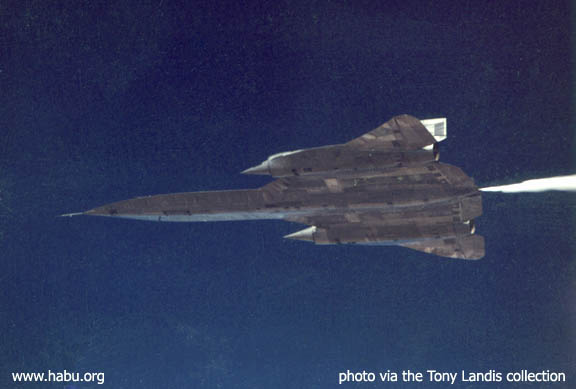
The first A-12, 60-6924, dumping fuel during an early test flight - photo courtesy of Tony Landis
The first blackbird wasn't even black.
Most people who know about the blackbird, or at least don't mistake it for "the stealth," are familiar with the SR-71. What many don't realize is that the SR-71 was the last in a series of aircraft based on the same airframe concept. The first in that series was the A-12 (not to be confused with the US Navy's A-12 Avenger, otherwise known as the Flying Dorito). Lockheed's A-12 was an internal designation that was never adopted by the Air Force, primarily because it was built for the CIA.
The A-12 was built under the codename Archangel, since it was a follow-on to the U-2 which had been built under the codename Angel. The first concept in the Archangel program was called the A-1, the next A-2, and so on. Those who hold the opinion that everything Kelly Johnson and his Skunkworks team touched turned to gold, might be disillusioned to know that the aircraft didn't start to resemble the final configuration until about the 7th design. The original concept more closely resembled a grossly oversized F-104, and would have been fueled by liquid hydrogen.
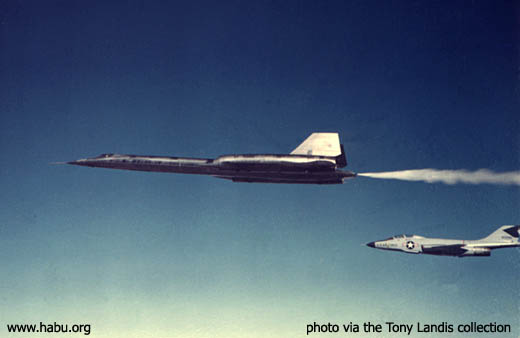
Another fuel dump from the same flight; this photo is unusual in that it shows an F-101 flying chase -- in most pics, if a chase plane is shown at all, it's usually an F-104 - photo courtesy of Tony Landis
The first flight of an A-12 took place on April 26, 1962, less than 30 months after the CIA gave Lockheed the go-ahead on the project. Considering that everything on the airplane, including the engines, airframe materials, fuels, lubricants, fluids, tires, and navigation systems, had to be designed from scratch, then considering that there was no "prototype," the A-12 will probably remain for all time as the single greatest leap in aviation technology, ever.
60-6924
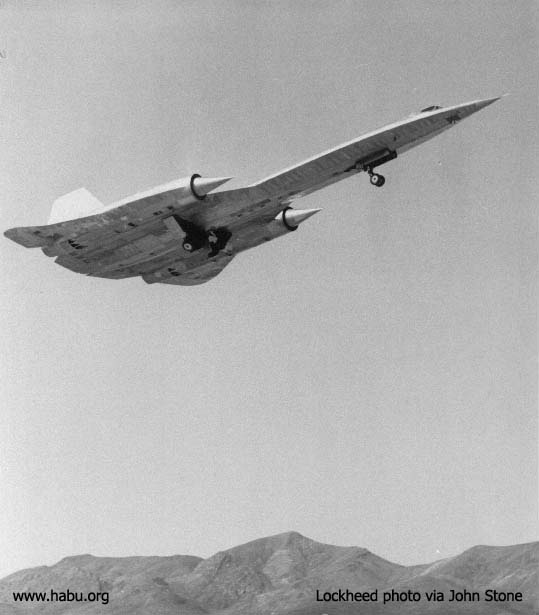
924 takes off on her official maiden flight, flown by Lou Schalk - Lockheed photo via John Stone
The first "flight" was an accidental takeoff during a high-speed taxi test on April 26, 1962. Pilot Lou Schalk recalls:
"It was determined that we would make a high-speed taxi test going down our 8000-foot concrete runway towards the Groom Lake bed which had probably 4-5 miles of lake bed suitable for landing beyond the end of the runway, so that seemed like a safe direction to go. The idea was that as I reached takeoff speed was to lift it off the ground and set it back down to see how it felt.
"Well, when we went down the runway and hit takeoff speed and lifted off, it was immediately out of control. It was oscillating longitudinally and laterally. It was obvious the airplane was very unstable. We did not have the damper systems on; no one ever turned the damper systems on on the first flight because you didn't trust them!
"Finally I got hold of it, set it back down on the ground, and was probably a mile or so out on the lakebed at that point in time. Immediately disappeared into a cloud of dust. The tower called to see if I was all right. I replied 'I'm fine, I'm rolling out to slow down and turn around and taxi back.' The tower couldn't hear me becaue the antenna for my UHF transmitter was on the bottom of the fuselage and was blanked out for the direction of the tower's line of sight. So no one knew what was happening and in the dust kept waiting for the burst of flames as I ran into the mountains. After I turned the corner, if Kelly Johnson hadn't already had a heart attack, he probably breathed a sigh of relief. I taxied back in, and we talked about it that night...I said, 'Why don't we turn the dampers on before we try this again?' We all agreed that was a very good idea!
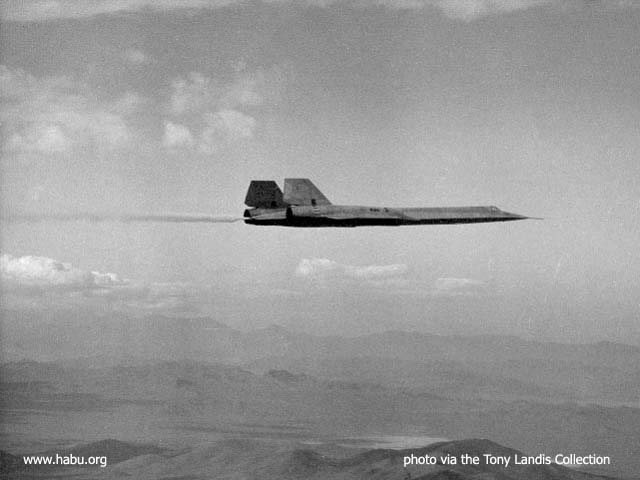
Another fuel dump from the same flight - photo courtesy of Tony Landis
"I still didn't know what had gone wrong, but I did know we had 12 to 15 thousand pounds of fuel on board for the taxi test. Flying an F-104, that's an awful lot of fuel, that's more that it carries, but we carried 76,000 pounds of fuel so we hardly had anything at all. It was all in the back end. The airplane was statically unstable, which meant that anytime you move the controls or if the airplane had any movement, you had to make a correctional movement with the controls to stop it, otherwise it would keep right on going; where if the airplane is stable, that means it will tend to return to its normal position, say if it hits some rough air or something like that. This is because of the center of gravity and its location to the center of pressure, which is usually about the midpoint of the wing.
"We had so much fuel in the back end of the airplane that the center of gravity was about 3 percent beyond the aft limit, and we were terrifically unstable. On the actual flight where we got airborne and stayed there, we were probably 3 percent forward of where our normal fuel loading would be. The reason that happened was that the ground crew and most of the people who were getting the airplane ready for this taxi test didn't know that we had decided to lift off the airplane and set it back down again that night except for Kelly, myself and the flight test engineer...no one told them!"
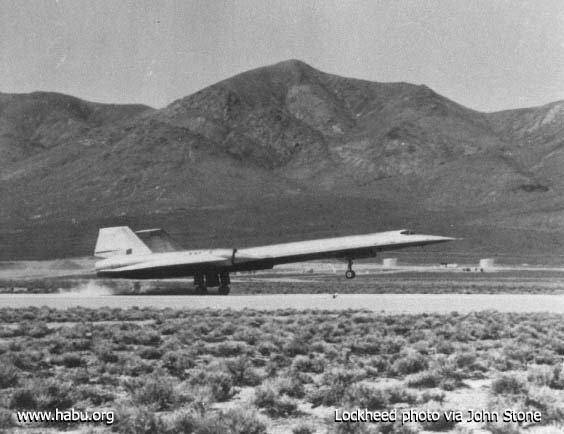
60-6924 completing her "official" maiden flight, April 30, 1962, flown by Lou Schalk - Lockheed photo via John Stone
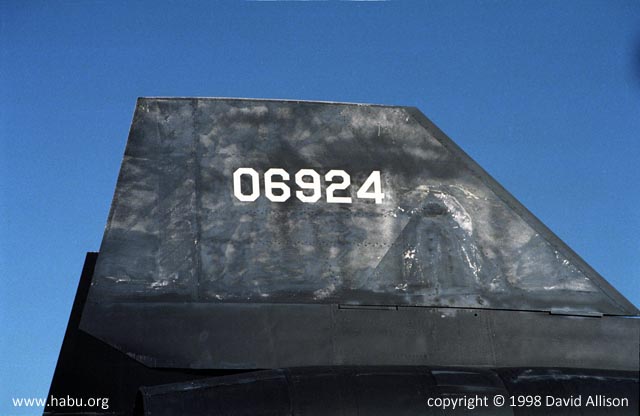
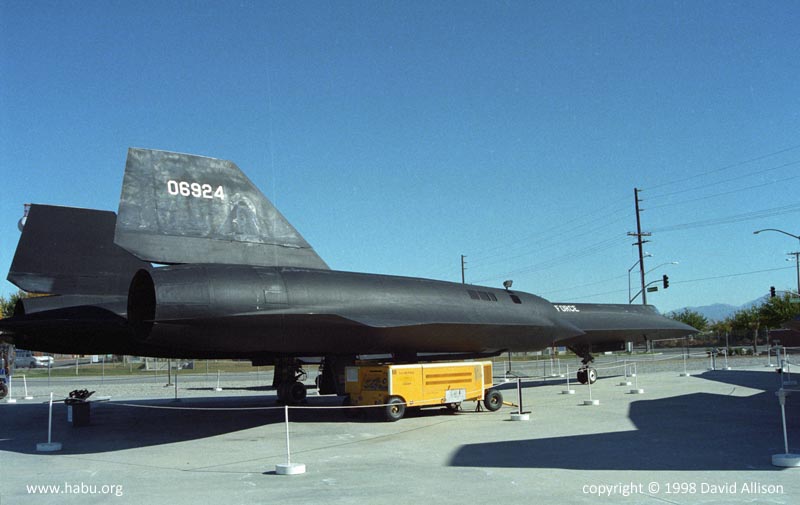
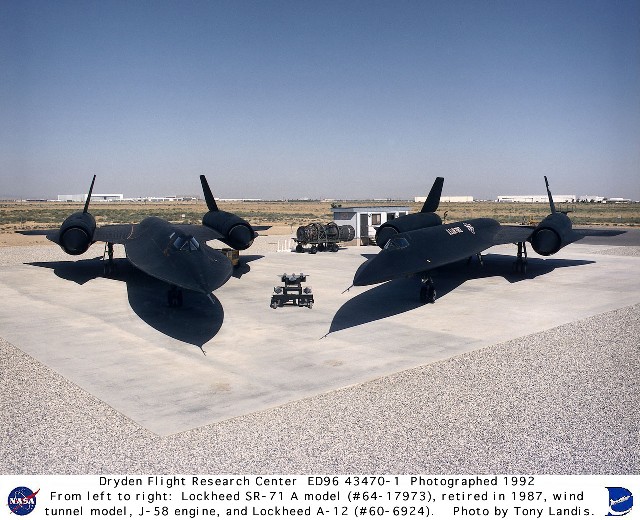
60-6925
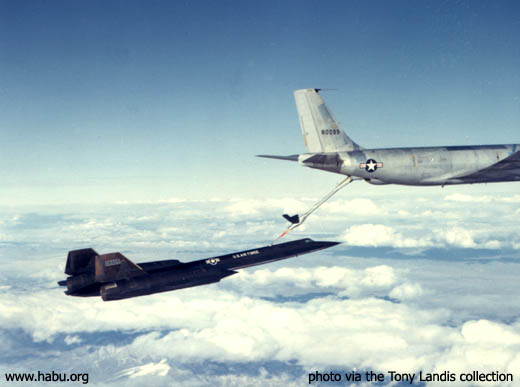
925 in flight - photo courtesy of the Tony Landis collection
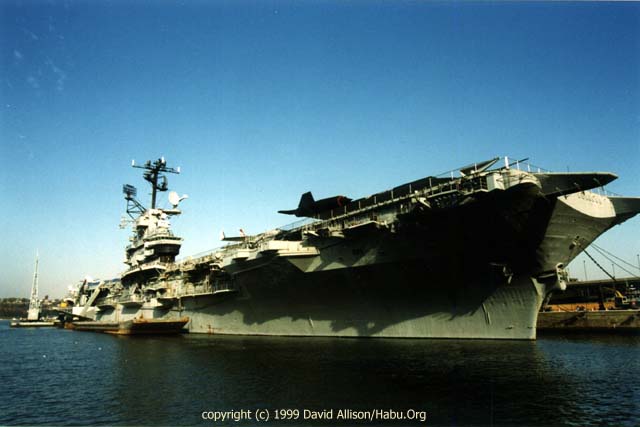
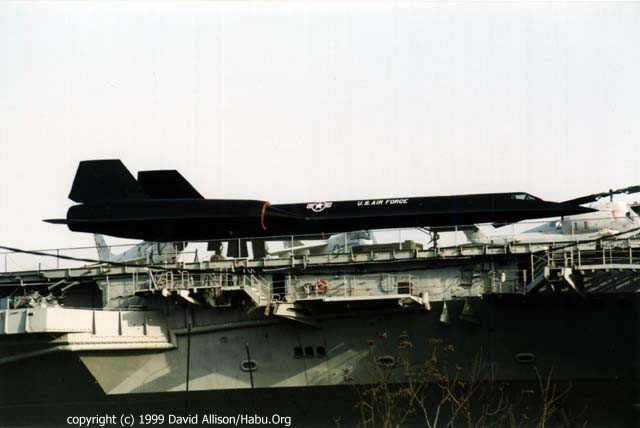
60-6925 is the only Blackbird to rest on a carrier flight deck - the USS Intrepid Flight Museum in New York City's harbor.
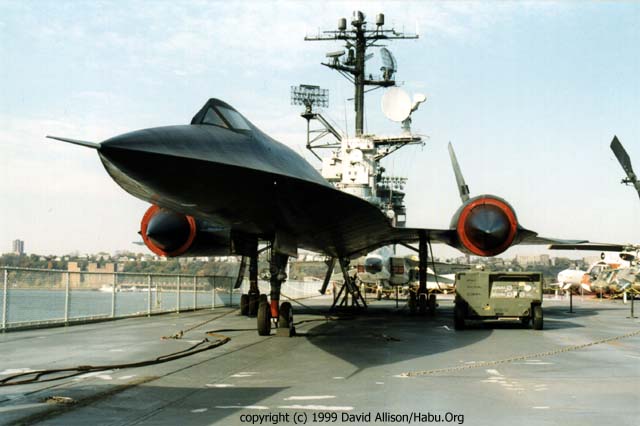
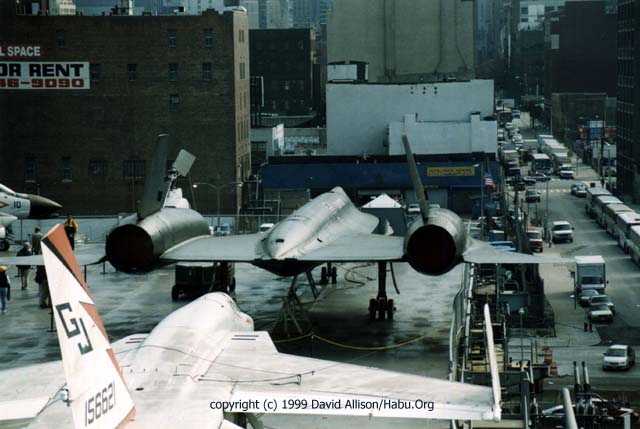
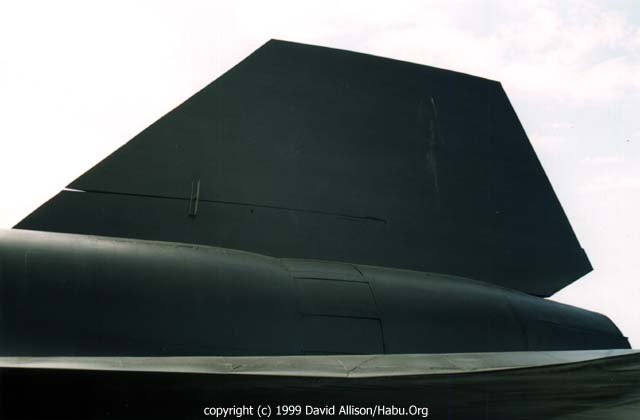
You'll have to take their word for it that this is 925 - her tail is completely unmarked (annoying but historically accurate, since many of the A-12s flown from Kadena had ficticious tail numbers or no markings at all)
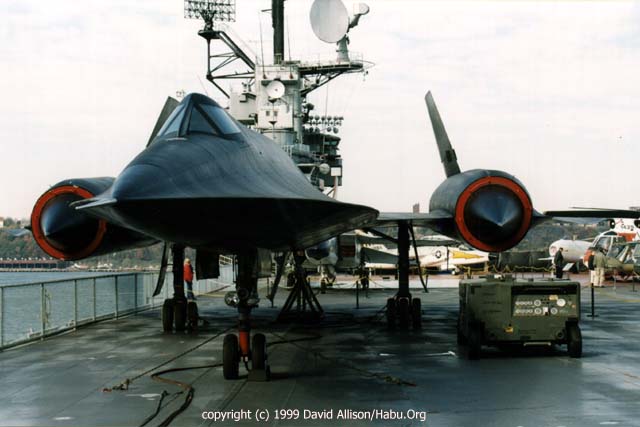
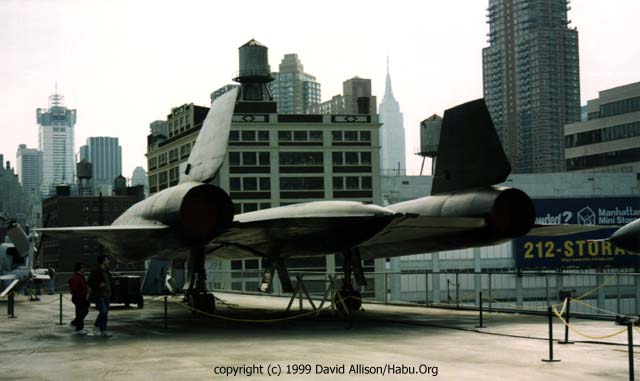
a blackbird and the Empire State Building in the same photo
60-6926
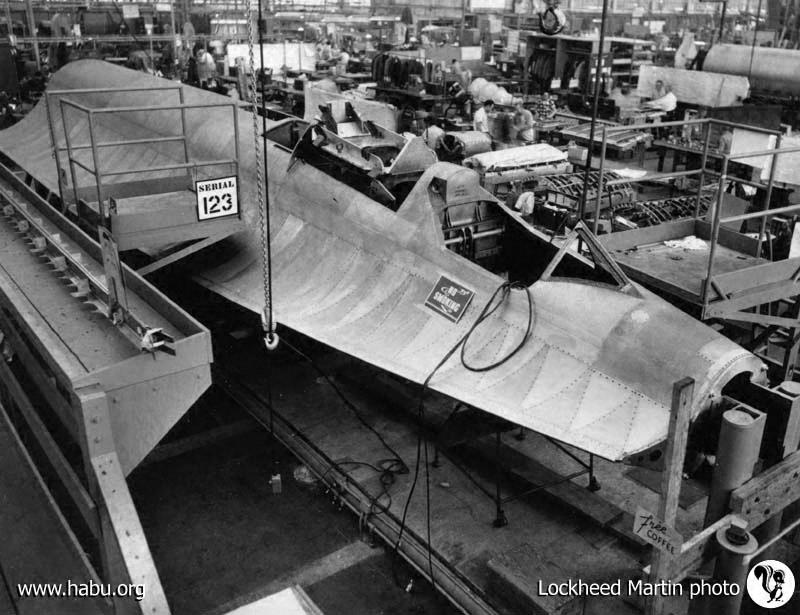
In addition to the placard on the gantry, the serial number is also stenciled on the bulkhead behind the headrest in the cockpit.
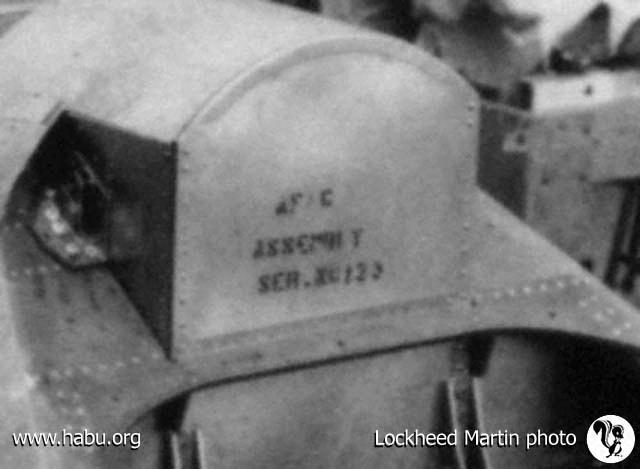
926 was lost in the first Blackbird accident. On Friday, May 24, 1963, she crashed due to instrument failure. Pilot Ken Collins was unharmed. The crash occured near Wendover, Utah.
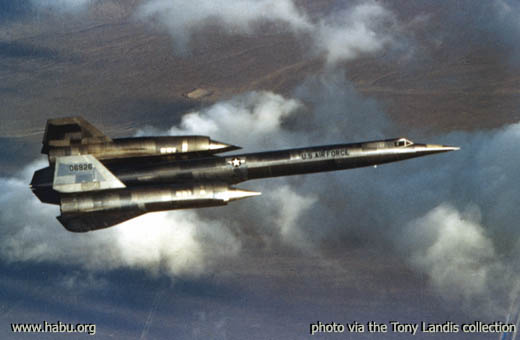
926 in flight -photo courtesy of the Tony Landis collection
60-6927
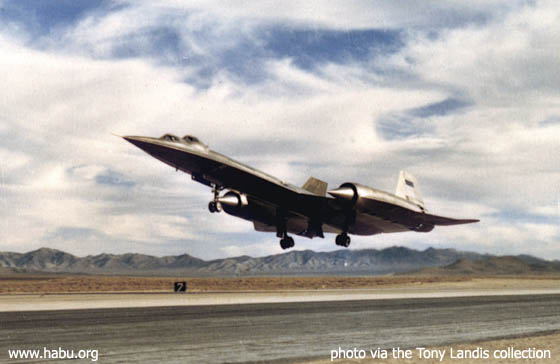
927 takes off from Groom Dry Lake - photo courtesy of the Tony Landis collection
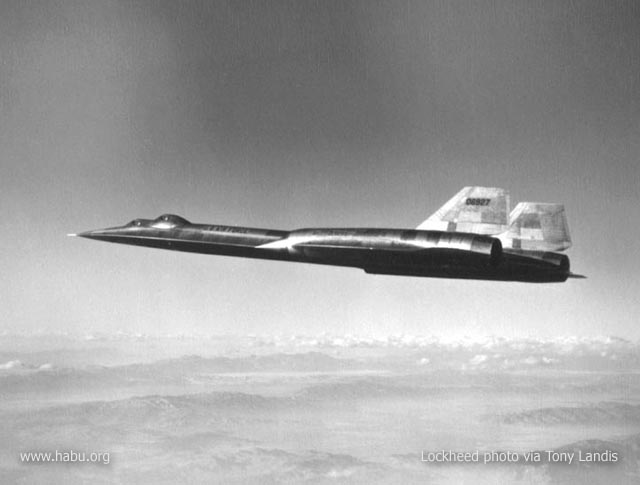
A rare glimpse of 927 from a chase plane - Lockheed photo courtesy of the Tony Landis collection
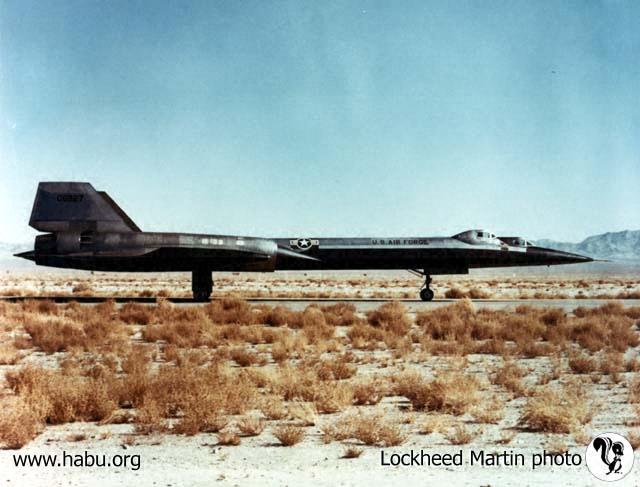
Also known as the "Titanium Goose," #927 was the only "B-model" in the A-12 series.
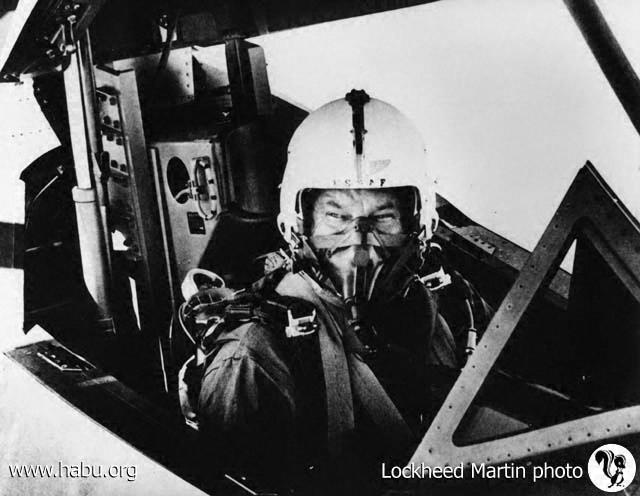
Clarence L. "Kelly" Johnson, about to get the first "check ride" in 927 with Lockheed test pilot Lou Schalk. Contrary to some reports, this was not the only time he flew in a blackbird; in his book Kelly: More than My Share of It All", Johnson states that he was also in the back seat of a YF-12 on one of the missile test firings.
60-6928
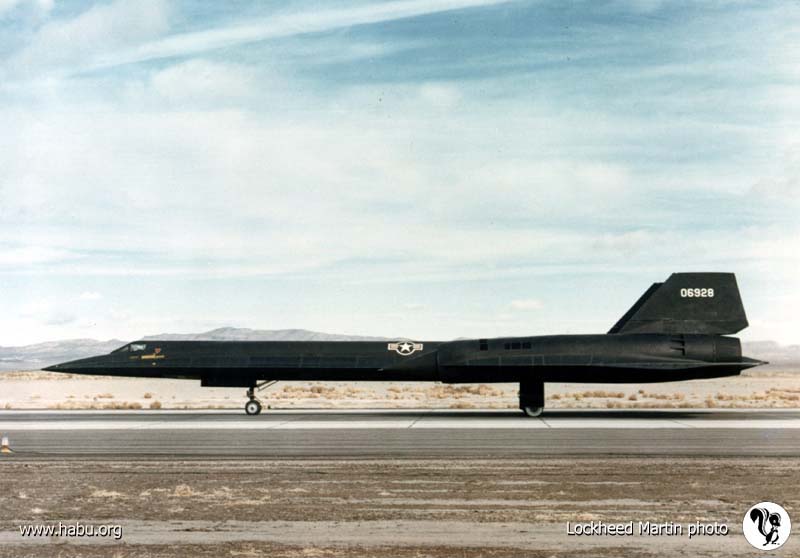
928 on the runway at Groom Dry Lake - photo courtesy Lockheed Martin
928 was lost on Thursday, January 5, 1967. She ran out of fuel (due to a faulty fuel gauge) and crashed while on approach to Groom Dry Lake. CIA pilot Walt Ray ejected but did not survive. For a detailed account of the crash, and one man's 27-month quest to find the site, visit Tom Mahood's The Hunt for 928. This page was updated on June 28, 1999 - definitely worth a second look!
Ray Scalise was a Fire Control Officer on the YF-12 during the early test program at Groom Dry Lake, and knew Walt Ray personally. Click here to download an html book from Ray with recollections about Walt and his last flight.
60-6929
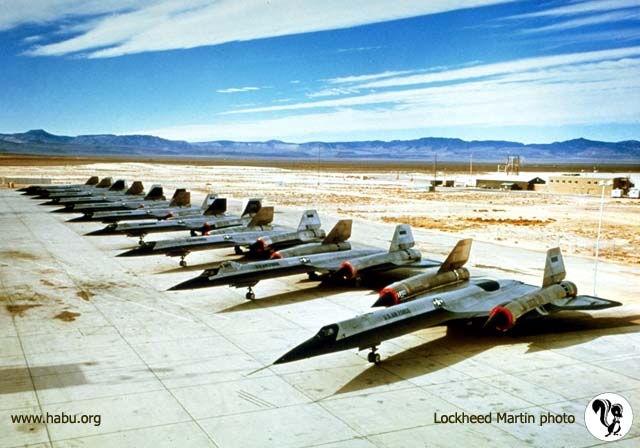
8 A-12s and 2 YF-12s lined up on the ramp at Groom Dry Lake. 929 is the fourth aircraft in line, to the left of 924, the Titanium Goose (927), and 928. - photo courtesy of Lockheed Martin
929 was lost on Tuesday, December 28, 1965. The newly-installed SAS (Stability Augmentation System) had the connections wired backwards, causing the airplane to lose complete control just seconds after takeoff from Groom Dry Lake; pilot Mele Vojvodich ejected safely at an altitude of 150 feet. All future SAS installations used polarized connectors. You live, you learn.
60-6930
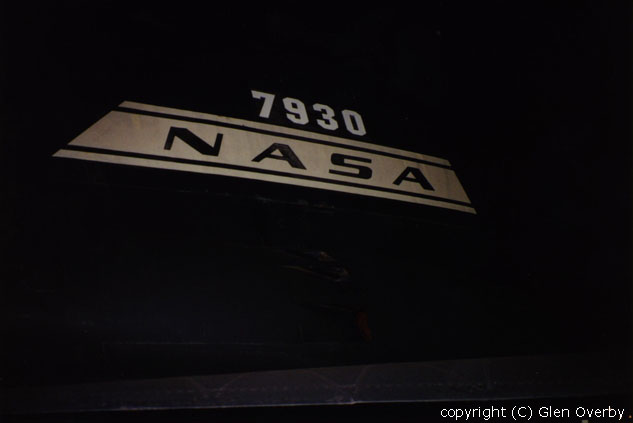
photo courtesy Glen Overby
.gif)
06930 is on display at the U.S. Space and Rocket Center near Huntsville, Alabama.
She bears the same markings as the YF-12s flown by NASA from 1969 thru 1979. However, none of the A-12s were ever flown by NASA.
60-6931
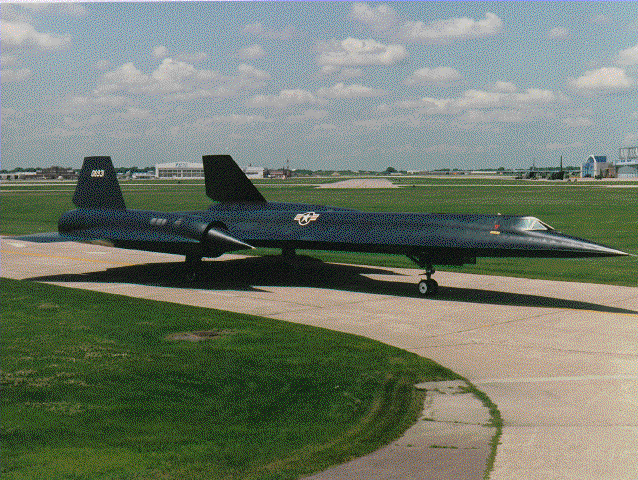
photo courtesy of Jim Goodall
06931 was on display at the Minnesota Air National Guard Museum in Minneapolis.
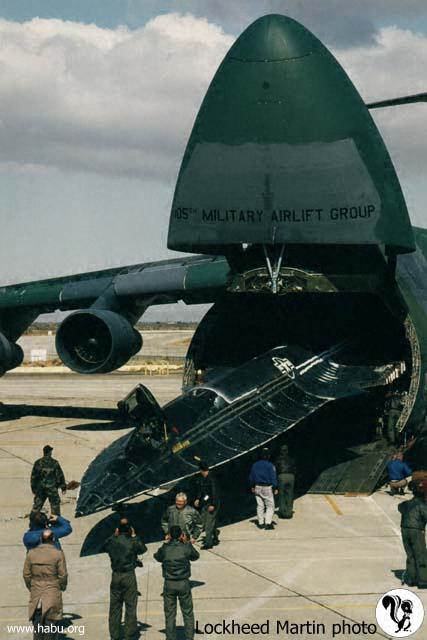
Her wings severed by an acetalyne torch, an unflyable 931 is loaded onto another Lockheed wonder, the C-5A Galaxy, at Lockheed's facility in Palmdale on October 27, 1991. At 102 feet, this was the longest load ever put inside another aircraft up to that time. While several other A-12s and SR-71s also had their wing spars cut in order to transport them to museums, many were spared this fate: 924, 925, 927, and 940 in particular. - Lockheed Martin photo
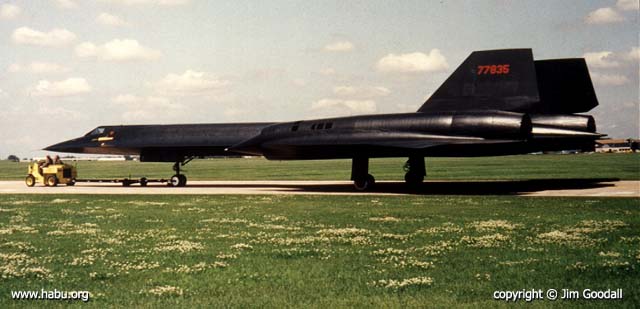
When the A-12s were briefly operated out of Kadena AFB in Okinawa, Japan, it wasn't unusual for them to be marked with false tail numbers, red numbers, or no markings at all. This was to confuse spies and spotters who tried to figure out how many of these black aircraft were being operated, and what their range and performance was. - photo courtesy of Jim Goodall
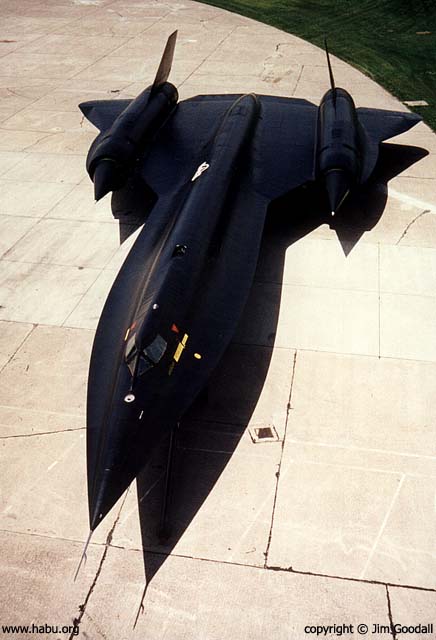
Once delivered to her new home, Article 128 was completely repainted and restored. -photo courtesy of Jim Goodall
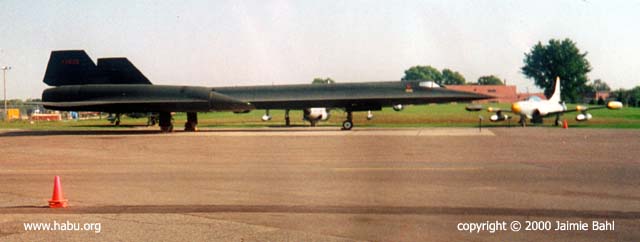
photo courtesy of Jaimie Bahl
In 2006, amidst a storm of controversy, 931 was removed from the MNANG museum to be relocated at the CIA headquarters in Langley, VA. She was delivered in September 2007, and dedicated at a ceremony with several key figures in attendance, including A-12 pilot Ken Collins.
60-6932
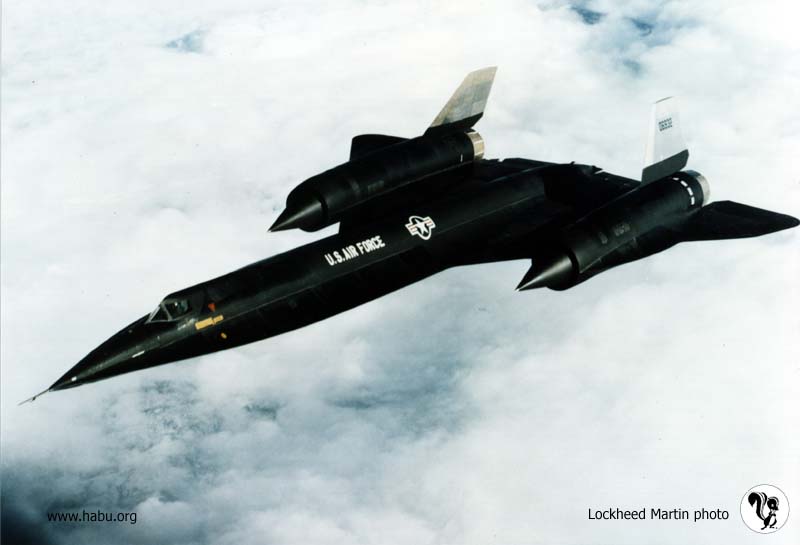
Photo courtesy Lockheed Martin
This Lockheed photo of 932 is about the only thing left of her. She went down into the sea near the Phillipines on Wednesday, June 5, 1968 (NOTE: the official report says June 4, but most other sources say it was June 5), after exploding in flight at Mach 3 during a checkflight prior to returning her stateside. Although he didn't realize it at the time, Don Person (one of the first crew chiefs of the SR-71, and among the first group to be assigned to Det-1 at Kadena AFB), was one of the last people to seek Jack Weeks alive. He recalls:
Our KC-135Q tanker was inbound from Beale AFB on 5 June. Before landing we were gathered together and notified that upon landing we would see things we probably were not aware of and not to talk about what we would see (otherwise on a "need to know basis"). The tanker landed and spotted in a revetment. Once the large cargo door was opened and steps were in place we departed to the flight ramp. As soon as we were on the ground I heard the sound of J58 engines coming down the taxiway. As 06932 passed the tanker I noticed this was no ordinary SR-71: no RSO canopy, and red numbers [on one side, white tail numbers on the other]. Just seeing the red numbers instead of the SR-71 white was enough to say this was not a Beale SR-71. We watched it taxi to the active runway and departed a short time later. I can remember we all looked at each other in amazement but did not discuss it as previously advised.
Rumors soon circulated that this aircraft was missing. SR-71 #974 (which I was crew chief of) was generated for flight and flew the next day. Her mission was to look for the missing aircraft. No such luck. Months later, I found out about the A-12 aircraft and put two and two together.
Not until several years ago did I see another A-12; landing at San Diego you can see one in the Balboa Park. Also driving by the battleship Alabama museum in Mobile Bay I also saw what I thought was a SR-71 on display. Again not true, it also is an A-12.
Because no trace of neither 932 nor her pilot, Jack Weeks, was ever found, some have speculated that Weeks "defected to the other side." These rumors are completely groundless, as Peter Merlin states in this August 1999 posting to the Skunkworks Mailing List: (reprinted by permission)
Date: Sun, 15 Aug 1999 02:28:37 EDT
From: Xelex@aol.com
Reply-To: skunk-works@netwrx1.com
To: skunk-works@netwrx1.com
Subject: Re: Birdwatcher and lost A-12
Here is some information on the Birdwatcher system and the loss of A-12 #129. Please excuse the length of this post (or rejoice in it).
The Birdwatcher constantly monitored various vital aircraft system functions, as well as equipment functions. If and when established limits and equipment activity were sensed, the Birdwatcher would key and modulate the HF transmitter with a coded signal. The coded signal was a multiplexed sample of each monitored item, including the item which triggered the Birdwatcher. Thus, the intended receiver operator could determine which aircraft system or equipment triggered the unit and could monitor the status of all remaining items. There were 40 channels available, though not all were necessarily used.
The system was controlled from the cockpit with a control panel shared with the ECM and SIP controls on the righthand console. The Birdwatcher unit utilized the HF transmitter, and was located in the lower right side of the E-Bay, just behind the A-12 cockpit (C-Bay). Items monitored by Birdwatcher included generator fail, transformer fail, altitude low, fuel quantity low, destruct active, fuel flow low, hydraulic pressure low, System "A" and "B" active, "A" and "B" hydraulic pressure low, oxygen pressure low, compressor inlet temperature high, System "B" manual jam on, pitch and yaw acceleration, cockpit pressure low, seat ejected, Code "A" and "B", angle of attack high, fire warning, System "C" and "F" activity, oil pressure low, and EGT [Exhaust Gas Temperature] High Derich on.
If the Birdwatcher sensed a system limit or equipment activity, it would key the HF tranmsitter and transmit three short, consecutive half-second bursts, each separated by a five-second quiet period. During each burst, the condition of all monitored items , as well as aircraft identity, was transmitted. Upon transmission, the pilot heard three "chirps" in his headset, and an activity light illuminated on the Birdwatcher control panel. "Code A" and "Code B" switches on the panel could be used to retrigger the Birdwatcher to indicate pilot awareness of Birdwatcher operation. By prearrangement, activation of the "Code A" switch could indicate "pilot aware - no emergency." In that case, "Code B" switch activation might indicate "pilot aware - emergency condition."
Having transmitted, the Birdwatcher would not key the HF transmitter again until another system limit was reached or another equipment activity was sensed, or if the original triggering system returned within limits and exceeded them again.
On 4 June 1968, Mr. Jack Weeks flew A-12 (#129) on a redeployment preparation and functional check flight due to replacement of the right engine. Taxi and takeoff were uneventful, as evidenced by the reception of the required Birdwatcher "Code A" transmission and the lack of any HF transmissions from the pilot. Refueling, 20 minutes after takeoff, was normal. At tanker disconnect, the A-12 had been airborne 33 minutes. The tanker crew observed the A-12 climbing on course in a normal manner. This was the last visual sighting of the aircraft. No further communications were received until 19 minutes later when a Birdwatcher transmission indicated right engine EGT was in excess of 860 degrees C. Seven seconds later, Birdwatcher indicated the right engine fuel flow was less than 7500 pounds per hour and repeated that EGT exceeded 860. Eight seconds later, Birdwatcher indicated that the A-12 was below 68,500 feet, and repeated the two previous warnings. This was the final transmission.
Several attempts were made to contact Weeks via HF-SSB, UHF, and Birdwatcher, but without success. Operation of recording and monitoring facilities at the home base continued until the time that the aircraft's fuel would have been exhausted, but no further transmissions were received. The aircraft was declared missing some 500 nautical miles east of the Phillipines and 600 nautical miles south of Okinawa. The accident report declared that "No wreckage of aircraft number 129 was ever recovered. It is presumed totally destroyed at sea."
Peter W. Merlin
The X-HUNTERS
Aerospace Archeology Team
60-6933
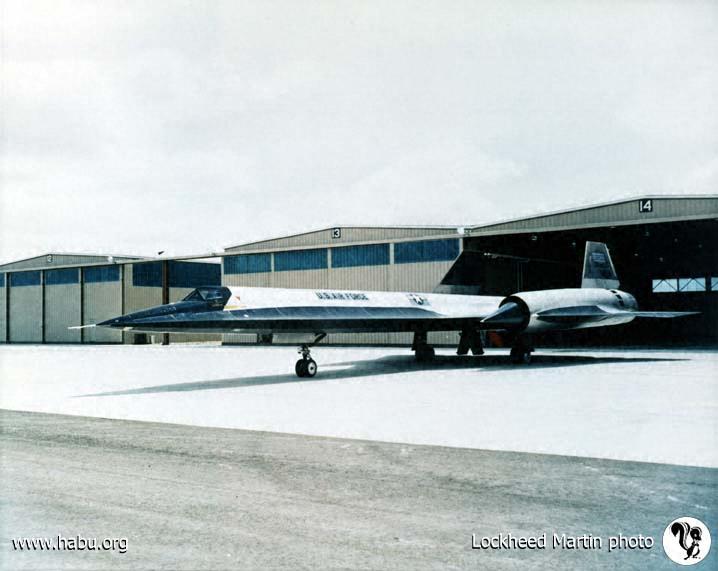
933 is displayed mounted on three pedestals in front of the Aerospace Historical Center in San Diego, California.
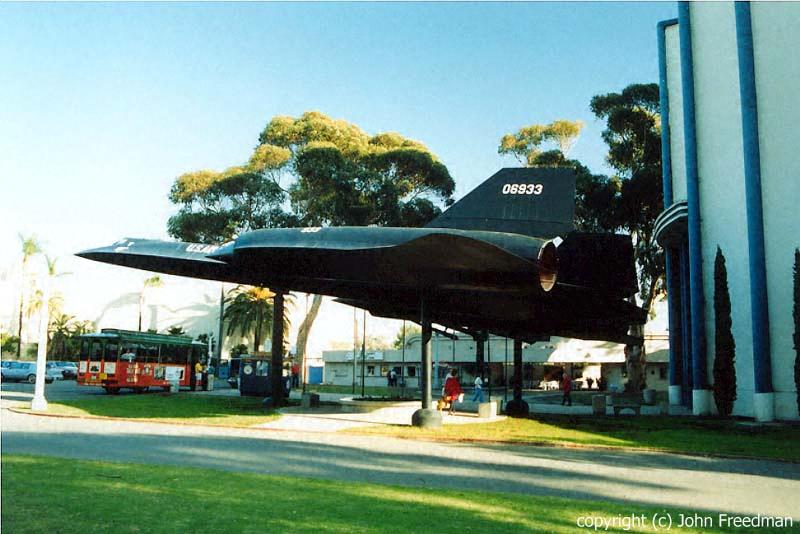
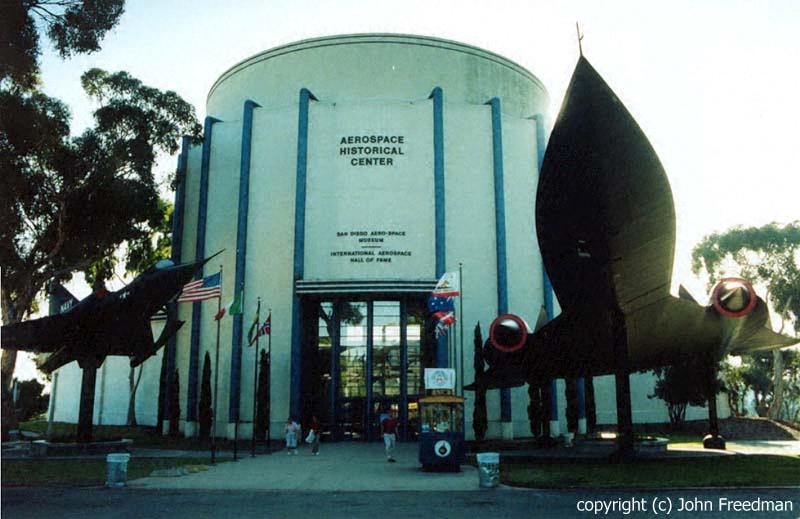
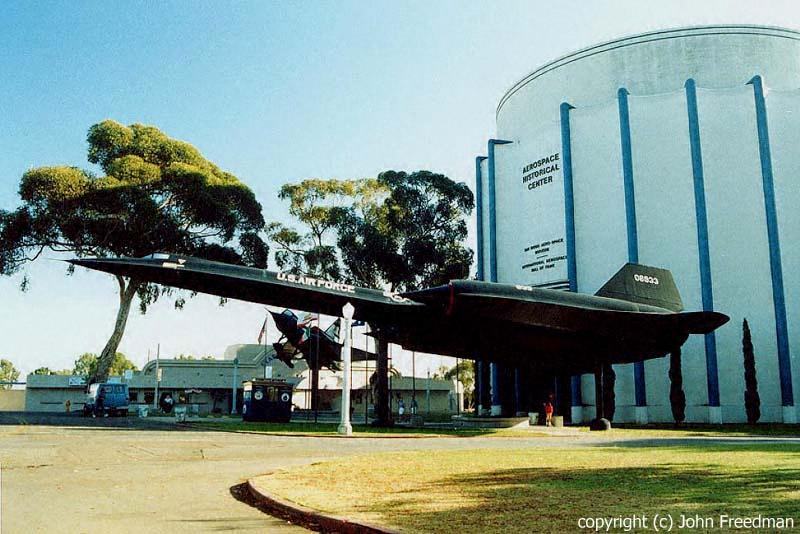
photos courtesy John Freedman
60-6934
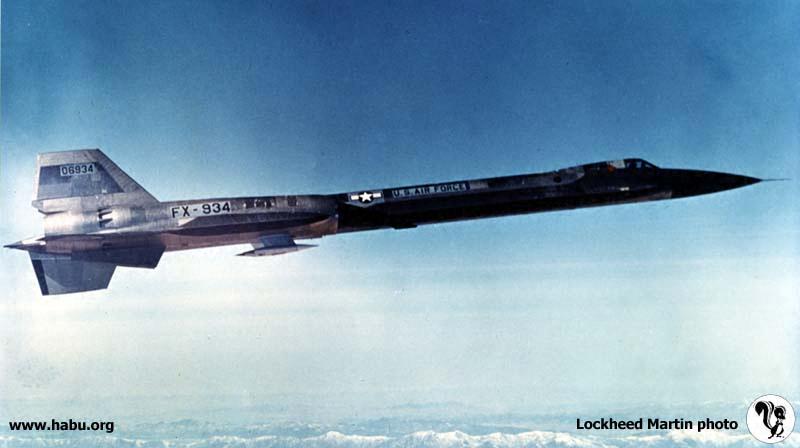
This Lockheed photo was the very first one published of ANY blackbird. Until 2 YF-12s were unveiled at Edwards AFB in late 1964, this was all that anyone knew about the blackbird.
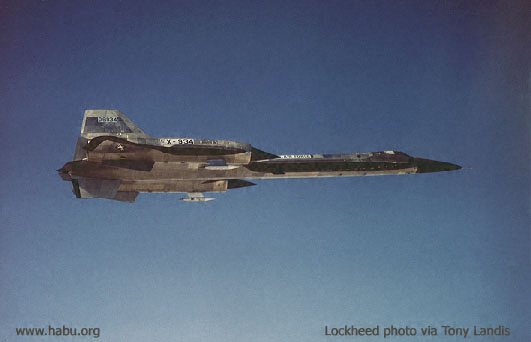
Another photo of 934, taken during the same flight as the one above - Lockheed photo via Tony Landis
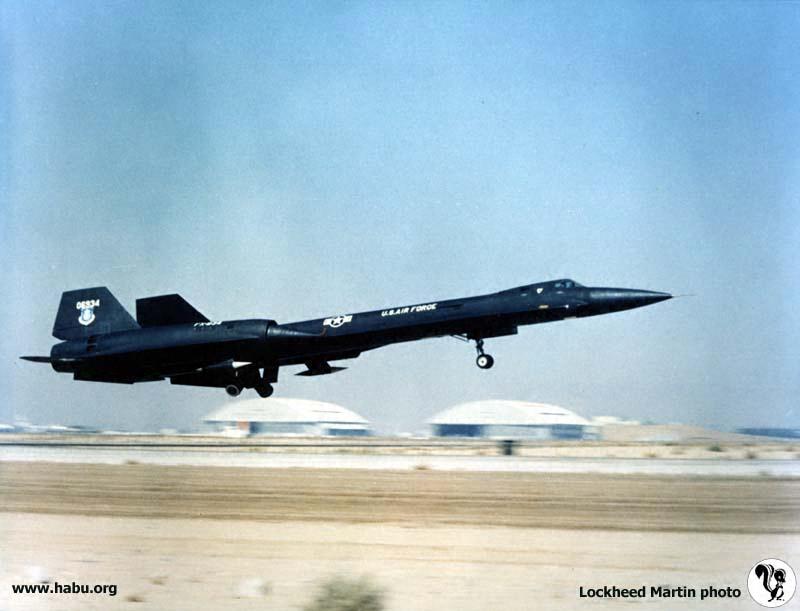
934 was severely damaged as a result of internal systems overheating during a test flight from Edwards AFB on August (or July) 14, 1966. The airframe remained intact but the damage to internal systems was beyond repair. What happened to the forward section is anybody's guess, but the aft end lives on as part of SR-71C #981.
60-6935
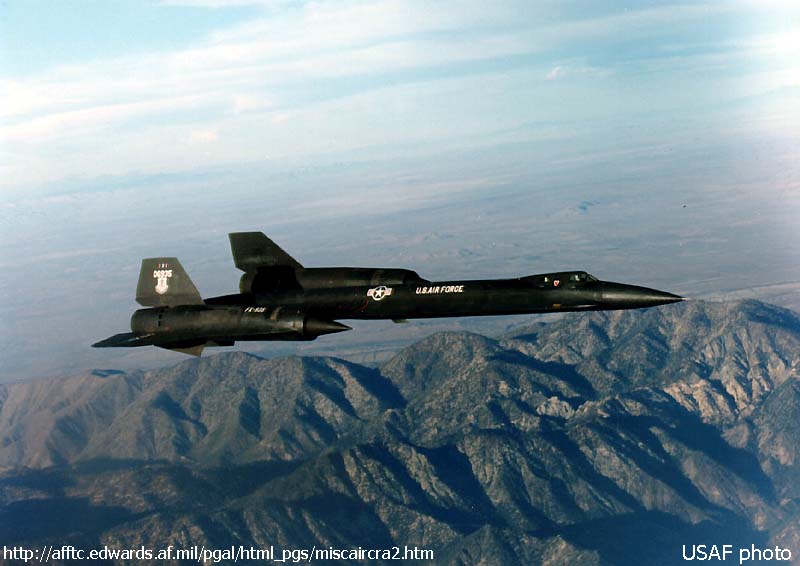
USAF photo
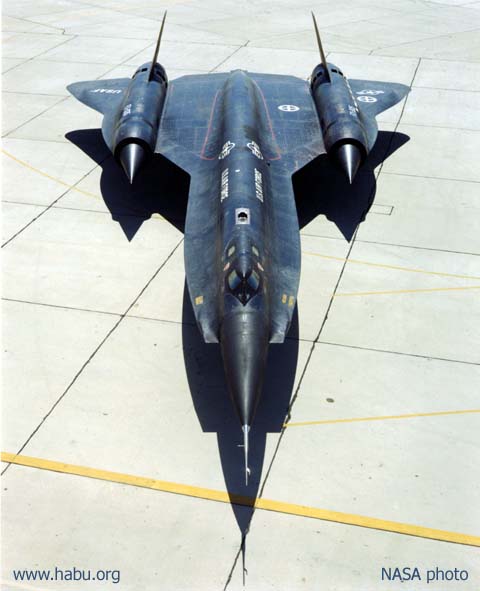
YF-12A #935 on the ramp at NASA FRC, April 28, 1971 - photo courtesy of NASA
YF-12 radar systems engineer Ray Scalise recalls one adventure in 935, during the US Air Force's test program:
"One of the things that was done to the YF12As at Edwards was to paint a white cross on the bottom of the aircraft to make it visible against the black sky so it could be spotted by a ground observer who was stationed on the hangar roof during missions (they used high power binoculars). He was in radio contact with the engineers in the radio room in the hangar.
"On one mission the observer said he did not need the binoculars to see the airplane because he could see the "contrail." Airplanes con at 35,000 ft, NOT AT 80,000 ft. At about the same time my pilot noted we were losing fuel at a very high rate. He guessed a fuel line to the left engine had burst and was feeding raw fuel into the engine. He immediately declared an emergency, throttled back on the engines and began a spiral descent to Edwards since we were right overhead. I kept my hands on the eject handle in case the airplane decided to explode. We landed OK and when the plane stopped the base commander was there with his car. Emergency vehicles had not arrived on the scene yet, so the base commander drove up to the plane on the right side by the cockpits.
"Both the pilot and I egressed the aircraft by jumping on the roof, then the hood of the car and started to run away from the bird. It looked like it had just come out of a car wash and was leaking fuel all over the runway. I still do not know why it did not explode. YEAH, the fuel was of low volatility, but come on!
"Anyway, because I was carrying almost double my weight (the pressure suit weighs 35 lbs and the parachute weighs 70 lbs; I only weighed 120 lbs), I was concerned about falling off the airplane and breaking my neck. SO...I walked down the chine on my spurs to keep from slipping on the wet skin (the spurs were strapped to your boots, and were used to hook into cables on the seat which were designed to pull your feet back into the seat to prevent leg loss during an ejection). In doing so I punched a couple of holes in the upper chine skin. Thus, I have always contended I "signed my signature" to the plane.
"If you are ever in Dayton, Ohio at the air museum, there you can see the patches on the upper chine, right side by the rear cockpit where they repaired my 'signature.'"
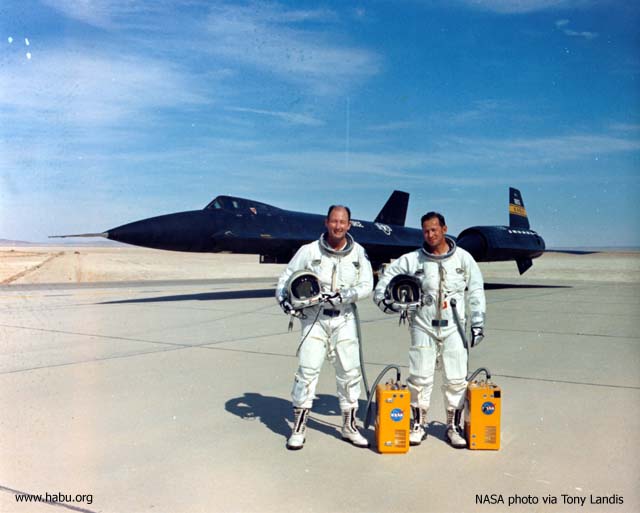
NASA crewmen Fitz Fulton and Don Mallick with 935 - NASA photo via Tony Landis
More photos are available at NASA's web site and our NASA/Dryden Mirror Page.
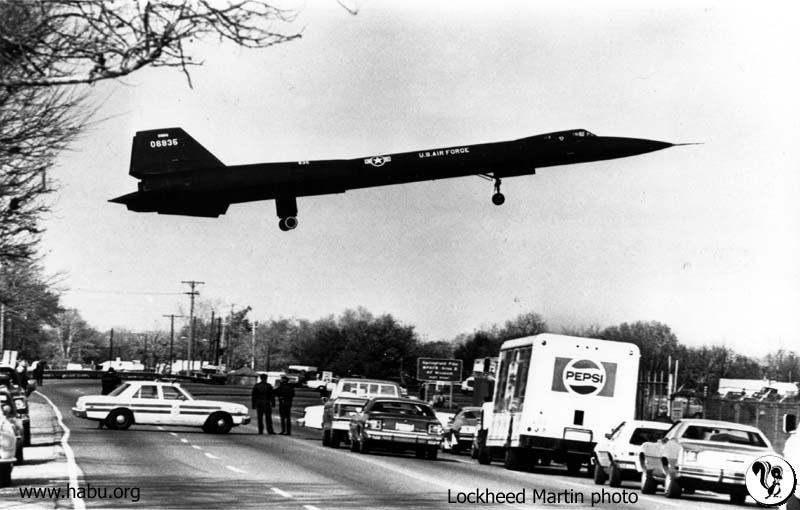
935's last final approach - photo courtesy of Lockheed Martin
The only surviving YF-12A, 935 was delivered to the U.S. Air Force Museum at Wright-Patterson AFB near Dayton, Ohio, by Col. Jim Sullivan and Col. Richard Uppstrom on Wednesday, November 7, 1979, and has been on permanent display ever since. The museum is also home to an SR-71 (61-7976).
60-6936
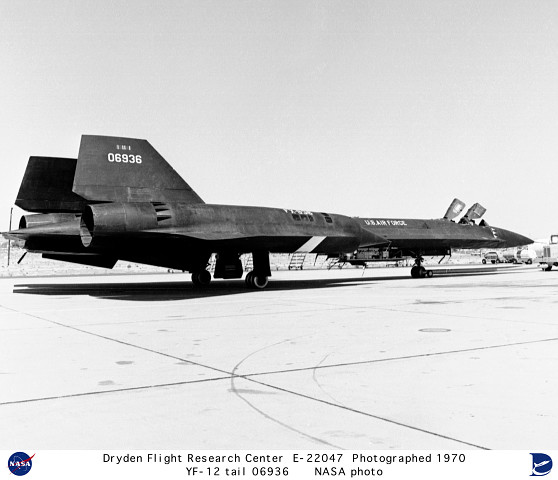
photo courtesy of NASA/Dryden
On Saturday, May 1, 1965, YF-12A #60-6936 was used to set several speed and altitude records (notice the white reference cross just visible on the underside of the engine near the landing gear). This was "coincidentally" the Russian New Year, and 5 years to the day that Gary Powers was shot down flying his U-2 over the Soviet Union. The plan was to have 2 airframes (936 and 934) each set different records, but 934 developed problems at the last minute, and so 936 was used to set all of the following records that day:

photo courtesy of Lockheed Martin
Date Record Crew
1 May 1965 World absolute and class records for speed over a 15/25 km straight course:
2,070 mph
World absolute and class records for sustained altitude (horizontal flight):
80,258 ft Col. Fox Stephens and LtCol. Daniel Andre
1 May 1965 World absolute and class records for speed (500 km closed circuit):
1,643 mph Maj. Walt Daniel and Maj. Noel Warner
1 May 1965 World absolute and class records for speed (1,000 km closed circuit):
1,689 mph Maj. Walt Daniel and Capt. James Cooney
Source: Lockheed Martin press release, Sept. 1991
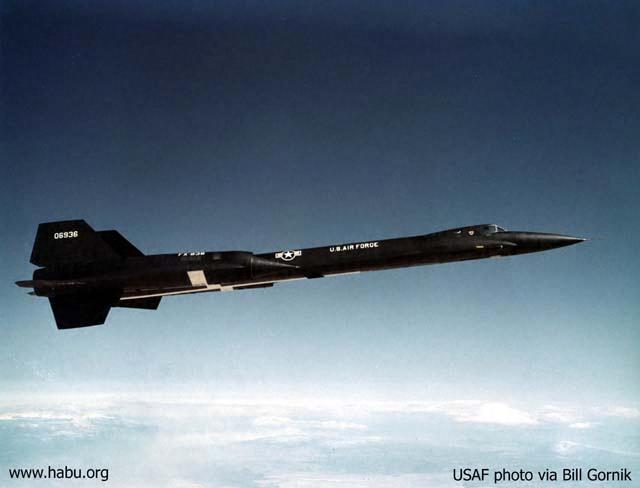
She was still wearing that cross when she was lost on Thursday, June 24, 1971. On approach to Edwards Air Force Base, a fire broke out from a ruptured fuel line and quickly engulfed the entire left engine. Pilot Lt.Col. Jack Layton and Systems Operator Billy Curtis ejected safely, but the aircraft was a total loss. Shortly thereafter, SR-71 #951 was reassigned the bogus tail number 06937, redesignated as a "YF-12C", and continued with NASA's YF-12 program until its conclusion in 1979.
60-6937
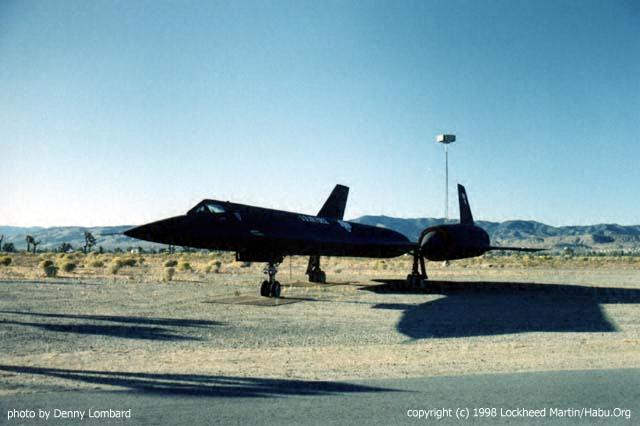
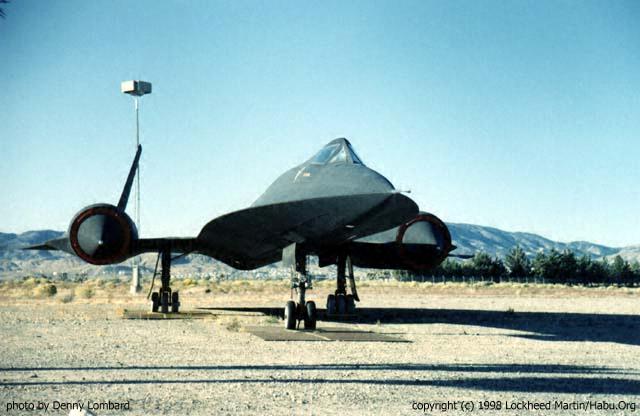
A-12 number 06937 had been "displayed" at the Lockheed Martin Skunk Works in Palmdale, California behind a 12' chain link fence, visible from the guard's station at the entrance but off limits to the public. In February of 2000 she was transported by WorldWide Aircraft Recovery to her new home at the Southern Museum of Flight in Birmingham, Alabama. Of the 13 A-12s originally built, only 8 remain and now 3 of them are in Alabama--only California has as many.
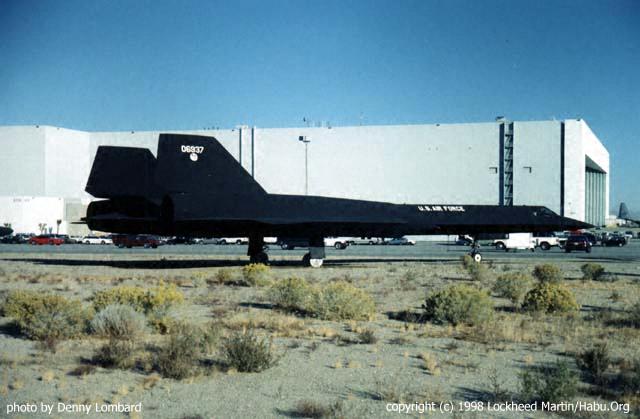
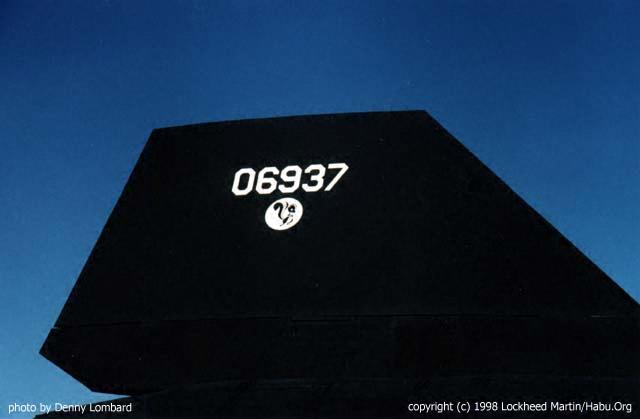
There were two Blackbirds designated as 06937. This A-12 (Lockheed/CIA article #131, USAF serial number 60-6937) on display in Birmingham was the first.
"....It was the first A-12 to be deployed to Kadena AFB in Operation Black Shield. It also flew the first of 29 A-12 operational missions over North Vietnam May 22, 1967, as well as the last operational Black Shield mission, in support of the AGER-2 USS Pueblo May 8, 1968. It made its last flight June 21, 1968, the final [of any] A-12 flight. This aircraft flew just 345.75 hours in 177 flights, while the entire A-12 fleet had flown only 4,804.38 hours in 2,083 flights." - William J. Simone, Lockheed Skunk Works Star, March 26, 1999 (quoted with permission)
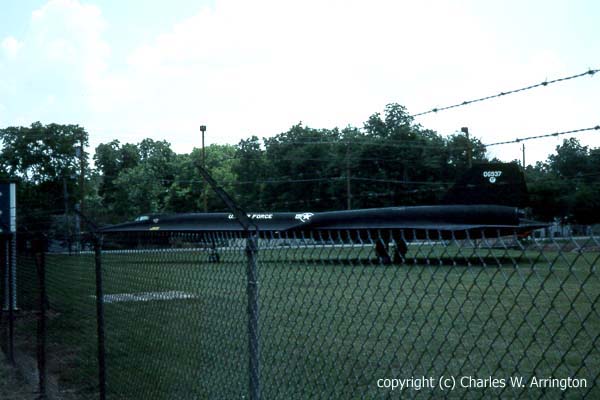
photo by Charles W. Arrington courtesy of John Stone
60-6937 as she is now displayed at the Southern Museum of Flight
--------------------------------------------------------------------------------
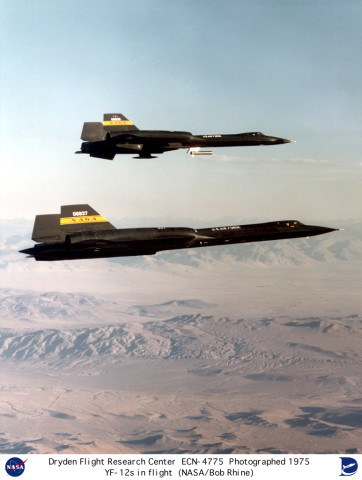
"The Other 937"
In 1971, SR-71 #17951 was loaned to NASA to complete the testing of the YF-12A program (2 of the 3 YF-12s had already been lost in accidents). 951 was temporarily redesignated as a YF-12C (there being no B-model trainer for the YF-12 series) and given NASA#937. This number was chosen for 2 reasons:
the Air Force didn't want anyone to know that NASA had an honest-to-goodness SR-71 in their possession, and made up the "YF-12C" designation to hide the fact. Since the other 3 YF-12s bore numbers 934, 935, and 936, it made sense that the next aircraft in the series would be numbered 937.
The entire A-12 program was classified until 1982, and since no one would have known there was another 937, there would be no confusion.
On October 27, 1978, she was returned to the Air Force and given back her old number. She logged her final flight two months later, on December 22, 1978.
60-6938
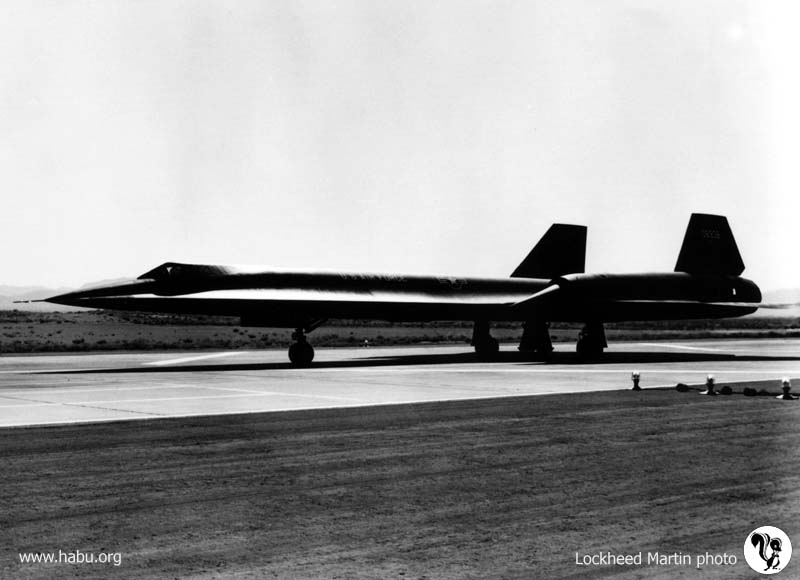
938 prepares to take the runway in this rare glimpse of an A-12 in action - photo courtesy Lockheed Martin
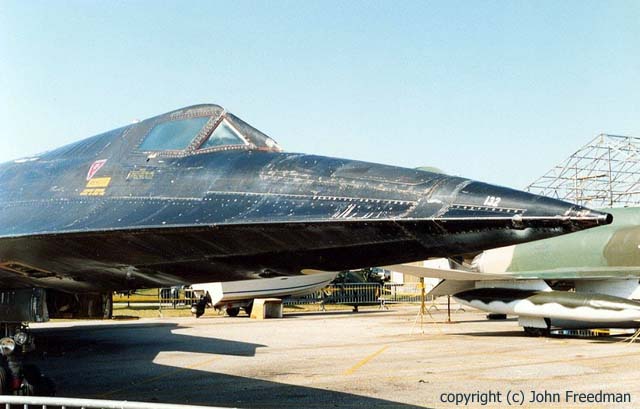
Lockheed article #132 on the nose identifies this A-12 as #60-6938 - photo courtesy John Freedman
938 is on permanent display at the USS Alabama Battleship Memorial Park near Mobile, Alabama. She has been repainted and moved indoors since the above photo was taken.
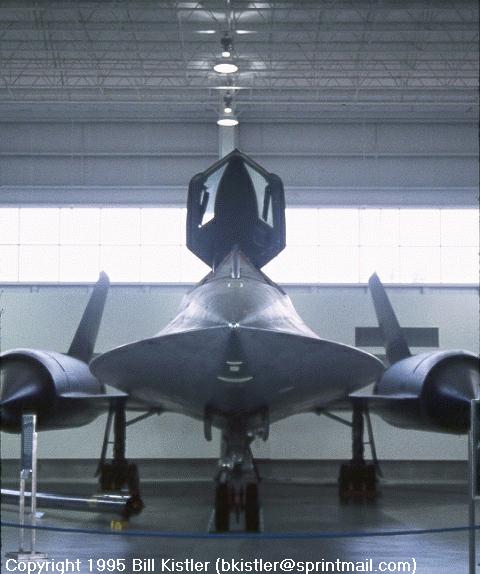
Photo courtesy Bill Kistler
60-6939
.jpg)
photo courtesy Lockheed Martin
Photos of this particular bird are extremely rare, as she had less than 9 hours of flight time accumulated when she crashed on approach to Groom Dry Lake on Thursday, July 9, 1964.
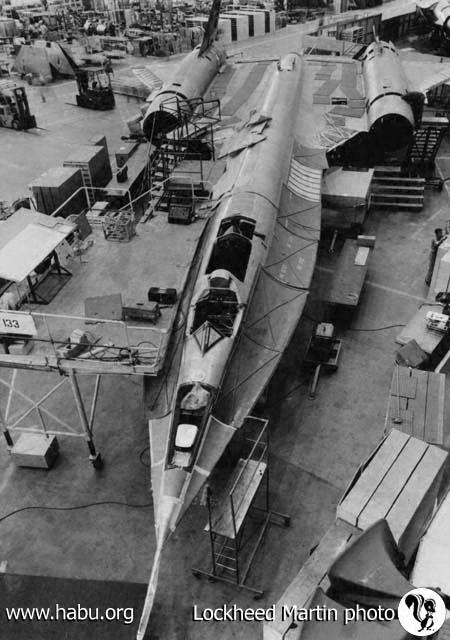
According to the official report, "Aircraft No. 133 [939] was making its final approach to the runway when at altitude of 500 feet and airspeed of 200 knots it began a smooth steady roll to the left. Lockheed test pilot Bill Park could not overcome the roll. At about a 45 degree bank angle and 200 foot altitude he ejected. As he swung down to the vertical in the parachute his feet touched the ground, for what must have been one of the narrower escapes in the perilous history of test piloting. The primary cause of the accident was that the servos for the right ourboard roll and pitch control froze."
Pilot Bill Park ejected safely, only to endure another ejection a few years later in an M/D-21. He is the only pilot with the dubious honor of bailing out of more than one blackbird.
60-6940
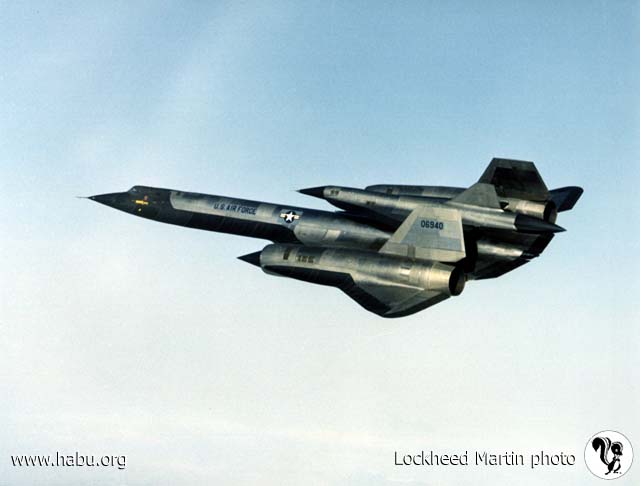
The M/D-21 was one of the few ideas of Kelly Johnson that didn't pan out. The A-12 had originally been conceived as a recon platform that could fly deep into denied air space (e.g. the Soviet Union) and essentially be invulnerable to missile attack (from the first flight of the U-2, it was only a matter of time before Soviet missile technology would make the Dragonlady as vulnerable as any other aircraft). Yet the A-12 was in still in the planning and design stages when Gary Powers got shot down, forcing Eisenhower to sign an agreement with the Soviets that the United States would never fly a manned aircraft over their country again.
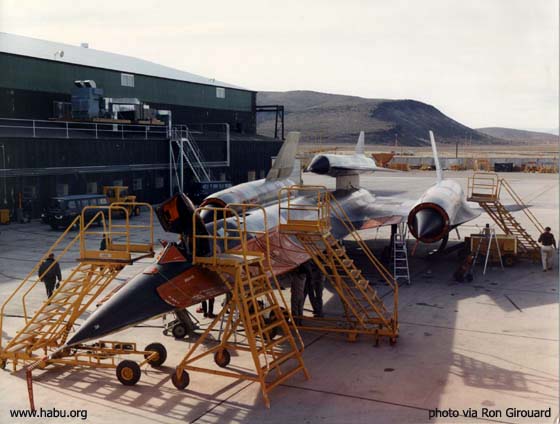
940 at Groom Dry Lake, being prepped for her first D-21 ferry flight. Unlike most similar photos, the mountains in the backbround have not been airbrushed out. - photo via Ron Girouard
This essentially deprived the A-12 of her primary role almost 2 years before her first flight. There had to be a way to make use of the A-12's speed without violating the treaty. A drone is not a manned aircraft, so Kelly figured the A-12 could still do its job if it launched a drone but didn't cross the border itself. Next to the F-117 and HAVE BLUE programs, the D-21 was probably the most secret project ever produced by the Skunkworks. Most people who worked for Lockheed didn't know what the Skunkworks people were up to; most people in the Skunkworks didn't know what the D-21 people were up to!
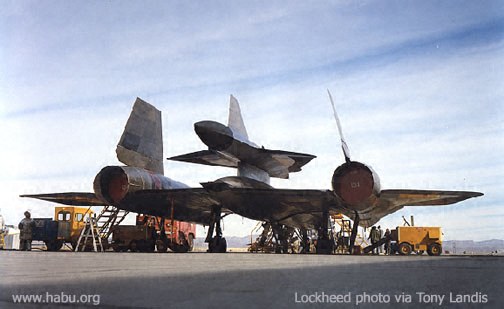
940 being prepped for her first flight -Lockheed photo via Tony Landis
940 was one of 2 airframes built from the ground up as M-21's, to be launch vehicles for the D-21 drone. The designations M-21 and D-21 come from reversing the numbers in A-12, and using M for "mothership" and D for "daughtership." When ferrying the D-21, the combination was called an M/D-21. The D-21 was powered by a Marquardt ramjet engine that had been developed and tested on the unmanned X-7 vehicle. Ramjets are essentially hollow tubes that use the compression of extremely fast air rushing into the inlet instead of a normal compressor/fan combination like a turbojet. As a result, the ramjet engine is useless below Mach 1.25.
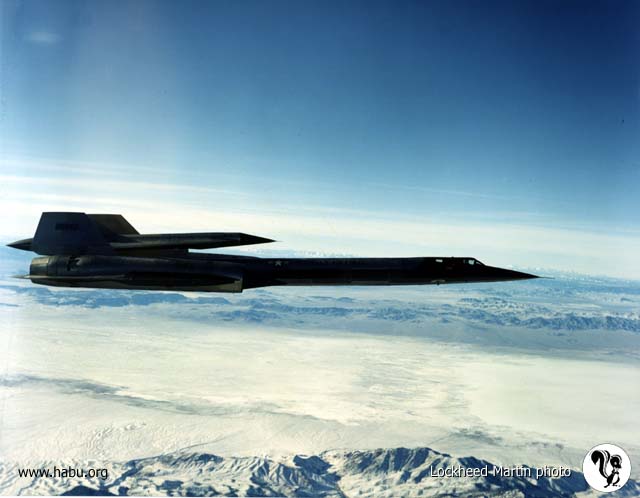
The M/D-21 would take off and fly to speeds above Mach 3 and 80,000 feet. At this speed and altitude, the drone's engine could be ignited and the drone launched from the back of the mothership, to fly along a preprogrammed course, then jettison its camera pack over neutral or friendly territory before self-destructing.
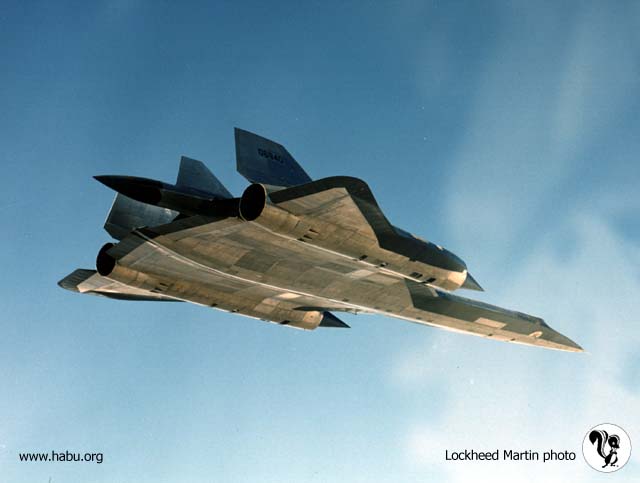
940 carried several D-21s during test flights, but was never used for any launches; instead, she was used as the chase plane for all launches from the other M/D-21, 941.
60-6941
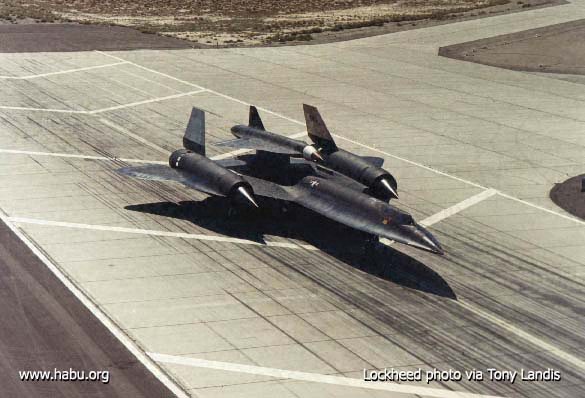
941 about to take off from Groom Dry Lake. She's been fitted with metal rudders from 930, although they've been swapped left for right so the numbers only show on the inside. - Lockheed photo via Tony Landis
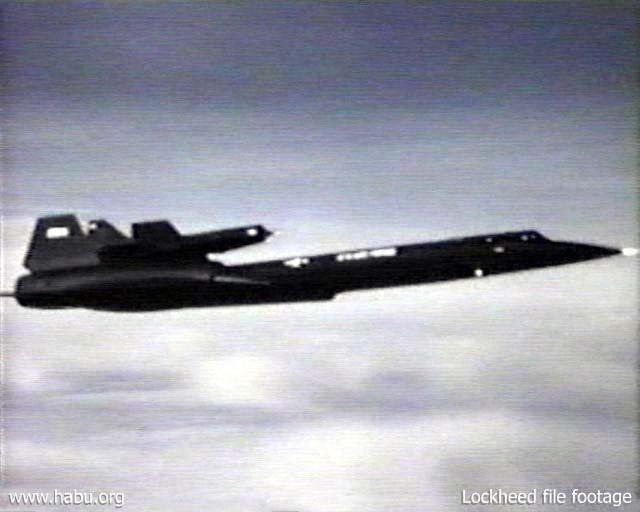
941 was one of two M-21s used as a launch platform for the D-21 drone.
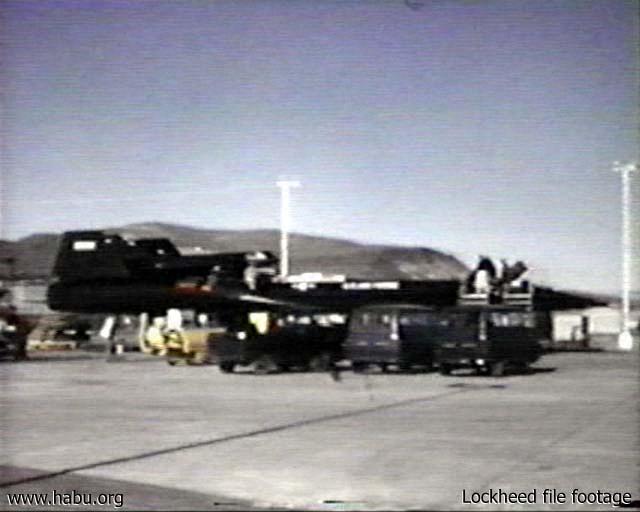
When mated with the drone, the combination was known as an "M/D-21." Contrary to some reports, both 941 and her sister ship 940 were built from the ground up to be M-21s, and were not "converted" from existing A-12s. Unlike 940, 941 was painted all black, and was the only M/D-21 used in actual D-21 launches (all of 940's M/D-21 flights were load and aerodynamic test flights).
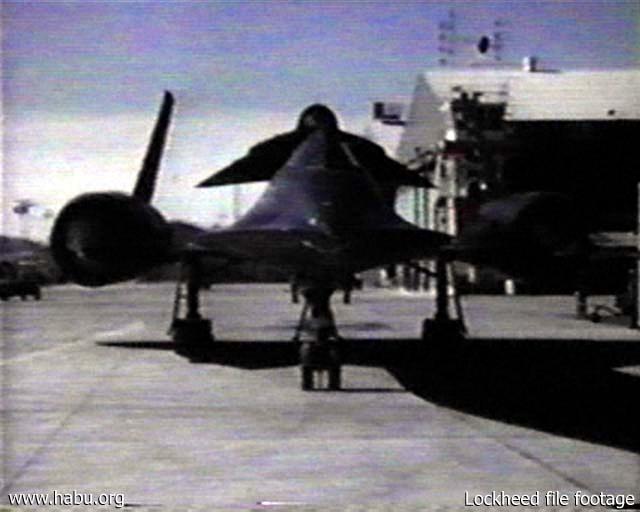
Lockheed file footage showing 941 taxiing with D-21 #506 mounted on back
She was lost on Saturday, July 30, 1966. Prior to this flight, there had been 3 successful D-21 launches from 941, but all 3 had been executed with the mothership in a .9g "dive," flying slightly downward to assist in blackbird/drone separation. If the still-experimental M/D-21 were to be used in combat (real-world) missions, the crew might be under fire from missiles and fighter/interceptors, and so might not have the luxury of launching from a .9g dive. In this fourth launch, the D-21 would separate in a level-flight, 1g configuration.
For the first 2 to 3 seconds of the drone launch, everything went normally. Unfortunately, the drone was not able to penetrate the shock wave coming off the mothership. The D-21 (#504) had almost cleared the M-21's rudders when it encountered the shock wave, bounced off, rolled 45 degrees to the port (left) side, and impacted the mothership almost directly at Station 715, where the forward fuselage attaches to the wing root. Between the impact and resulting explosion, #941 was for all intents and purposes cut cleanly in two.
Lockheed test pilot Bill Park and Launch Control Officer Ray Torick remained in the tumbling wreckage until a lower altitude where they ejected safely, but they landed in the open ocean, and Torick drowned when his pressure suit took on water. Some reports attribute this to Torick prematurely opening the faceplate of his visor, but other informed sources have stated that the bouyancy of the David Clark suits would make this almost impossible. Others have speculated that his suit was torn by schrapnel from the wreckage as he ejected. In either case, no further M/D-21 flights occured; furthermore, a baylor bar was then added to the flight suit helmets to ensure that the faceplate could not accidentally be opened in similar situations.
All M/D-21 operations ended with the death of Ray Torick. All subsequent flights of the D-21 were as D-21B's, which were reconfigured to launch the drone from an underwing pylon of a B-52 (much like the X-15 had been), boosted to Mach 3 by a rocket motor that was jettisoned after the D-21B's Marquardt ramjet was started.
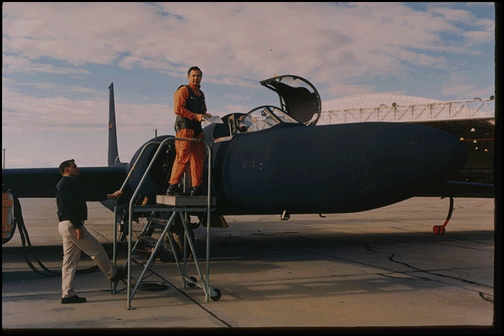
Lockheed test pilot Bill Park, who piloted all M/D-21 flights, shown here boarding a U-2R/TR-1
(photo courtesy Lockheed Martin)
More photos from the web:
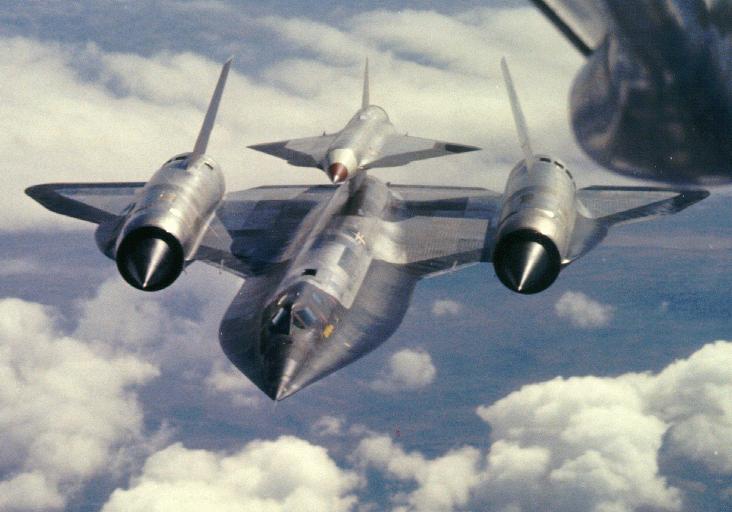
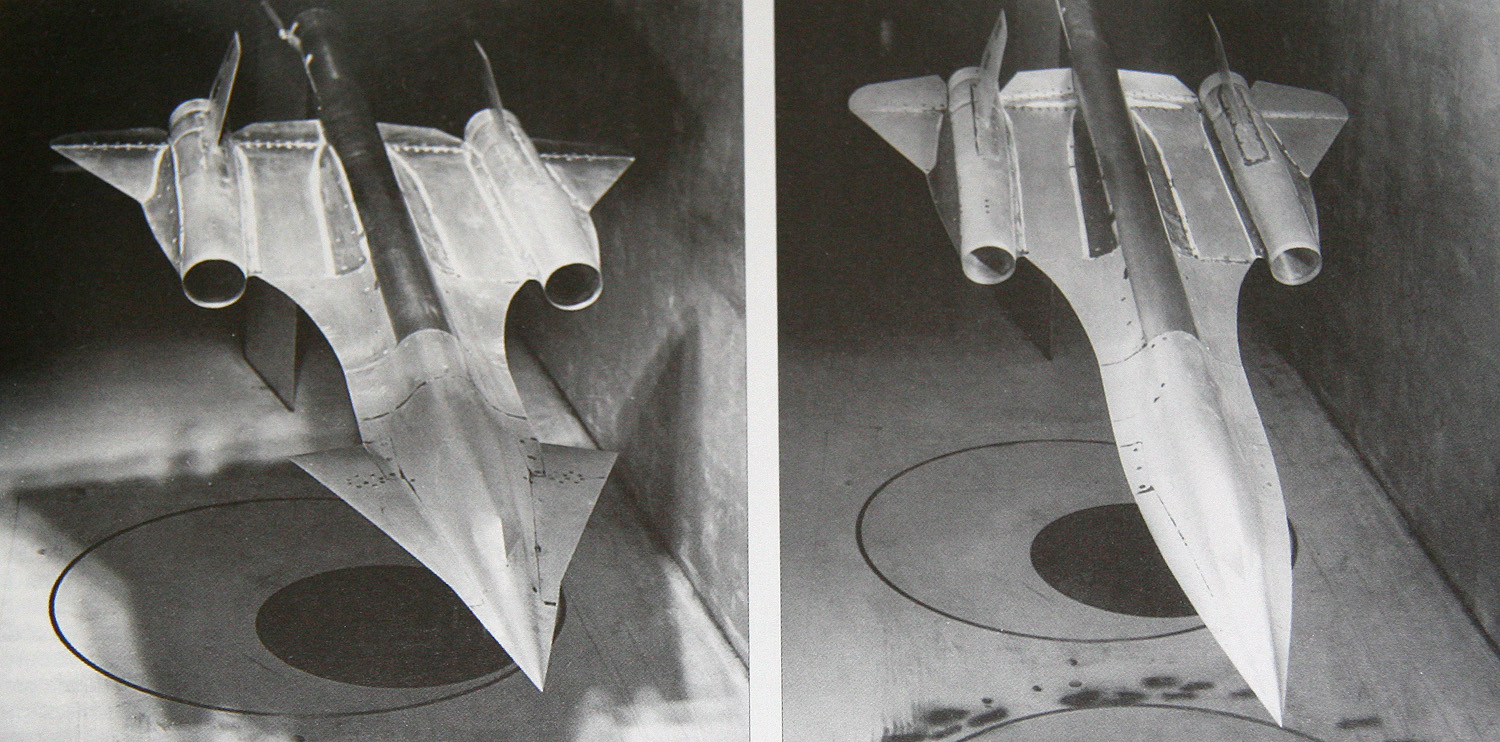

Lockheed A-12 [Article 12, Archangel 12]
From Wikipedia, the free encyclopedia
(Not to be confused with McDonnell Douglas A-12 Avenger II.)
A-12

An A-12 aircraft (Serial Number 06932)
Role: High-altitude reconnaissance aircraft
Manufacturer: Lockheed Corporation
First flight: 25 April 1962
Introduced: 1967
Retired: 1968
Status: Retired
Primary user: Central Intelligence Agency
Number built: A-12: 13; M-21: 2
Variants: Lockheed YF-12
Developed into: Lockheed SR-71 Blackbird
The Lockheed A-12 was a reconnaissance aircraft built for the Central Intelligence Agency by Lockheed's famed Skunk Works, based on the designs of Clarence "Kelly" Johnson. The A-12 was produced from 1962 through 1964, and was in operation from 1963 until 1968. The single-seat design, which first flew in April 1962, was the precursor to both the twin-seat U.S. Air Force YF-12 interceptor and the famous SR-71 Blackbird reconnaissance aircraft. The final A-12 mission was flown in May 1968, and the program and aircraft retired in June of that year.
Design and development
With the failure of the CIA's Project Rainbow to reduce the radar cross section of the U-2, preliminary work began inside Lockheed in late 1957 to develop a follow-on aircraft to overfly the Soviet Union. The designs were nicknamed "Archangel", after the U-2 program, which had been known as "Angel". As the aircraft designs evolved and configuration changes occurred, the internal Lockheed designation changed from Archangel-1 to Archangel-2, and so on. These nicknames for the evolving designs soon simply became known as "A-1", "A-2", etc.[1]
These designs had reached the A-11 stage when the program was reviewed. The A-11 was competing against a Convair proposal called Kingfish, of roughly similar performance. However, the Kingfish included a number of features that greatly reduced its radar cross section, which was seen as favorable to the board. Lockheed responded with a simple update of the A-11, adding twin canted fins instead of a single right-angle one, and adding a number of areas of non-metallic materials. This became the A-12 design. On 26 January 1960, the CIA ordered 12 A-12 aircraft. After selection by the CIA, further design and production of the A-12 took place under the code-name Oxcart.

A-12 during radar testing – mounted inverted.
After development and production at the Skunk Works, in Burbank, California, the first A-12 was transferred to Groom Lake test facility, where on 26 April 1962, Lockheed test pilot Lou Schalk took the A-12 on its shakedown flight. Many internal documents and references to individual aircraft used Johnson's preferred designation, using the prefix, "the Article" for the specific examples. Thus on the A-12's first flight, the subject aircraft was identified as "Article 121". The first official flight occurred on 30 April.[2] On its first supersonic flight, in early May 1962, the A-12 reached speeds of Mach 1.1.
The first five A-12s, in 1962, were initially flown with Pratt & Whitney J75 engines capable of 17,000 lbf (76 kN) thrust each, enabling the J75-equipped A-12s to obtain speeds of approximately Mach 2.0. On 5 October 1962, with the newly developed J58 engines, the A-12 flew with one J75 engine, and one J58 engine. By early 1963, the A-12 was flying with J58 engines, and during 1963 these J58-equipped A-12s obtained speeds of Mach 3.2. Also, in 1963, the program experienced its first loss when, on 24 May, "Article 123"[3] piloted by Kenneth S. Collins crashed near Wendover, Utah.
The reaction to the crash illustrated the secrecy over, and importance of, the project. The CIA called the aircraft an F-105 as a cover story;[4] local law enforcement and a passing family were warned with "dire consequences" to keep quiet about the crash.[3] Each was also paid $25,000 in cash ($179,335 today[5]) to do so; the project often used such cash payments to avoid outside enquiries into its operations.[3] The project received ample funding; contracted security guards were paid $1,000 monthly ($7,173 today[5]) with free housing on base, and chefs from Las Vegas were available 24 hours a day for steak, Maine lobster, or other requests.[3]
In June 1964, the last A-12 was delivered to Groom Lake,[6] from where the fleet made a total of 2,850 test flights.[4] A total of 18 aircraft were built through the program's production run. Of these, 13 were A-12s, three were prototype YF-12A interceptors for the Air Force (not funded under the OXCART program), and two were M-21 reconnaissance drone carriers. One of the 13 A-12s was a dedicated trainer aircraft with a second seat, located behind the pilot and raised to permit the Instructor Pilot to see forward. The A-12 trainer "Titanium Goose", retained the J75 powerplants for its entire service life.[7]
Operational history

A-12 pilots and managers: (l. to r.) Ronald J. “Jack” Layton, Dennis B. Sullivan, Mele Vojvodich Jr, Barrett, Jack W. Weeks, Kenneth B. Collins, Ray, Brig Gen Ledford, Skliar, Perkins, Holbury, Kelly, and squadron commander Col Slater
Although originally designed to succeed the U-2 in overflights over the Soviet Union and Cuba, the A-12 was never used for either role. After a U-2 was shot down in May 1960, the Soviet Union was considered too dangerous except in an emergency (and overflights were no longer necessary[8] due to satellites) and, although crews trained for the role, U-2s remained adequate for Cuba.[9]
After lengthy debate, the CIA decided to deploy the A-12s to Asia. The first A-12 arrived at Kadena Air Base, Okinawa, Japan, on 22 May 1967. With the arrival of two more aircraft (24 May, and 27 May) the unit was declared operational on 30 May, and began Operation Black Shield on 31 May.[10] Mel Vojvodich flew the first Black Shield operation, over North Vietnam, photographing Surface-to-air missile (SAM) sites, flying at 80,000 ft (24,000 m), and at Mach 3.1. From Kadena, during 1967, the A-12s conducted 22 operations in support of the Vietnam War. During 1968, Black Shield conducted operations in Vietnam and also supported the Pueblo Crisis with North Korea. The operational use of the A-12 was nearly a decade after the original conception of the Oxcart program.
During its deployment on Okinawa, the A-12s (and later the SR-71) and by extension their pilots, were nicknamed Habu after a cobra-like Okinawan pit viper which the locals thought the plane resembled.
Retirement

A-12s in storage

Head-on view of an A-12 on the deck of the Intrepid Sea-Air-Space Museum, illustrating the chines
The A-12 program was officially canceled on 28 December 1966[11]—even before Black Shield began in 1967—due to budget concerns[12] and because of the forthcoming SR-71, which arrived in Kadena in March 1968.
Ronald L. Layton flew the 29th and final A-12 mission on 8 May 1968, over North Korea. On 4 June 1968, just 2½ weeks before the retirement of the entire A-12 fleet, an A-12 out of Kadena, piloted by Jack Weeks, was lost over the Pacific Ocean near the Philippines while conducting a functional check flight after the replacement of one of its engines.[12][13] Francis J. Murray took the final A-12 flight on 21 June 1968, to Palmdale, California.
On 26 June 1968, Vice Admiral Rufus L. Taylor, the Deputy Director of Central Intelligence, presented the CIA Intelligence Star for valor to Weeks' widow and pilots Collins, Layton, Murray, Vojvodich, and Dennis B. Sullivan for participation in Black Shield.[12][14][15]
The deployed A-12s and the eight non-deployed aircraft were placed in storage at Palmdale. All surviving aircraft remained there for nearly 20 years before being sent to museums around the United States. On 20 January 2007, despite protests by Minnesota's legislature and volunteers who had maintained it in display condition, the A-12 preserved in Minneapolis, Minnesota, was dismantled to ship to CIA Headquarters to be displayed there.[16]
Timeline
The following timeline describes the overlap of the development and operation of the A-12, and the evolution of its successor, the SR-71.
16 August 1956: Following Soviet protest of U-2 overflights, Richard M. Bissell, Jr. conducts the first meeting on reducing the radar cross section of the U-2. This evolves into Project Rainbow.
December 1957: Lockheed begins designing subsonic stealthy aircraft under what will become Project Gusto.
24 December 1957: First J-58 engine run.
21 April 1958: Kelly Johnson makes first notes on a Mach 3 aircraft, initially called the U-3, but eventually evolving into Archangel I.
November 1958: The Land panel provisionally selects Convair Fish (B-58-launched parasite) over Lockheed's A-3.
June 1959: The Land panel provisionally selects Lockheed A-11 over Convair Fish. Both companies instructed to re-design their aircraft.
14 September 1959: CIA awards antiradar study, aerodynamic structural tests, and engineering designs, selecting Lockheed's A-12 over rival Convair's Kingfish. Project Oxcart established.
26 January 1960: CIA orders 12 A-12 aircraft.
1 May 1960: Francis Gary Powers is shot down in a U-2 over the Soviet Union.
26 April 1962: First flight of A-12 with Lockheed test pilot Louis Schalk at Groom Lake.
13 June 1962: SR-71 mock-up reviewed by USAF.
30 July 1962: J58 engine completes pre-flight testing.
October 1962: A-12s first flown with J58 engines
28 December 1962: Lockheed signs contract to build six SR-71 aircraft.
January 1963: A-12 fleet operating with J58 engines
24 May 1963: Loss of first A-12 (#60–6926)
7 August 1963: First flight of the YF-12A with Lockheed test pilot James Eastham at Groom Lake.
June 1964: Last production A-12 delivered to Groom Lake.
25 July 1964: President Johnson makes public announcement of SR-71.
29 October 1964: SR-71 prototype (#61-7950) delivered to Palmdale.
22 December 1964: First flight of the SR-71 with Lockheed test pilot Bob Gilliland at AF Plant #42. First mated flight of the MD-21 with Lockheed test pilot Bill Park at Groom Lake.
28 December 1966: Decision to terminate A-12 program by June 1968.
31 May 1967: A-12s conduct Black Shield operations out of Kadena
3 November 1967: A-12 and SR-71 conduct a reconnaissance fly-off. Results were questionable.
23 January 1968: Seizure of USS Pueblo
5 February 1968: Lockheed ordered to destroy A-12, YF-12 and SR-71 tooling.
8 March 1968: First SR-71A (#61-7978) arrives at Kadena AB (OL 8) to replace A-12s.
21 March 1968: First SR-71 (#61-7976) operational mission flown from Kadena AB over Vietnam.
8 May 1968: Jack Layton flies last operational A-12 sortie, over North Korea.
5 June 1968: Loss of last A-12 (#60–6932)
21 June 1968: Final A-12 flight to Palmdale, California.
For the continuation of the Oxcart timeline, covering the duration of operational life for the SR-71, see SR-71 timeline.
Variants
Training variant

The only two-seat trainer A-12 built was nicknamed "Titanium Goose". It is on display at the California Science Center.
The A-12 training variant (60-692 "Titanium Goose") was a two-seat model with two cockpits set horizontally with the rear cockpit raised and slightly offset. In case of emergency, the trainer was designed to allow the flight instructor to take control. Other than the modifications required to accommodate the dual controls and new cockpit configuration, the trainer was very similar to A-12 in terms of appearance and performance.
YF-12A
Main article: Lockheed YF-12
The YF-12 program was a limited production variant of the A-12. Lockheed convinced the U.S. Air Force that an aircraft based on the A-12 would provide a less costly alternative to the recently canceled North American Aviation XF-108, since much of the design and development work on the YF-12 had already been done and paid for. Thus, in 1960 the Air Force agreed to take the seventh through ninth slots on the A-12 production line and have them completed in the YF-12A interceptor configuration.[17]
The main changes involved modifying the aircraft's nose to accommodate the Hughes AN/ASG-18 fire-control radar originally developed for the XF-108, and the addition of a second cockpit for a crew member to operate the fire control radar. The nose modifications changed the aircraft's aerodynamics enough to require ventral fins to be mounted under the fuselage and engine nacelles to maintain stability. Finally, bays previously used to house the A-12's reconnaissance equipment were converted to carry missiles.
M-21
See also: Lockheed D-21

A D-21B drone mounted on an M-21
One notable variant of the basic A-12 design was the M-21, used to carry and launch the Lockheed D-21 drone, an unmanned, faster and higher-flying reconnaissance craft. The M-21 was an A-12 platform modified by replacing the single-seat aircraft's Q bay (which carried its main camera) with a second cockpit for a Launch Control Operator/Officer (LCO). When mated to the drone for operations, this variant was known as the M/D-21. The D-21 drone was completely autonomous; having been launched it would overfly the target, travel to a predetermined rendezvous point and eject its data package. The package would be recovered in midair by a C-130 Hercules and the drone would self-destruct.
The program to develop this system was canceled in 1966 after a drone collided with the mother ship at launch, destroying the M-21. The crew survived the midair collision but the LCO drowned when he landed in the ocean and his flight suit filled with water.[18] The D-21 drone performed operational missions over China in 1970 and 1971. The modified D-21B drone was carried on wings of the B-52 bomber.
A-12 aircraft production and disposition
List of A-12s
Serial number
Model
Location or fate
60-6924
A-12
Air Force Flight Test Center Museum Annex, Blackbird Airpark, at Plant 42, Palmdale, California. 606924 was the first A-12 to fly.
60-6925
A-12
Intrepid Sea-Air-Space Museum, parked on the deck of the aircraft carrier USS Intrepid, New York City
60-6926
A-12
Lost, 24 May 1963
60-6927
A-12
California Science Center in Los Angeles, CA (Two-canopied trainer model, "Titanium Goose")
60-6928
A-12
Lost, 5 January 1967
60-6929
A-12
Lost, 28 December 1967
60-6930
A-12
U.S. Space and Rocket Center, Huntsville, Alabama
60-6931
A-12
CIA Headquarters, Langley, Virginia[N 1]
60-6932
A-12
Lost, 4 June 1968
60-6933
A-12
San Diego Aerospace Museum, Balboa Park, San Diego, California
60-6937
A-12
Southern Museum of Flight, Birmingham, Alabama
60-6938
A-12
Battleship Memorial Park (USS Alabama), Mobile, Alabama
60-6939
A-12
Lost, 9 July 1964
60-6940
M-21
Museum of Flight, Seattle, Washington
60-6941
M-21
Lost, 30 July 1966
See Lockheed YF-12 and Lockheed SR-71 Blackbird for other Blackbirds on display.
Specifications (A-12)
Data from A-12 Utility Flight Manual,[19] Pace[20]
General characteristics
Crew: 1 (2 for trainer variant)
Length: 101.6 ft (30.97 m)
Wingspan: 55.62 ft (16.95 m)
Height: 18.45 ft (5.62 m)
Wing area: 1,795 ft² (170 m²)
Empty weight: 54,600 lb (24,800 kg)
Loaded weight: 124,600 lb (56,500 kg)
Powerplant: 2 × Pratt & Whitney J58-1 continuous bleed-afterburning turbojets, 32,500 lbf (144 kN) each
Payload: 2,500 lb (1,100 kg) of reconnaissance sensors
Performance
Maximum speed: Mach 3.35 (2,210 mph, 3,560 km/h) at 75,000 ft (23,000 m)
Range: 2,200 nmi (2,500 mi, 4,000 km)
Service ceiling: 95,000 ft (29,000 m)
Rate of climb: 11,800 ft/min (60 m/s)
Wing loading: 65 lb/ft² (320 kg/m²)
Thrust/weight: 0.56
See also
Lockheed D-21
Related development
Lockheed YF-12
SR-71 Blackbird
Comparable aircraft
Convair Kingfish
References
Notes
1.^ "Article 128", unveiled on Wednesday, 19 September 2007, at CIA Headquarters in Langley, VA. On hand was Ken Collins, a retired Air Force Colonel, one of only six pilots to fly the A-12s.
Citations
1.^ "The U-2's Intended Successor: Project Oxcart 1956–1968". Central Intelligence Agency, approved for release by the CIA in October 1994. Retrieved: 26 January 2007.
2.^ "A-12 First Flight." Lockheed Martin. Retrieved: 13 October 2010.
3.^ a b c d Lacitis, Erik. "Area 51 vets break silence: Sorry, but no space aliens or UFOs." The Seattle Times, 27 March 2010.
4.^ a b Jacobsen, Annie. "The Road to Area 51." Los Angeles Times, 5 April 2009.
5.^ a b Consumer Price Index (estimate) 1800–2008. Federal Reserve Bank of Minneapolis. Retrieved December 7, 2010.
6.^ "SR-71 Blackbird." Lockheed Martin. Retrieved: 13 October 2010.
7.^ Landis and Jenkins 2005, p. 16.
8.^ McIninch 1996, p. 19.
9.^ McIninch 1996, p. 20.
10.^ McIninch 1996, pp. 25–27.
11.^ McIninch 1996, p. 31.
12.^ a b c Robarge, David. "A Futile Fight for Survival. Archangel: CIA's Supersonic A-12 Reconnaissance Aircraft." CSI Publications, 27 June 2007. Retrieved: 13 April 2009.
13.^ McIninch 1996, p. 33.
14.^ McIninch 1996, p. 34.
15.^ Hayden, General Michael V. "General Hayden's Remarks at A-12 Presentation Ceremony." Central Intelligence Agency, Remarks of Director of the Central Intelligence Agency at the A-12 Presentation Ceremony, 19 September 2007. Retrieved: 10 April 2009.
16.^ Karp, Jonathan. "Stealthy Maneuver: The CIA Captures An A-12 Blackbird". The Wall Street Journal, A1, 26 January 2007. Retrieved: 10 April 2009.
17.^ Landis and Jenkins 2005, pp. 40–41.
18.^ "MD-21 crash footage." YouTube. Retrieved: 13 October 2010.
19.^ "A-12 Utility Flight Manual (Copy 15, Version 15 September 1968)." CIA, 15 June 1968. Retrieved: 5 April 2010.
20.^ Pace 2004, pp. 105, 110.
Bibliography
Donald, David, ed. "Lockheed's Blackbirds: A-12, YF-12 and SR-71". Black Jets. Norwalk, CT: AIRtime, 2003. ISBN 1-880588-67-6.
Graham, Richard H. SR-71 Revealed: The Inside Story. St. Paul, Minnesota: MBI Publishing Company, 1996. ISBN 978-0-7603-0122-7.
Jenkins, Dennis R. Lockheed Secret Projects: Inside the Skunk Works. St. Paul, Minnesota: MBI Publishing Company, 2001. ISBN 978-0-7603-0914-8.
Johnson, C.L. Kelly: More Than My Share of it All. Washington, DC: Smithsonian Books, 1985. ISBN 0-87474-491-1.
Landis, Tony R. and Dennis R. Jenkins. Lockheed Blackbirds. Minneapolis, Minnesota: Specialty Press, revised edition, 2005. ISBN 1-58007-086-8.
Lovick, Edward, Jr. Radar Man: A Personal History of Stealth. Bloomington, IN: iUniverse, 2010. ISBN 978-1-45024-802-0.
McIninch, Thomas. "THE OXCART STORY" Center for the Study of Intelligence, Central Intelligence Agency, 2 July 1996. Retrieved 10 April 2009.
Merlin, Peter W. From Archangel to Senior Crown: Design and Development of the Blackbird (Library of Flight Series). Reston, Virginia: American Institute of Aeronautics and Astronautics (AIAA), 2008. ISBN 978-1-56347-933-5.
Pace, Steve. Lockheed SR-71 Blackbird. Swindon: Crowood Press, 2004. ISBN 1-86126-697-9.
Pedlow, Gregory W. and Donald E. Welzenbach. The Central Intelligence Agency and Overhead Reconnaissance: The U-2 and OXCART Programs, 1954 – 1974. Washington, DC: Central Intelligence Agency, 1992. ISBN 0-7881-8326-5.
Rich, Ben R. and Leo Janos. Skunk Works: A Personal Memoir of My years at Lockheed. New York: Little, Brown and Company, 1994. ISBN 0-316-7433.
Shul, Brian and Sheila Kathleen O'Grady. Sled Driver: Flying the World's Fastest Jet. Marysville, California: Gallery One, 1994. ISBN 0-929823-08-7.
Suhler, Paul A. From RAINBOW to GUSTO: Stealth and the Design of the Lockheed Blackbird (Library of Flight Series) . Reston, Virginia: American Institute of Aeronautics and Astronautics (AIAA), 2009. ISBN 978-1-60086-712-5.
From paperlessarchives.com:

OXCART aircraft on the ramp at Groom Lake Area 51 in 1964.
There are ten aircraft in the photo; the first eight are OXCART
machines, and the last two are Air Force YF-12As
HISTORY OF THE A-12
The U-2 dated from 1954. When its development began under the direction of a group headed by Richard M. Bissell of the CIA. Before the U-2 became operational in June 1956, CIA project officials had estimated that its life expectancy for flying safely over the Soviet Union would be between 18 months and two years. After overflights began and the Soviets demonstrated the capability of tracking and attempting to intercept the U-2, this estimate seemed too optimistic. By August 1956, Richard Bissell was so concerned about the U-2's vulnerability that he despaired of its ability to avoid destruction for six months, let alone two years. By the autumn of 1957, Bissell had collected so many ideas for a successor to the U-2, that Bissell asked the Director of Central Intelligence Allen Dulles for permission to establish an advisory committee, which became known as the Land Committee, to assist in the selection process. Bissell also felt that the support of a committee of prominent scientists and engineers would prove useful when it came time to ask for funding for such an expensive project.
The two most prominent firms involved in the search for a new aircraft were the Lockheed Corporation, which had designed the successful U-2, and Convair which was building the supersonic B-58 "Hustler" bomber for the Air force and also working on an even faster model known as the B-58B "Super Hustler". Early in 1958, Richard Bissell asked officials from both firms to submit designs for a high-speed reconnaissance aircraft. During the spring and summer of 1958, both firms worked on designs and concepts without government contracts or funds.
Following extended discussions with Bissell on the subject of a supersonic successor to the U-2, Lockheed's Kelly Johnson began designing an aircraft that would cruise at Mach 3.0 at altitudes above 90,000 feet. On 23 July 1958, Johnson presented his new high-speed concept to Land's advisory committee, which expressed interested in the approach he was taking. At the same meeting, Navy representatives presented a concept for a high-altitude reconnaissance vehicle that examined the possibility of developing a ramjet-powered, inflatable, rubber vehicle that would be lifted to altitude by a balloon and then be propelled by a rocket to a speed where the ramjets could produce thrust. Richard Bissell asked Johnson to evaluate this concept, and three weeks later, after receiving more details from the Navy representatives, Kelly Johnson made some quick calculations that showed that the design was impractical because the balloon would have to be a mile in diameter to lift the vehicle, which in turn would need a wing surface greater than one-seventh of an acre to carry the payload.
In September 1958, the Land committee met again to review all the concepts then under consideration and to narrow out the few that were most practicable. Among the concepts rejected were the Navy's proposal for an inflatable, ramjet-powered aircraft, a Boeing proposal for a 190-foot-long hydrogen-powered inflatable aircraft, and a Lockheed design for a hydrogen-powered aircraft (the CL-400). The committee examined two other Kelly Johnson designs at this meeting, a tailless subsonic aircraft with a very-low-radar cross section (the G2A) and a new supersonic design (the A-2) and did not accept either one, the former because of its slow speed and the latter because of it dependence on exotic fuels for its ramjets and it overall high cost. The committee approved the continuation of Convair's work on a ramjet-powered Mach 4.0 "parasite" aircraft that would be launched from a specially configured version of the B-58B bomber. The design was termed a parasite because it could not take off on its own but needed a larger aircraft to carry it aloft and accelerate it to the speed required to start the ramjet engine. The Convair design was called the FISH.
Two months later, after reviewing the Convair proposal and yet another Lockheed design for a high-speed reconnaissance aircraft (the A-3), the Land committee concluded in late November 1958 that it would indeed be feasible to build an aircraft whose speed and altitude would make radar tracking difficult or impossible. The committee, therefore, recommended that DCI Dulles ask President Eisenhower to approve further pursuit of the project and to provide fund for additional studies and tests.
On 17 December 1958, Allen Dulles and Richard Bissell briefed the President on the progress toward a successor to the U-2. Also present were Land and Purcell from the advisory committee, Presidential Service Advisor James Killian, and Air Force Secretary Donald Quarles. DCI Dulles reviewed the results to the U-2 missions to date and stated his belief that a successor to the U-2 could be used all over the world and "would have a much greater invulnerability to detection"
Bissell then described two competing projects by Lockheed and Convair, noting that the chief question at the moment was whether to use air launch or ground takeoff. The next phase, he added, would be detailed engineering, at the end of which it was proposed that 12 aircraft be ordered at a cost of about $100 million. With funding for the proposed new type of aircraft now available, Richard Bissell asked Lockheed and Convair to submit detailed proposals.
By the summer of 1959, both firms had completed their proposals. In early June, Lockheed submitted a design for the ground-launched aircraft known as the A-11. It would have a speed of Mach 3.2, a range of 3,200 miles, an altitude of 90,000 feet, and a completion date of January 1961. Kelly Johnson had refused to reduce the aerodynamics of his design in order to achieve a greater anti-radar capability, and the A-11's radar cross section, although not great, was substantially larger than that of the much smaller parasite aircraft being designed by Convair.
The Convair proposal called for a small, manned, ramjet-powered, reconnaissance vehicle to be air launched from one of two specially configured B-58B Super Hustlers. The FISH vehicle, a radical lifting body with a very-small-radar cross section, would fly at Mach 4.2 at 90,000 feet and have a range of 3,900 miles. Two Marquardt ramjets would power its Mach 4.2 dash over the target area. Once the FISH decelerated, two Pratt & Whitney JT-12 turbojets would bring it back to base. The ramjet exit nozzles and wing edges would be constructed of Pyroceram, a ceramic material that could withstand the high temperatures of very high speeds and would absorb radio frequency energy from the radar pulses. Convair stated that the FISH could be ready by January 1961.
Convair's proposal depended on two uncertain factors. First and foremost was the unproven technology of the ramjet engines. At the time, no aircraft in existence could carry a large, ramjet-powered aircraft into the sky and then accelerate to sufficient speed for the ramjet engines to be ignited. Since ramjet engines had only been tested in wind tunnels, there was no available data to prove that these engines would work in the application proposed by Convair. The second uncertain factor was the B-58B bomber that was supposed to achieve Mach 2.2 before launching the FISH above 35,000 feet. The version of the B-58 was still in the design stage.
Convair's proposal suffered a major setback in June 1959, when the Air Force canceled the B-58B project. Conversion of the older, slower B-58A into the supersonic launching platform for the FISH was ruled out by the high cost and technical difficulties involved. Moreover, the Air Force was unwilling to part with two aircraft from the small inventory of its most advanced bomber. Even had the B-58B program not been canceled, the FISH proposal would probably not have been feasible. Convair engineers had calculated that the added weight of the FISH would prevent the B-58B from achieving the speed required to ignite the parasite aircraft's ramjet engines.
The Convair proposal was therefore unusable, but the Lockheed design with its high radar cross section was also unacceptable to the Land committee. On 14 July 1959, the committee rejected both designs and continued the competition. Lockheed continued to work on developing a design that would be less vulnerable to detection, and Convair received a new CIA contract to design an air-breathing twin-engine aircraft that would meet the general specifications being followed by Lockheed.
Following recommendations by the Land committee, both Lockheed and Convair incorporated the Pratt & Whitney J58 power plant into their designs. This engine had originally been developed for the Navy's large, jet-powered flying boat, the Glenn L. Martin Company's P6M Seamaster, and was the most powerful engine available. In 1958 the Navy had canceled the Seamaster program, which left Pratt & Whitney without a buyer for the powerful J58 engine.
Although the Land committee had not yet found an acceptable design, it informed President Eisenhower on 20 July 1959 that the search was making good process. Concerned about the U-2's vulnerability to detection and possible interception and aware that the photo satellite project was encountering significant problems, the President gave his final approval to the high-speed reconnaissance aircraft project.
By the late summer of 1959, both Convair and Lockheed had completed new designs for a follow-on to the U-2. Convair's entry, known as the KINGFISH, used much of the technology developed for the F-102, F-106, and B-58, including stainless steel honeycomb skin, planiform wing design, and crew capsule system, which eliminated the need for the pilot to wear a pressurized suit. The KINGFISH had two side-by-side J58 engines inside the fuselage, which significantly reduced the radar cross section. Two additional important design features that contributed to a small radar return were fiberglass engine inlets and wings whose leading edges were made of Pyroceram.
Lockheed's new entry was much like its first, but with several modifications and a new designator, A-12. It too, would employ two of the powerful J58 engines. Lockheed's major innovation in reducing radar return was a cesium additive in the fuel, which decreased the radar cross section of the afterburner plume. This improvement had been proposed by Edward Purcell of the Land committee. Desiring to save weight, Kelly Johnson had decided not to construct the A-12 out of steel. Traditional lightweight metals such as aluminum were out of the question because they could not stand the heat that would be generated as the A-12 flew at Mach 3.2, so Johnson chose a titanium alloy.
On 20 August 1959, Lockheed and Convair submitted their proposals to a joint Department of Defense, Air Force, and CIA selection panel. The two aircraft were similar in performance characteristics, although the Lockheed design's specifications were slightly better in each category. The Lockheed design was also preferable in terms of overall cost. In the vital area of vulnerability to radar detection, however, the Convair design was superior. Its smaller size and internally mounted engines gave it a smaller radar cross section than the Lockheed A-12.
Some of the CIA representatives initially favored the Convair KINGFISH design because of its smaller radar cross section, but they were eventually convinced to support the Lockheed design by the Air Force members of the panel, who believed that Convair's cost over-runs and production delays on the B-58 project might be repeated in this new project. In contrast, Lockheed had produced the U-2 under budget and on time. Another factor favoring the A-12 was security. Lockheed had experience in running a highly secure facility (the Skunk Works) in which all of the key employees were already cleared by the Central Intelligence Agency.
The CIA selected Lockheed's A-12 over a Convair proposal called KINGFISH.
Despite its vote in favor of the Lockheed proposal, the selection panel remained concerned about the A-12's vulnerability to radar detection and therefore required Lockheed to prove its concept for reducing the A-12's radar cross section by 1 January 1960. On 14 September 1959, the CIA awarded a four-month contract to Lockheed to proceed with anti-radar studies, aerodynamic structural tests, and engineering designs. This research and all later work on the A-12 took place under a new codename, Project OXCART, established at the end of August 1959 to replace its more widely known predecessor, Project GUSTO.
By mid-January 1960, Lockheed had demonstrated that its concept of shape, fuel additive, and non-metallic parts would reduce the OXCART's radar cross section substantially. Richard Bissell, however, was very upset to learn that the changes had led to a reduction in the aircraft's performance, which meant it would not be able to attain the penetration altitude he had promised to President Eisenhower. Kelly Johnson then proposed to reduce the aircraft's weight by 1,000 pounds and increase the fuel load by 2,000 pounds, making it possible to achieve the target altitude of 90,000 feet. Afterward, he noted in the project log: "We have no performance margins left; so this project instead of being 10 times as hard as anything we have done, is 12 times as hard. This matches the design number and is obviously right". Johnson, "Archangel log", 21 January 1960.
These changes satisfied Bissell, who notified Johnson on 26 January that the CIA was authorizing the construction of 12 of the new aircraft. The actual contract was signed on 11 February 1960. Lockheed's original quotation for the project was $96.6 million for 12 aircraft, but technological difficulties eventually made this price impossible to meet. Recognizing that fabricating an aircraft from titanium might involve unforeseen difficulties, the CIA included a clause in the contract that allowed costs to be reevaluated. During the next five years, this clause had to be invoked on a number of occasions as the A-12's costs soared to more than double the original estimate.
From the very beginning, it was clear that Lockheed could not test the OXCART aircraft at its Burbank "Skunk Works" facility, where the runway was too short and too exposed to the public. The ideal testing site would be far removed from metropolitan areas, away from civil and military airways, easily accessible by air, blessed with good weather, capable of accommodating large numbers of personnel, near an Air Force installation, and having a runway at least 8,000 feet long. But no such place was to be found.
After considering 10 Air Force bases programmed for closing, Richard Bissell decided on the Groom Lake facility, commonly known as Area 51. Although its personnel accommodations, fuel storage capacity, and runway length were insufficient for the OXCART program, the site's remote location would greatly ease the task of maintaining the program's security, and a moderate construction program could provide adequate facilities. Construction began in September 1960; a C-47 shuttle service ferried work crews from Burbank to Las Vegas and from Las Vegas to the site.
The new 8,500 foot runway was completed by 15 November 1960. Kelly Johnson had been reluctant to have a standard Air Force runway with expansion joints every 25 feet, because he feared the joints would set up undesirable vibrations in the speedy aircraft. At his suggestion a 150-foot wide longitudinal section, each 150 feet long but staggered was used instead. This layout put most of the expansion joints parallel to the direction of aircraft roll and reduced the frequency of the joints.
Additional improvements included the resurfacing of 18 miles of highway leading to the base so that heavy fuel trucks could bring in the necessary fuel. The need for additional buildings on the base was met by the Navy. Three surplus Navy hangers were dismantled, moved, and reassembled on the north side of the base, and more than 100 surplus Navy housing buildings were also transported to Groom Lake, Nevada. All essential facilities were ready in time for the forecast delivery date of the first A-12 on 1 August 1961.
The first A-12, known as Article 121, was assembled and tested at Burbank during January and February 1962. After development and production at the Skunk Works, in Burbank, California, the first A-12 was transferred to Groom Lake test facility, commonly known as Area 51.
Since it could not be flown to the Groom Lake facility, the aircraft had to be partially disassembled and put on a specially designed trailer that cost nearly $100,000. The entire fuselage, without wings, was crated and covered, creating a load 35 feet wide and 105 feet long. To transport this huge load safely over the hundreds of miles to the site, obstructing road signs were removed, trees were trimmed, and some roadblocks had to be leveled. The plane left Burbank on 26 February 1962 and arrived two days later.
Lockheed test pilot Lou Schalk took the A-12 on its shakedown flight. On 25 April 1962, Schalk took "article 121" for an unofficial unannounced flight, which was an old Lockheed tradition. He flew the craft less than two miles at an altitude of about 20 feet and encountered considerable problems because of the improper hookup of several controls. These were promptly repaired and on the next day, 26 April, Schalk made a 40-minute flight. After a beautiful takeoff, the aircraft began shedding the triangular fillets that covered the framework of the chines along the edge of the aircraft body. The lost fillets, which had been secured to the airframe with epoxy resin, had to be recovered and re-affixed, a process that took the next four days.
The first official flight occurred on 30 April. Once the fillets were in place, the OXCART's official first flight took place, witnessed by a number of Central Intelligence Agency officials. This official first flight was also the first flight with the wheels up. Piloted again by Schalk, the OXCART took off at 170 knots and climbed to 30,000 feet. During the 59 minute flight, the A-12 achieved a top speed of 340 knots. Kelly Johnson declared it to be the smoothest first test flight of any aircraft he had designed or tested. On 2 May 1962, during the second test flight, the OXCART broke the sound barrier, achieving a speed of Mach 1.1.
Four more aircraft, including a two-seat trainer, arrived at the testing site before the end of the year. During the second delivery on 26 June 1962, the extra-wide vehicle carrying the aircraft accidentally struck a Greyhound bus traveling in the opposite direction. Project managers quickly authorized payment of $4,890 for the damage done to the bus in order to avoid having to explain in court why the OXCART delivery vehicle was so wide.
On October 5, 1962, with the newly developed J58 engines, the A-12 flew with one J75 engine, and one J58 engine. During 1963 these J58-equipped A-12s obtained speeds of Mach 3.2. Also, in 1963, the program experienced its first Blackbird loss. The first A-12 crash occurred on 24 May 1963, when a detachment pilot, realizing the airspeed indication was confusing and erroneous, decided to eject. The pilot was unhurt, but the plane was destroyed when it crashed near Wendover, Utah. A cover story for the press described the plane as an F-105. All A-12s were grounded for a week while the accident was investigated. The malfunction was found to be caused by ice that plugged up the pitot-static tube used to determine airspeed.
In June of 1964, the last A-12 was delivered to Groom Lake. A total of 18 aircraft were built through the A-12 program production run. Of these, 13 were A-12s, three were YF-12A interceptors for the Air Force (not funded under the OXCART program), and two were M-21s. One of the 13 A-12s was a dedicated trainer aircraft with a second, higher seat.
The YF-12 program was a limited production variant of the A-12 OXCART spy plane designed for the CIA and first flown in 1962. Lockheed was able to convince the U.S. Air Force that an aircraft based on the A-12 would provide a less costly alternative to the recently cancelled North American Aviation XF-108, since much of the design and development work on the YF-12 had already been done and paid for. Thus, in 1960 the Air Force agreed to take the 11th through 13th slots on the A-12 production line and have them completed in the YF-12A interceptor configuration. The main changes involved modifying the aircraft's nose to accommodate the Hughes AN/ASG-18 fire-control radar originally developed for the XF-108, and the addition of a second cockpit for a crewmember to operate the fire control radar. The nose modifications changed the aircraft's aerodynamics enough to require ventral fins to be mounted under the fuselage and engine nacelles to maintain stability. Finally, bays previously used to house the A-12's reconnaissance equipment were converted to carry missiles.
Two more A-12s were lost in later testing. On 9 July 1964, article 133 crashed while landing when a pitch-control servo device froze, rolling the plane into a wing-down position. Ejecting from a altitude of 129 feet, the pilot was blown sideways out of the craft. Although he was not very high off the ground, his parachute did open and he landed during the parachute's first swing. Fortunately he was unhurt, and no news of the accident filtered out of the base. Eighteen months later, on 28 December 1965, article 126 crashed immediately after takeoff because of an improperly wired stability augmentation system. As in the previous crash, the pilot ejected safely, and there was no publicity connected with the crash. An investigation ordered by Director of Central Intelligence John McCone, determined that the wiring error had resulted from negligence, not sabotage.
The A-12 made its first long-range, high speed flight on 27 January 1965. The flight lasted 100 minutes, with 75 minutes of which were flown at speeds greater than Mach 3.1, and the aircraft covered 2,850 miles at altitudes of between 75,600 and 80,000 feet. By this time, the OXCART was performing well. The engine inlet, camera, hydraulic, navigation, and flight-control systems all demonstrated acceptable reliability.
Nevertheless, as the OXCART began flying longer, faster, and higher, new problems arose. The most serious of these problems involved the aircraft's wiring. Continuing malfunctions of the inlet controls, communications equipment, ECM systems, and cockpit instruments were often attributable to wiring failures. Wiring connectors and components had to withstand temperatures above 800 deg. F, structural flexing, vibration, and shock. Such demands were more than the materials could stand. Not all of the OXCART's problems could be traced to material failures, however, and CIA officials believed that careless maintenance by Lockheed employees also contributed to malfunctions.
Concerned that Lockheed would not be able to meet the OXCART's schedule for operational readiness, the Office of Special Activities' Director of Technology met with Kelly Johnson on 3 August 1965 to discuss the project's problems. Johnson not only assigned more top-level supervisors to the project but also decided to go to the base and take charge of the OXCART's development himself. His presence made a big difference, as can be seen in his notes in the project log: "I uncovered many items of a managerial, materiel and design nature.... I had meetings with vendors to improve their operation.... Changed supervision and had daily talks with them, going over in detail all problems on the aircraft.... Increased the supervision in the electrical group by 500%.... We tightened up the inspection procedures a great deal and made inspection stick. It appears that the problems are one-third due to bum engineering.... The addition of so many systems to the A-12 has greatly complicated the problems, but we did solve the overall problem."
By 20 November 1965, the final validation flights for OXCART deployment were finished. During these tests, the OXCART achieved a maximum speed of Mach 3.29, an altitude of 90,000 feet, and sustained flight time above Mach 3.2 of 74 minutes. The maximum endurance test lasted six hours and 20 minutes. On 22 November, Kelly Johnson wrote to the head of the Office of Special Activities, stating, "The time has come when the bird should leave its nest."
Three years and seven months after its first flight in April 1962, the OXCART A-12 was ready for operational use. It was now time to find work for the most advanced aircraft ever conceived and built.
Although the OXCART had been designed to replace the U-2 as a strategic reconnaissance aircraft to fly over the Soviet Union, this use had become doubtful long before the OXCART was ready for operational use. The U-2 Affair of 1960 made Presidents very reluctant to consider overflights of the Soviet Union. Indeed, Presidents Eisenhower and Kennedy had both stated publicly that the United States would not conduct such overflights. In July 1962, Secretary of Defense McNamara told DCI McCone that he doubted that the OXCART would ever be used and suggested that improvements in another overhead reconnaissance program would very likely eliminate the need for the expensive OXCART program. Strongly disagreeing, McCone told McNamara that he had every intention of using OXCART aircraft to fly over the Soviet Union.
McCone raised this issue with President Kennedy in April 1963, at a time when the nation's chief overhead reconnaissance devices were experiencing a great number of failures and the intelligence community was clamoring for better photography to confirm or disprove allegations of the existence of an anti-ballistic missile system at Leningrad. Unconvinced by McCone's arguments for OXCART overflights, President Kennedy expressed the hope that some means might be devised for improving other methods instead.
In the months after the Cuban Missile Crisis the A-12 was never deemed suitable for use over Cuba. As the OXCART's performance and equipment continued to improve, there was renewed consideration of deploying the aircraft overseas, particularly in Asia, where US military activity was increasing. On 18 March 1965, DCI McCone, Secretary of Defense McNamara, and Deputy Secretary of Defense Vance discussed the growing hazards confronting current aerial reconnaissance methods.
In the summer of 1965, after the United States had begun introducing large numbers of troops into South Vietnam, Southeast Asia became another possible target for the OXCART. Because the continued use of U-2s for reconnaissance missions over North Vietnam was threatened by the deployment of Soviet-made surface-to-air missiles, McNamara asked the CIA on 3 June 1965 whether it would be possible to substitute OXCART aircraft for U-2s. The new DCI Adm. William F. Raborn, replied that the OXCART could operate over Vietnam as soon as it passed its final operational readiness tests.
Project BLACK SHIELD, the plan for Far East operations, called for OXCART aircraft to be based at Kadena airbase on Okinawa. In the first phase, three planes would be flown to Okinawa for 60-day periods, twice a year, an operation which would involve 225 personnel. Later there would be a permanent detachment at Kadena. In preparation for the possibility of such operations, the Department of Defense spent $3.7 million to provide support facilities and real-time secure communications on the island by early autumn 1965.
There the matter remained for more than a year. During the first half of 1966, DCI Raborn raised the issue of deploying the OXCART to Okinawa at five separate 303 Committee meetings but failed to win sufficient support. The JCS and PFIAB supported the CIA's advocacy of OXCART deployment. Top State and Defense Department officials, however, thought that the political risks of basing the aircraft in Okinawa-which would almost certainly disclose it to the Japanese-outweighed any gains from the intelligence the OXCART might gather. On 12 August 1966, the divergent views were presented to President Johnson, who upheld the 303 Committee's majority opinion against deployment for the time being.
With operational missions still ruled out, proficiency training remained the main order of business. This led to improvements in mission plans and flight tactics that enabled the detachment to reduce the time required to deploy to Okinawa from 21 days to 15. Records continued to fall to the OXCART. On 21 December 1966, a Lockheed test pilot flew an A-12 for 16,408 kilometers over the continental United States in slightly more than six hours, for an average speed of 2,679 kilometers per hour (which included in-flight refueling at low speeds as low as 970 kilometers per hour). This flight set a record for speed and distance unapproachable by any other aircraft.
On December 28, 1966, the decision was made to terminate A-12 operations by 1 June 1968.
On 5 January 1967, an A-12 crashed after a fuel gauge malfunctioned and the aircraft ran out of fuel short of the runway. The pilot ejected, but was killed, when he could not become separated from the ejection seat. To preserve the secrecy of the OXCART program, the Air Force informed the press that an SR-71 was missing and presumed lost in Nevada. This loss, like the three preceding crashes, did not result from difficulties caused by high-speed, high-temperature flight but from traditional problems inherent in any aircraft.
A proposal was made to have Project Black Shield use the OXCART to collect tactical rather than strategic intelligence. The cause was apprehension in Washington about the possible undetected introduction of surface-to-air missiles into North Vietnam. When President Johnson asked for a proposal on the matter, the CIA suggested that the OXCART be used. While the State and Defense Departments were still examining the proposal's political risks, DCI Richard Helms raised the issue at President Johnson's "Tuesday lunch" on 16 May. Helms got the President's approval, and the CIA put the BLACK SHIELD plan to deploy the OXCART to the Far East into effect later that same day.
In May of 1967, A-12s were flown to Kadena Air Base on Okinawa, Japan and the BLACK SHIELD unit was declared operational. The airlift of personnel and equipment to Kadena began on 17 May 1967, and on 22 May the first A-12 flew nonstop to Kadena in six hours and six minutes, A second aircraft arrived on 24 May. The third A-12 left on 26 May, but the pilot had trouble with the inertial navigation system and communications near Wake Island. He made a precautionary landing at Wake, where a pre-positioned emergency recovery team was located. The problem was corrected and the aircraft continued on its flight to Kadena on the following day.
By 29 May 1967, 13 days after President Johnson's approval, Black Shield was ready to fly an operational mission. On 30 May, the detachment was alerted for a mission on the following day. Mel Vojvodich flew the first Black Shield operation, over North Vietnam. As the takeoff time approached, Kadena was being deluged by rain, but, since weather over the target area was clear, flight preparations continued. The OXCART, which had never operated in heavy rain, taxied to the runway and took off.
The first BLACK SHIELD mission flew one flight path over North Vietnam and another over the demilitarized zone (DMZ). The mission was flown at Mach 3.1 and 80,000 feet and lasted three hours and 39 minutes. While over North Vietnam, the A-12 photographed 70 of the 190 known surface-to-air sites and nine other priority targets. The A-12's ECM equipment did not detect any radar signals during the mission, which indicated that the flight had gone completely unnoticed by both the Chinese and North Vietnamese.
During the next six weeks, there were more alerts for 15 BLACK SHIELD missions, seven of which were flown. Only four detected hostile radar signals. By mid-July 1967, the BLACK SHIELD missions had provided sufficient evidence for analysts to conclude that no surface-to-air missiles had been deployed in North Vietnam. From Kadena, during 1967, the A-12s conducted 22 operations in support of the Vietnam War. During its deployment on Okinawa, the A-12s (and later the SR-71) and by extension their pilots, were nicknamed Habu after a cobra-like Okinawan pit viper which the locals thought the plane resembled.
A typical mission over North Vietnam required refueling south of Okinawa, shortly after takeoff. After the planned photographic passes, the aircraft withdrew for a second aerial refueling in the Thailand area before returning to Kadena. So great was the plane's speed that it spent only 12.5 minutes during a "single-pass" mission, and 21.5 minutes during a "two-pass" mission. Because of its wide 86-mile turning radius, the plane occasionally crossed borders when getting into position for a second pass.
After the aircraft landed, the camera film was removed and sent by special plane to processing facilities in the United States. By late summer, however, an Air Force photo laboratory in Japan began doing the processing in order to place the photo-intelligence in the hands of US commanders in Vietnam within 24 hours of a mission's completion.
On 17 September 1967 one SAM site tracked the vehicle with its acquisition radar but was unsuccessful with its FAN SONG guidance radar. It was not until 28 October that a North Vietnamese SAM site launched a missile at the OXCART. Mission photography documented the event with photographs of missile smoke and its contrail. Electronic countermeasures aboard the OXCART performed well, and the missile did not endanger the aircraft.
During 1968, Black Shield conducted numerous operations in Vietnam and also supported the Pueblo Crisis. In February of 1968, in preparation for the replacement of the A-12 by the SR-71, Lockheed was ordered to destroy all tooling used to create the A-12 Blackbirds. Also during this year, the first SR-71 arrived at Kadena to replace the A-12s. On May 8, over North Korea, the last operational mission of an A-12 was undertaken. Subsequently, all deployed A-12s were sent back to Palmdale, California, where they joined the remainder of the A-12 fleet, and all were placed in storage.
On May 8, Jack Layton flew the final mission of the A-12s, after which they were retired from active service and replaced by the SR-71. In the just over one year duration of Operation Black Shield, the A-12s flew 29 operational sorties. On June 4, shortly after operations ceased and just two-and-a-half weeks before the retirement of the entire A-12 fleet, an A-12 out of Kadena, piloted by Jack Weeks, was lost over the Pacific Ocean near the Philippines while conducting a functional check flight after the replacement of one of the craft's engines. Search and rescue missions found no trace of the plane or its pilot.
On June 21, 1968, pilot Frank Murray took the final A-12 flight, to Palmdale, California.
The OXCART was the last high-altitude reconnaissance aircraft produced for the CIA, although the Office of Special Activities did briefly consider several possible successors to the OXCART during the mid-1960's. The first of these, known as Project ISINGLASS, was prepared by General Dynamics to utilize technology developed for its Convair Divisions earlier FISH proposal and its new F-111 fighter in order to create an aircraft capable of Mach 4-5 at 100,000 feet. General Dynamics completed its feasibility study in the fall of 1964, and OSA took no further action because the proposed aircraft would still be vulnerable to existing Soviet countermeasures. In 1965 a more ambitious design from McDonnell Aircraft came under consideration as Project RHEINBERRY (although some of the work seems to have come under the ISINGLASS designation as well). This proposal featured a rocket-powered aircraft that would be launched from a B-52 mother ship and ultimately reach speeds as high as Mach 20 and altitudes of up to 200,000 feet. Because building this aircraft would have involved tremendous technical challenges and correspondingly high costs, the Agency was not willing to embark on such a program at a time when the main emphasis in overhead reconnaissance had shifted from aircraft to satellites. As a result, when the OXCART program ended in the summer of 1968, no more advanced successor was waiting in the wings, only the veteran U2.
Intended to replace the U-2 as a collector of strategic intelligence, the OXCART was never used for this purpose, its brief deployment was strictly for obtaining tactical intelligence and its photographic product contributed very little to the CIA's strategic intelligence mission. By the time OXCART became operational other reconnaissance methods had filled the role originally conceived for it. The most advanced aircraft of the 20th century had become an anachronism before it was ever used operationally. On 26 January 1967 Kelly Johnson noted in his "Archangel log": I think back in 1959, before we started this airplane, in discussions with Dick Bissell where we seriously considered the problem of whether there would be one more round of aircraft before the satellites took over. We jointly agreed there would be just one round and not two. That seems to have been a very accurate evaluation, as it seems that 30 SR-71's gives us enough overflight reconnaissance capability and we don't need the additional 10 Oxcart aircraft.
The OXCART did not even outlast the U-2, the aircraft it was supposed to replace. The OXCART lacked the quick-response capability of the smaller craft: a U2 unit could be activated overnight, and within a week it could deploy abroad, fly sorties, and return home base. The OXCART planes required precise logistic planning for fuel and emergency landing fields, and their inertial guidance systems needed several days for programming and stabilization. Aerial tankers had to be deployed in advance along OXCART's flight route and be provisioned with the highly specialized fuel used by the J58 engines. All of this required a great deal of time and the effort of several hundred people. A U-2 mission could be planned and flown with a third fewer personnel.
Although the OXCART program created a strategic reconnaissance aircraft with unprecedented speed, range, and altitude, the program's most important contributions lay in other areas: aerodynamic design, high-impact plastics, engine performance, cameras, electronic countermeasures, pilot life-support systems, anti-radar devices, use of nonmetallic materials for the major aircraft assemblies, and improvements in milling, machining, and shaping titanium. In all of these areas, the OXCART pushed back the frontiers of aerospace technology and helped lay the foundation for future "stealth" research.
And, from habu.org:
60-6924

The first A-12, 60-6924, dumping fuel during an early test flight - photo courtesy of Tony Landis
The first blackbird wasn't even black.
Most people who know about the blackbird, or at least don't mistake it for "the stealth," are familiar with the SR-71. What many don't realize is that the SR-71 was the last in a series of aircraft based on the same airframe concept. The first in that series was the A-12 (not to be confused with the US Navy's A-12 Avenger, otherwise known as the Flying Dorito). Lockheed's A-12 was an internal designation that was never adopted by the Air Force, primarily because it was built for the CIA.
The A-12 was built under the codename Archangel, since it was a follow-on to the U-2 which had been built under the codename Angel. The first concept in the Archangel program was called the A-1, the next A-2, and so on. Those who hold the opinion that everything Kelly Johnson and his Skunkworks team touched turned to gold, might be disillusioned to know that the aircraft didn't start to resemble the final configuration until about the 7th design. The original concept more closely resembled a grossly oversized F-104, and would have been fueled by liquid hydrogen.

Another fuel dump from the same flight; this photo is unusual in that it shows an F-101 flying chase -- in most pics, if a chase plane is shown at all, it's usually an F-104 - photo courtesy of Tony Landis
The first flight of an A-12 took place on April 26, 1962, less than 30 months after the CIA gave Lockheed the go-ahead on the project. Considering that everything on the airplane, including the engines, airframe materials, fuels, lubricants, fluids, tires, and navigation systems, had to be designed from scratch, then considering that there was no "prototype," the A-12 will probably remain for all time as the single greatest leap in aviation technology, ever.
60-6924

924 takes off on her official maiden flight, flown by Lou Schalk - Lockheed photo via John Stone
The first "flight" was an accidental takeoff during a high-speed taxi test on April 26, 1962. Pilot Lou Schalk recalls:
"It was determined that we would make a high-speed taxi test going down our 8000-foot concrete runway towards the Groom Lake bed which had probably 4-5 miles of lake bed suitable for landing beyond the end of the runway, so that seemed like a safe direction to go. The idea was that as I reached takeoff speed was to lift it off the ground and set it back down to see how it felt.
"Well, when we went down the runway and hit takeoff speed and lifted off, it was immediately out of control. It was oscillating longitudinally and laterally. It was obvious the airplane was very unstable. We did not have the damper systems on; no one ever turned the damper systems on on the first flight because you didn't trust them!
"Finally I got hold of it, set it back down on the ground, and was probably a mile or so out on the lakebed at that point in time. Immediately disappeared into a cloud of dust. The tower called to see if I was all right. I replied 'I'm fine, I'm rolling out to slow down and turn around and taxi back.' The tower couldn't hear me becaue the antenna for my UHF transmitter was on the bottom of the fuselage and was blanked out for the direction of the tower's line of sight. So no one knew what was happening and in the dust kept waiting for the burst of flames as I ran into the mountains. After I turned the corner, if Kelly Johnson hadn't already had a heart attack, he probably breathed a sigh of relief. I taxied back in, and we talked about it that night...I said, 'Why don't we turn the dampers on before we try this again?' We all agreed that was a very good idea!

Another fuel dump from the same flight - photo courtesy of Tony Landis
"I still didn't know what had gone wrong, but I did know we had 12 to 15 thousand pounds of fuel on board for the taxi test. Flying an F-104, that's an awful lot of fuel, that's more that it carries, but we carried 76,000 pounds of fuel so we hardly had anything at all. It was all in the back end. The airplane was statically unstable, which meant that anytime you move the controls or if the airplane had any movement, you had to make a correctional movement with the controls to stop it, otherwise it would keep right on going; where if the airplane is stable, that means it will tend to return to its normal position, say if it hits some rough air or something like that. This is because of the center of gravity and its location to the center of pressure, which is usually about the midpoint of the wing.
"We had so much fuel in the back end of the airplane that the center of gravity was about 3 percent beyond the aft limit, and we were terrifically unstable. On the actual flight where we got airborne and stayed there, we were probably 3 percent forward of where our normal fuel loading would be. The reason that happened was that the ground crew and most of the people who were getting the airplane ready for this taxi test didn't know that we had decided to lift off the airplane and set it back down again that night except for Kelly, myself and the flight test engineer...no one told them!"

60-6924 completing her "official" maiden flight, April 30, 1962, flown by Lou Schalk - Lockheed photo via John Stone



60-6925

925 in flight - photo courtesy of the Tony Landis collection


60-6925 is the only Blackbird to rest on a carrier flight deck - the USS Intrepid Flight Museum in New York City's harbor.



You'll have to take their word for it that this is 925 - her tail is completely unmarked (annoying but historically accurate, since many of the A-12s flown from Kadena had ficticious tail numbers or no markings at all)


a blackbird and the Empire State Building in the same photo
60-6926

In addition to the placard on the gantry, the serial number is also stenciled on the bulkhead behind the headrest in the cockpit.

926 was lost in the first Blackbird accident. On Friday, May 24, 1963, she crashed due to instrument failure. Pilot Ken Collins was unharmed. The crash occured near Wendover, Utah.

926 in flight -photo courtesy of the Tony Landis collection
60-6927

927 takes off from Groom Dry Lake - photo courtesy of the Tony Landis collection

A rare glimpse of 927 from a chase plane - Lockheed photo courtesy of the Tony Landis collection

Also known as the "Titanium Goose," #927 was the only "B-model" in the A-12 series.

Clarence L. "Kelly" Johnson, about to get the first "check ride" in 927 with Lockheed test pilot Lou Schalk. Contrary to some reports, this was not the only time he flew in a blackbird; in his book Kelly: More than My Share of It All", Johnson states that he was also in the back seat of a YF-12 on one of the missile test firings.
60-6928
928 on the runway at Groom Dry Lake - photo courtesy Lockheed Martin
928 was lost on Thursday, January 5, 1967. She ran out of fuel (due to a faulty fuel gauge) and crashed while on approach to Groom Dry Lake. CIA pilot Walt Ray ejected but did not survive. For a detailed account of the crash, and one man's 27-month quest to find the site, visit Tom Mahood's The Hunt for 928. This page was updated on June 28, 1999 - definitely worth a second look!
Ray Scalise was a Fire Control Officer on the YF-12 during the early test program at Groom Dry Lake, and knew Walt Ray personally. Click here to download an html book from Ray with recollections about Walt and his last flight.
60-6929

8 A-12s and 2 YF-12s lined up on the ramp at Groom Dry Lake. 929 is the fourth aircraft in line, to the left of 924, the Titanium Goose (927), and 928. - photo courtesy of Lockheed Martin
929 was lost on Tuesday, December 28, 1965. The newly-installed SAS (Stability Augmentation System) had the connections wired backwards, causing the airplane to lose complete control just seconds after takeoff from Groom Dry Lake; pilot Mele Vojvodich ejected safely at an altitude of 150 feet. All future SAS installations used polarized connectors. You live, you learn.
60-6930

photo courtesy Glen Overby
.gif)
06930 is on display at the U.S. Space and Rocket Center near Huntsville, Alabama.
She bears the same markings as the YF-12s flown by NASA from 1969 thru 1979. However, none of the A-12s were ever flown by NASA.
60-6931

photo courtesy of Jim Goodall
06931 was on display at the Minnesota Air National Guard Museum in Minneapolis.

Her wings severed by an acetalyne torch, an unflyable 931 is loaded onto another Lockheed wonder, the C-5A Galaxy, at Lockheed's facility in Palmdale on October 27, 1991. At 102 feet, this was the longest load ever put inside another aircraft up to that time. While several other A-12s and SR-71s also had their wing spars cut in order to transport them to museums, many were spared this fate: 924, 925, 927, and 940 in particular. - Lockheed Martin photo

When the A-12s were briefly operated out of Kadena AFB in Okinawa, Japan, it wasn't unusual for them to be marked with false tail numbers, red numbers, or no markings at all. This was to confuse spies and spotters who tried to figure out how many of these black aircraft were being operated, and what their range and performance was. - photo courtesy of Jim Goodall

Once delivered to her new home, Article 128 was completely repainted and restored. -photo courtesy of Jim Goodall

photo courtesy of Jaimie Bahl
In 2006, amidst a storm of controversy, 931 was removed from the MNANG museum to be relocated at the CIA headquarters in Langley, VA. She was delivered in September 2007, and dedicated at a ceremony with several key figures in attendance, including A-12 pilot Ken Collins.
60-6932
Photo courtesy Lockheed Martin
This Lockheed photo of 932 is about the only thing left of her. She went down into the sea near the Phillipines on Wednesday, June 5, 1968 (NOTE: the official report says June 4, but most other sources say it was June 5), after exploding in flight at Mach 3 during a checkflight prior to returning her stateside. Although he didn't realize it at the time, Don Person (one of the first crew chiefs of the SR-71, and among the first group to be assigned to Det-1 at Kadena AFB), was one of the last people to seek Jack Weeks alive. He recalls:
Our KC-135Q tanker was inbound from Beale AFB on 5 June. Before landing we were gathered together and notified that upon landing we would see things we probably were not aware of and not to talk about what we would see (otherwise on a "need to know basis"). The tanker landed and spotted in a revetment. Once the large cargo door was opened and steps were in place we departed to the flight ramp. As soon as we were on the ground I heard the sound of J58 engines coming down the taxiway. As 06932 passed the tanker I noticed this was no ordinary SR-71: no RSO canopy, and red numbers [on one side, white tail numbers on the other]. Just seeing the red numbers instead of the SR-71 white was enough to say this was not a Beale SR-71. We watched it taxi to the active runway and departed a short time later. I can remember we all looked at each other in amazement but did not discuss it as previously advised.
Rumors soon circulated that this aircraft was missing. SR-71 #974 (which I was crew chief of) was generated for flight and flew the next day. Her mission was to look for the missing aircraft. No such luck. Months later, I found out about the A-12 aircraft and put two and two together.
Not until several years ago did I see another A-12; landing at San Diego you can see one in the Balboa Park. Also driving by the battleship Alabama museum in Mobile Bay I also saw what I thought was a SR-71 on display. Again not true, it also is an A-12.
Because no trace of neither 932 nor her pilot, Jack Weeks, was ever found, some have speculated that Weeks "defected to the other side." These rumors are completely groundless, as Peter Merlin states in this August 1999 posting to the Skunkworks Mailing List: (reprinted by permission)
Date: Sun, 15 Aug 1999 02:28:37 EDT
From: Xelex@aol.com
Reply-To: skunk-works@netwrx1.com
To: skunk-works@netwrx1.com
Subject: Re: Birdwatcher and lost A-12
Here is some information on the Birdwatcher system and the loss of A-12 #129. Please excuse the length of this post (or rejoice in it).
The Birdwatcher constantly monitored various vital aircraft system functions, as well as equipment functions. If and when established limits and equipment activity were sensed, the Birdwatcher would key and modulate the HF transmitter with a coded signal. The coded signal was a multiplexed sample of each monitored item, including the item which triggered the Birdwatcher. Thus, the intended receiver operator could determine which aircraft system or equipment triggered the unit and could monitor the status of all remaining items. There were 40 channels available, though not all were necessarily used.
The system was controlled from the cockpit with a control panel shared with the ECM and SIP controls on the righthand console. The Birdwatcher unit utilized the HF transmitter, and was located in the lower right side of the E-Bay, just behind the A-12 cockpit (C-Bay). Items monitored by Birdwatcher included generator fail, transformer fail, altitude low, fuel quantity low, destruct active, fuel flow low, hydraulic pressure low, System "A" and "B" active, "A" and "B" hydraulic pressure low, oxygen pressure low, compressor inlet temperature high, System "B" manual jam on, pitch and yaw acceleration, cockpit pressure low, seat ejected, Code "A" and "B", angle of attack high, fire warning, System "C" and "F" activity, oil pressure low, and EGT [Exhaust Gas Temperature] High Derich on.
If the Birdwatcher sensed a system limit or equipment activity, it would key the HF tranmsitter and transmit three short, consecutive half-second bursts, each separated by a five-second quiet period. During each burst, the condition of all monitored items , as well as aircraft identity, was transmitted. Upon transmission, the pilot heard three "chirps" in his headset, and an activity light illuminated on the Birdwatcher control panel. "Code A" and "Code B" switches on the panel could be used to retrigger the Birdwatcher to indicate pilot awareness of Birdwatcher operation. By prearrangement, activation of the "Code A" switch could indicate "pilot aware - no emergency." In that case, "Code B" switch activation might indicate "pilot aware - emergency condition."
Having transmitted, the Birdwatcher would not key the HF transmitter again until another system limit was reached or another equipment activity was sensed, or if the original triggering system returned within limits and exceeded them again.
On 4 June 1968, Mr. Jack Weeks flew A-12 (#129) on a redeployment preparation and functional check flight due to replacement of the right engine. Taxi and takeoff were uneventful, as evidenced by the reception of the required Birdwatcher "Code A" transmission and the lack of any HF transmissions from the pilot. Refueling, 20 minutes after takeoff, was normal. At tanker disconnect, the A-12 had been airborne 33 minutes. The tanker crew observed the A-12 climbing on course in a normal manner. This was the last visual sighting of the aircraft. No further communications were received until 19 minutes later when a Birdwatcher transmission indicated right engine EGT was in excess of 860 degrees C. Seven seconds later, Birdwatcher indicated the right engine fuel flow was less than 7500 pounds per hour and repeated that EGT exceeded 860. Eight seconds later, Birdwatcher indicated that the A-12 was below 68,500 feet, and repeated the two previous warnings. This was the final transmission.
Several attempts were made to contact Weeks via HF-SSB, UHF, and Birdwatcher, but without success. Operation of recording and monitoring facilities at the home base continued until the time that the aircraft's fuel would have been exhausted, but no further transmissions were received. The aircraft was declared missing some 500 nautical miles east of the Phillipines and 600 nautical miles south of Okinawa. The accident report declared that "No wreckage of aircraft number 129 was ever recovered. It is presumed totally destroyed at sea."
Peter W. Merlin
The X-HUNTERS
Aerospace Archeology Team
60-6933

933 is displayed mounted on three pedestals in front of the Aerospace Historical Center in San Diego, California.
photos courtesy John Freedman
60-6934

This Lockheed photo was the very first one published of ANY blackbird. Until 2 YF-12s were unveiled at Edwards AFB in late 1964, this was all that anyone knew about the blackbird.

Another photo of 934, taken during the same flight as the one above - Lockheed photo via Tony Landis

934 was severely damaged as a result of internal systems overheating during a test flight from Edwards AFB on August (or July) 14, 1966. The airframe remained intact but the damage to internal systems was beyond repair. What happened to the forward section is anybody's guess, but the aft end lives on as part of SR-71C #981.
60-6935

USAF photo

YF-12A #935 on the ramp at NASA FRC, April 28, 1971 - photo courtesy of NASA
YF-12 radar systems engineer Ray Scalise recalls one adventure in 935, during the US Air Force's test program:
"One of the things that was done to the YF12As at Edwards was to paint a white cross on the bottom of the aircraft to make it visible against the black sky so it could be spotted by a ground observer who was stationed on the hangar roof during missions (they used high power binoculars). He was in radio contact with the engineers in the radio room in the hangar.
"On one mission the observer said he did not need the binoculars to see the airplane because he could see the "contrail." Airplanes con at 35,000 ft, NOT AT 80,000 ft. At about the same time my pilot noted we were losing fuel at a very high rate. He guessed a fuel line to the left engine had burst and was feeding raw fuel into the engine. He immediately declared an emergency, throttled back on the engines and began a spiral descent to Edwards since we were right overhead. I kept my hands on the eject handle in case the airplane decided to explode. We landed OK and when the plane stopped the base commander was there with his car. Emergency vehicles had not arrived on the scene yet, so the base commander drove up to the plane on the right side by the cockpits.
"Both the pilot and I egressed the aircraft by jumping on the roof, then the hood of the car and started to run away from the bird. It looked like it had just come out of a car wash and was leaking fuel all over the runway. I still do not know why it did not explode. YEAH, the fuel was of low volatility, but come on!
"Anyway, because I was carrying almost double my weight (the pressure suit weighs 35 lbs and the parachute weighs 70 lbs; I only weighed 120 lbs), I was concerned about falling off the airplane and breaking my neck. SO...I walked down the chine on my spurs to keep from slipping on the wet skin (the spurs were strapped to your boots, and were used to hook into cables on the seat which were designed to pull your feet back into the seat to prevent leg loss during an ejection). In doing so I punched a couple of holes in the upper chine skin. Thus, I have always contended I "signed my signature" to the plane.
"If you are ever in Dayton, Ohio at the air museum, there you can see the patches on the upper chine, right side by the rear cockpit where they repaired my 'signature.'"
NASA crewmen Fitz Fulton and Don Mallick with 935 - NASA photo via Tony Landis
More photos are available at NASA's web site and our NASA/Dryden Mirror Page.
935's last final approach - photo courtesy of Lockheed Martin
The only surviving YF-12A, 935 was delivered to the U.S. Air Force Museum at Wright-Patterson AFB near Dayton, Ohio, by Col. Jim Sullivan and Col. Richard Uppstrom on Wednesday, November 7, 1979, and has been on permanent display ever since. The museum is also home to an SR-71 (61-7976).
60-6936

photo courtesy of NASA/Dryden
On Saturday, May 1, 1965, YF-12A #60-6936 was used to set several speed and altitude records (notice the white reference cross just visible on the underside of the engine near the landing gear). This was "coincidentally" the Russian New Year, and 5 years to the day that Gary Powers was shot down flying his U-2 over the Soviet Union. The plan was to have 2 airframes (936 and 934) each set different records, but 934 developed problems at the last minute, and so 936 was used to set all of the following records that day:
photo courtesy of Lockheed Martin
Date Record Crew
1 May 1965 World absolute and class records for speed over a 15/25 km straight course:
2,070 mph
World absolute and class records for sustained altitude (horizontal flight):
80,258 ft Col. Fox Stephens and LtCol. Daniel Andre
1 May 1965 World absolute and class records for speed (500 km closed circuit):
1,643 mph Maj. Walt Daniel and Maj. Noel Warner
1 May 1965 World absolute and class records for speed (1,000 km closed circuit):
1,689 mph Maj. Walt Daniel and Capt. James Cooney
Source: Lockheed Martin press release, Sept. 1991
She was still wearing that cross when she was lost on Thursday, June 24, 1971. On approach to Edwards Air Force Base, a fire broke out from a ruptured fuel line and quickly engulfed the entire left engine. Pilot Lt.Col. Jack Layton and Systems Operator Billy Curtis ejected safely, but the aircraft was a total loss. Shortly thereafter, SR-71 #951 was reassigned the bogus tail number 06937, redesignated as a "YF-12C", and continued with NASA's YF-12 program until its conclusion in 1979.
60-6937


A-12 number 06937 had been "displayed" at the Lockheed Martin Skunk Works in Palmdale, California behind a 12' chain link fence, visible from the guard's station at the entrance but off limits to the public. In February of 2000 she was transported by WorldWide Aircraft Recovery to her new home at the Southern Museum of Flight in Birmingham, Alabama. Of the 13 A-12s originally built, only 8 remain and now 3 of them are in Alabama--only California has as many.


There were two Blackbirds designated as 06937. This A-12 (Lockheed/CIA article #131, USAF serial number 60-6937) on display in Birmingham was the first.
"....It was the first A-12 to be deployed to Kadena AFB in Operation Black Shield. It also flew the first of 29 A-12 operational missions over North Vietnam May 22, 1967, as well as the last operational Black Shield mission, in support of the AGER-2 USS Pueblo May 8, 1968. It made its last flight June 21, 1968, the final [of any] A-12 flight. This aircraft flew just 345.75 hours in 177 flights, while the entire A-12 fleet had flown only 4,804.38 hours in 2,083 flights." - William J. Simone, Lockheed Skunk Works Star, March 26, 1999 (quoted with permission)
photo by Charles W. Arrington courtesy of John Stone
60-6937 as she is now displayed at the Southern Museum of Flight
--------------------------------------------------------------------------------

"The Other 937"
In 1971, SR-71 #17951 was loaned to NASA to complete the testing of the YF-12A program (2 of the 3 YF-12s had already been lost in accidents). 951 was temporarily redesignated as a YF-12C (there being no B-model trainer for the YF-12 series) and given NASA#937. This number was chosen for 2 reasons:
the Air Force didn't want anyone to know that NASA had an honest-to-goodness SR-71 in their possession, and made up the "YF-12C" designation to hide the fact. Since the other 3 YF-12s bore numbers 934, 935, and 936, it made sense that the next aircraft in the series would be numbered 937.
The entire A-12 program was classified until 1982, and since no one would have known there was another 937, there would be no confusion.
On October 27, 1978, she was returned to the Air Force and given back her old number. She logged her final flight two months later, on December 22, 1978.
60-6938

938 prepares to take the runway in this rare glimpse of an A-12 in action - photo courtesy Lockheed Martin
Lockheed article #132 on the nose identifies this A-12 as #60-6938 - photo courtesy John Freedman
938 is on permanent display at the USS Alabama Battleship Memorial Park near Mobile, Alabama. She has been repainted and moved indoors since the above photo was taken.

Photo courtesy Bill Kistler
60-6939
.jpg)
photo courtesy Lockheed Martin
Photos of this particular bird are extremely rare, as she had less than 9 hours of flight time accumulated when she crashed on approach to Groom Dry Lake on Thursday, July 9, 1964.

According to the official report, "Aircraft No. 133 [939] was making its final approach to the runway when at altitude of 500 feet and airspeed of 200 knots it began a smooth steady roll to the left. Lockheed test pilot Bill Park could not overcome the roll. At about a 45 degree bank angle and 200 foot altitude he ejected. As he swung down to the vertical in the parachute his feet touched the ground, for what must have been one of the narrower escapes in the perilous history of test piloting. The primary cause of the accident was that the servos for the right ourboard roll and pitch control froze."
Pilot Bill Park ejected safely, only to endure another ejection a few years later in an M/D-21. He is the only pilot with the dubious honor of bailing out of more than one blackbird.
60-6940

The M/D-21 was one of the few ideas of Kelly Johnson that didn't pan out. The A-12 had originally been conceived as a recon platform that could fly deep into denied air space (e.g. the Soviet Union) and essentially be invulnerable to missile attack (from the first flight of the U-2, it was only a matter of time before Soviet missile technology would make the Dragonlady as vulnerable as any other aircraft). Yet the A-12 was in still in the planning and design stages when Gary Powers got shot down, forcing Eisenhower to sign an agreement with the Soviets that the United States would never fly a manned aircraft over their country again.

940 at Groom Dry Lake, being prepped for her first D-21 ferry flight. Unlike most similar photos, the mountains in the backbround have not been airbrushed out. - photo via Ron Girouard
This essentially deprived the A-12 of her primary role almost 2 years before her first flight. There had to be a way to make use of the A-12's speed without violating the treaty. A drone is not a manned aircraft, so Kelly figured the A-12 could still do its job if it launched a drone but didn't cross the border itself. Next to the F-117 and HAVE BLUE programs, the D-21 was probably the most secret project ever produced by the Skunkworks. Most people who worked for Lockheed didn't know what the Skunkworks people were up to; most people in the Skunkworks didn't know what the D-21 people were up to!

940 being prepped for her first flight -Lockheed photo via Tony Landis
940 was one of 2 airframes built from the ground up as M-21's, to be launch vehicles for the D-21 drone. The designations M-21 and D-21 come from reversing the numbers in A-12, and using M for "mothership" and D for "daughtership." When ferrying the D-21, the combination was called an M/D-21. The D-21 was powered by a Marquardt ramjet engine that had been developed and tested on the unmanned X-7 vehicle. Ramjets are essentially hollow tubes that use the compression of extremely fast air rushing into the inlet instead of a normal compressor/fan combination like a turbojet. As a result, the ramjet engine is useless below Mach 1.25.
The M/D-21 would take off and fly to speeds above Mach 3 and 80,000 feet. At this speed and altitude, the drone's engine could be ignited and the drone launched from the back of the mothership, to fly along a preprogrammed course, then jettison its camera pack over neutral or friendly territory before self-destructing.
940 carried several D-21s during test flights, but was never used for any launches; instead, she was used as the chase plane for all launches from the other M/D-21, 941.
60-6941

941 about to take off from Groom Dry Lake. She's been fitted with metal rudders from 930, although they've been swapped left for right so the numbers only show on the inside. - Lockheed photo via Tony Landis

941 was one of two M-21s used as a launch platform for the D-21 drone.

When mated with the drone, the combination was known as an "M/D-21." Contrary to some reports, both 941 and her sister ship 940 were built from the ground up to be M-21s, and were not "converted" from existing A-12s. Unlike 940, 941 was painted all black, and was the only M/D-21 used in actual D-21 launches (all of 940's M/D-21 flights were load and aerodynamic test flights).

Lockheed file footage showing 941 taxiing with D-21 #506 mounted on back
She was lost on Saturday, July 30, 1966. Prior to this flight, there had been 3 successful D-21 launches from 941, but all 3 had been executed with the mothership in a .9g "dive," flying slightly downward to assist in blackbird/drone separation. If the still-experimental M/D-21 were to be used in combat (real-world) missions, the crew might be under fire from missiles and fighter/interceptors, and so might not have the luxury of launching from a .9g dive. In this fourth launch, the D-21 would separate in a level-flight, 1g configuration.
For the first 2 to 3 seconds of the drone launch, everything went normally. Unfortunately, the drone was not able to penetrate the shock wave coming off the mothership. The D-21 (#504) had almost cleared the M-21's rudders when it encountered the shock wave, bounced off, rolled 45 degrees to the port (left) side, and impacted the mothership almost directly at Station 715, where the forward fuselage attaches to the wing root. Between the impact and resulting explosion, #941 was for all intents and purposes cut cleanly in two.
Lockheed test pilot Bill Park and Launch Control Officer Ray Torick remained in the tumbling wreckage until a lower altitude where they ejected safely, but they landed in the open ocean, and Torick drowned when his pressure suit took on water. Some reports attribute this to Torick prematurely opening the faceplate of his visor, but other informed sources have stated that the bouyancy of the David Clark suits would make this almost impossible. Others have speculated that his suit was torn by schrapnel from the wreckage as he ejected. In either case, no further M/D-21 flights occured; furthermore, a baylor bar was then added to the flight suit helmets to ensure that the faceplate could not accidentally be opened in similar situations.
All M/D-21 operations ended with the death of Ray Torick. All subsequent flights of the D-21 were as D-21B's, which were reconfigured to launch the drone from an underwing pylon of a B-52 (much like the X-15 had been), boosted to Mach 3 by a rocket motor that was jettisoned after the D-21B's Marquardt ramjet was started.

Lockheed test pilot Bill Park, who piloted all M/D-21 flights, shown here boarding a U-2R/TR-1
(photo courtesy Lockheed Martin)
More photos from the web:



No comments:
Post a Comment